Chinese soldier horseback Stock Photos and Images
(75)See chinese soldier horseback stock video clipsQuick filters:
Chinese soldier horseback Stock Photos and Images
 Parade Horse - Soldier on horseback Henan - Hebei Northern or Eastern Wei, first half of the 6th century Ad grey earthenware China, Chinese. Stock Photohttps://www.alamy.com/image-license-details/?v=1https://www.alamy.com/parade-horse-soldier-on-horseback-henan-hebei-northern-or-eastern-wei-first-half-of-the-6th-century-ad-grey-earthenware-china-chinese-image458258339.html
Parade Horse - Soldier on horseback Henan - Hebei Northern or Eastern Wei, first half of the 6th century Ad grey earthenware China, Chinese. Stock Photohttps://www.alamy.com/image-license-details/?v=1https://www.alamy.com/parade-horse-soldier-on-horseback-henan-hebei-northern-or-eastern-wei-first-half-of-the-6th-century-ad-grey-earthenware-china-chinese-image458258339.htmlRM2HHFD57–Parade Horse - Soldier on horseback Henan - Hebei Northern or Eastern Wei, first half of the 6th century Ad grey earthenware China, Chinese.
 Woodcut illustration of a Japanese soldier on horseback, engaging four Boxer troops as the cavalry crashed through a field outside a walled city in China. Stock Photohttps://www.alamy.com/image-license-details/?v=1https://www.alamy.com/stock-photo-woodcut-illustration-of-a-japanese-soldier-on-horseback-engaging-four-90847231.html
Woodcut illustration of a Japanese soldier on horseback, engaging four Boxer troops as the cavalry crashed through a field outside a walled city in China. Stock Photohttps://www.alamy.com/image-license-details/?v=1https://www.alamy.com/stock-photo-woodcut-illustration-of-a-japanese-soldier-on-horseback-engaging-four-90847231.htmlRMF7PCFY–Woodcut illustration of a Japanese soldier on horseback, engaging four Boxer troops as the cavalry crashed through a field outside a walled city in China.
 Woodcut illustration of a Japanese soldier on horseback, engaging four Boxer troops as the cavalry crashed through a field outside a walled city in China. Stock Photohttps://www.alamy.com/image-license-details/?v=1https://www.alamy.com/woodcut-illustration-of-a-japanese-soldier-on-horseback-engaging-four-boxer-troops-as-the-cavalry-crashed-through-a-field-outside-a-walled-city-in-china-image483535565.html
Woodcut illustration of a Japanese soldier on horseback, engaging four Boxer troops as the cavalry crashed through a field outside a walled city in China. Stock Photohttps://www.alamy.com/image-license-details/?v=1https://www.alamy.com/woodcut-illustration-of-a-japanese-soldier-on-horseback-engaging-four-boxer-troops-as-the-cavalry-crashed-through-a-field-outside-a-walled-city-in-china-image483535565.htmlRM2K2JXF9–Woodcut illustration of a Japanese soldier on horseback, engaging four Boxer troops as the cavalry crashed through a field outside a walled city in China.
 China/Tibet: Armed caravan escort in Khampa, c. 1915. Kham (Pinyin: Kangba), is a historical region presently divided between the Tibetan Autonomous Region, and the Chinese provinces of Sichuan, with smaller portions found in Qinghai, Gansu and Yunnan, where Khampas, a subgroup within the Tibetan ethnicity, live. During the Republic of China's rule over mainland China (1911–1949), most of the region was called Sikang Province (Xīkāng Shěng). The people of Kham are famous warriors, and armed escorts for caravans, such as on the Tea Horse Road, were formerly essential to guard against bandits. Stock Photohttps://www.alamy.com/image-license-details/?v=1https://www.alamy.com/chinatibet-armed-caravan-escort-in-khampa-c-1915-kham-pinyin-kangba-is-a-historical-region-presently-divided-between-the-tibetan-autonomous-region-and-the-chinese-provinces-of-sichuan-with-smaller-portions-found-in-qinghai-gansu-and-yunnan-where-khampas-a-subgroup-within-the-tibetan-ethnicity-live-during-the-republic-of-chinas-rule-over-mainland-china-19111949-most-of-the-region-was-called-sikang-province-xkng-shng-the-people-of-kham-are-famous-warriors-and-armed-escorts-for-caravans-such-as-on-the-tea-horse-road-were-formerly-essential-to-guard-against-bandits-image344228845.html
China/Tibet: Armed caravan escort in Khampa, c. 1915. Kham (Pinyin: Kangba), is a historical region presently divided between the Tibetan Autonomous Region, and the Chinese provinces of Sichuan, with smaller portions found in Qinghai, Gansu and Yunnan, where Khampas, a subgroup within the Tibetan ethnicity, live. During the Republic of China's rule over mainland China (1911–1949), most of the region was called Sikang Province (Xīkāng Shěng). The people of Kham are famous warriors, and armed escorts for caravans, such as on the Tea Horse Road, were formerly essential to guard against bandits. Stock Photohttps://www.alamy.com/image-license-details/?v=1https://www.alamy.com/chinatibet-armed-caravan-escort-in-khampa-c-1915-kham-pinyin-kangba-is-a-historical-region-presently-divided-between-the-tibetan-autonomous-region-and-the-chinese-provinces-of-sichuan-with-smaller-portions-found-in-qinghai-gansu-and-yunnan-where-khampas-a-subgroup-within-the-tibetan-ethnicity-live-during-the-republic-of-chinas-rule-over-mainland-china-19111949-most-of-the-region-was-called-sikang-province-xkng-shng-the-people-of-kham-are-famous-warriors-and-armed-escorts-for-caravans-such-as-on-the-tea-horse-road-were-formerly-essential-to-guard-against-bandits-image344228845.htmlRM2B00YB9–China/Tibet: Armed caravan escort in Khampa, c. 1915. Kham (Pinyin: Kangba), is a historical region presently divided between the Tibetan Autonomous Region, and the Chinese provinces of Sichuan, with smaller portions found in Qinghai, Gansu and Yunnan, where Khampas, a subgroup within the Tibetan ethnicity, live. During the Republic of China's rule over mainland China (1911–1949), most of the region was called Sikang Province (Xīkāng Shěng). The people of Kham are famous warriors, and armed escorts for caravans, such as on the Tea Horse Road, were formerly essential to guard against bandits.
 A Chinese general pulls on a branch of a cherry tree, A soldier on horseback, probably Han Yun, with attendant pulls on a branch of cherry tree in bloom. To the right, a large, red sun. Below left is a goat (reference to the year of the goat 1835)., maker: Totoya Hokkei, (mentioned on object), 1835, paper, height 210 mm × width 182 mm Stock Photohttps://www.alamy.com/image-license-details/?v=1https://www.alamy.com/a-chinese-general-pulls-on-a-branch-of-a-cherry-tree-a-soldier-on-horseback-probably-han-yun-with-attendant-pulls-on-a-branch-of-cherry-tree-in-bloom-to-the-right-a-large-red-sun-below-left-is-a-goat-reference-to-the-year-of-the-goat-1835-maker-totoya-hokkei-mentioned-on-object-1835-paper-height-210-mm-width-182-mm-image473343083.html
A Chinese general pulls on a branch of a cherry tree, A soldier on horseback, probably Han Yun, with attendant pulls on a branch of cherry tree in bloom. To the right, a large, red sun. Below left is a goat (reference to the year of the goat 1835)., maker: Totoya Hokkei, (mentioned on object), 1835, paper, height 210 mm × width 182 mm Stock Photohttps://www.alamy.com/image-license-details/?v=1https://www.alamy.com/a-chinese-general-pulls-on-a-branch-of-a-cherry-tree-a-soldier-on-horseback-probably-han-yun-with-attendant-pulls-on-a-branch-of-cherry-tree-in-bloom-to-the-right-a-large-red-sun-below-left-is-a-goat-reference-to-the-year-of-the-goat-1835-maker-totoya-hokkei-mentioned-on-object-1835-paper-height-210-mm-width-182-mm-image473343083.htmlRM2JE2HX3–A Chinese general pulls on a branch of a cherry tree, A soldier on horseback, probably Han Yun, with attendant pulls on a branch of cherry tree in bloom. To the right, a large, red sun. Below left is a goat (reference to the year of the goat 1835)., maker: Totoya Hokkei, (mentioned on object), 1835, paper, height 210 mm × width 182 mm
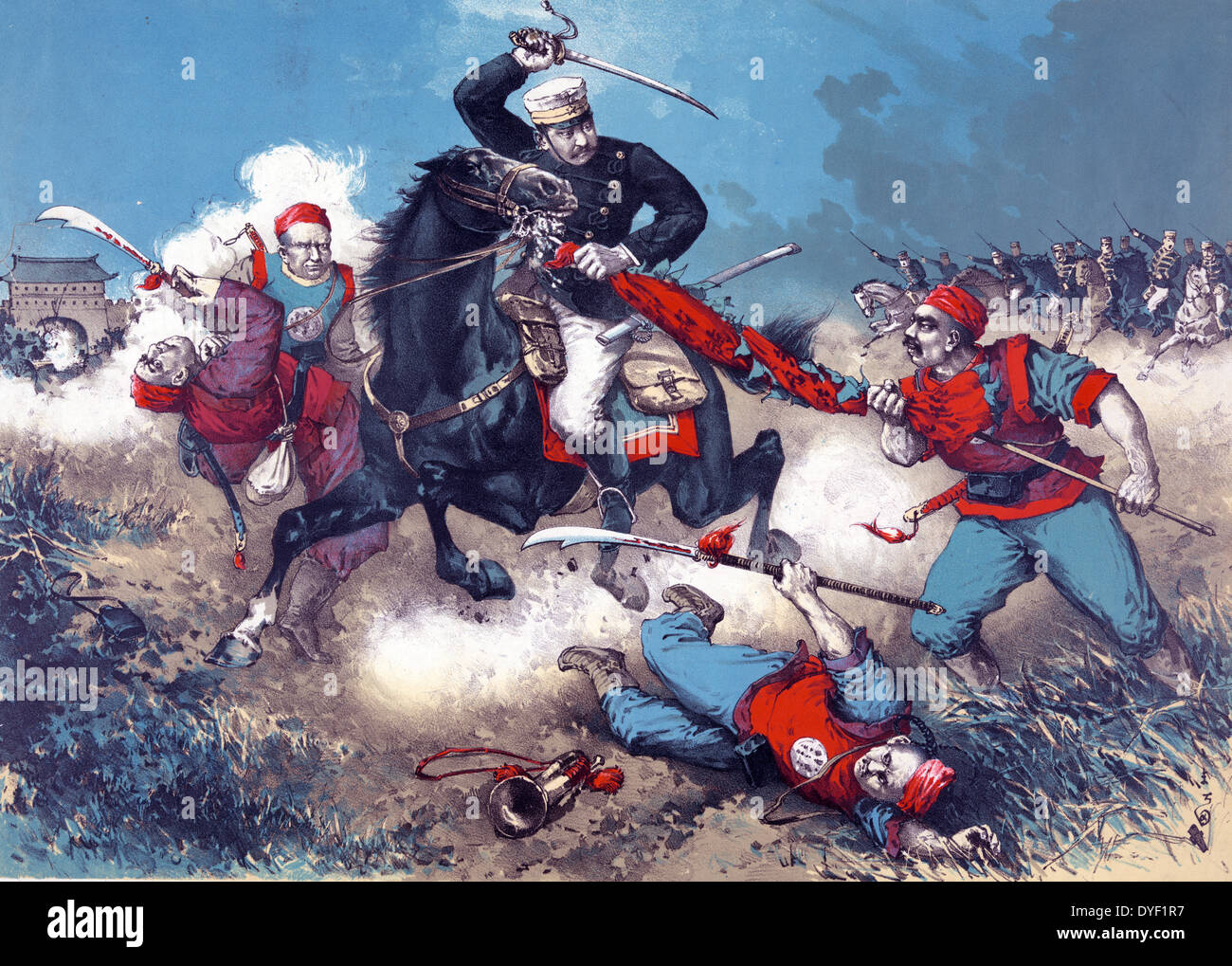 The Japanese cavalry advancing through fields toward a walled city in China by Ishimatsu Nakajima, Japanese artist 1900. Print shows a Japanese soldier on horseback engaging four Boxer troops as the cavalry crashed through a field outside a walled city in China. Stock Photohttps://www.alamy.com/image-license-details/?v=1https://www.alamy.com/the-japanese-cavalry-advancing-through-fields-toward-a-walled-city-image68557531.html
The Japanese cavalry advancing through fields toward a walled city in China by Ishimatsu Nakajima, Japanese artist 1900. Print shows a Japanese soldier on horseback engaging four Boxer troops as the cavalry crashed through a field outside a walled city in China. Stock Photohttps://www.alamy.com/image-license-details/?v=1https://www.alamy.com/the-japanese-cavalry-advancing-through-fields-toward-a-walled-city-image68557531.htmlRMDYF1R7–The Japanese cavalry advancing through fields toward a walled city in China by Ishimatsu Nakajima, Japanese artist 1900. Print shows a Japanese soldier on horseback engaging four Boxer troops as the cavalry crashed through a field outside a walled city in China.
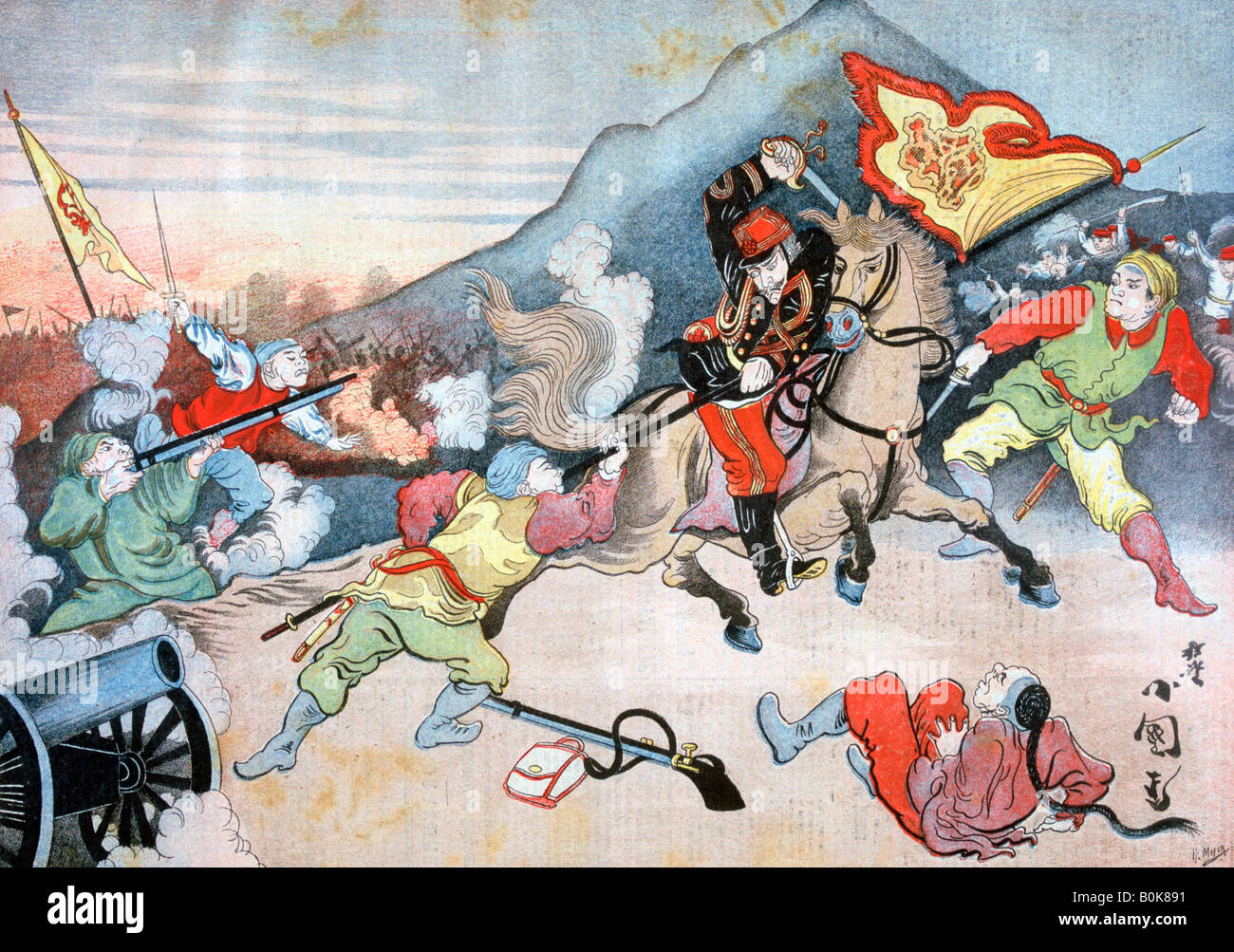 The Taking of the Chinese Flag by a Japanese Officer, 1894. Artist: Henri Meyer Stock Photohttps://www.alamy.com/image-license-details/?v=1https://www.alamy.com/stock-photo-the-taking-of-the-chinese-flag-by-a-japanese-officer-1894-artist-henri-17633981.html
The Taking of the Chinese Flag by a Japanese Officer, 1894. Artist: Henri Meyer Stock Photohttps://www.alamy.com/image-license-details/?v=1https://www.alamy.com/stock-photo-the-taking-of-the-chinese-flag-by-a-japanese-officer-1894-artist-henri-17633981.htmlRMB0K891–The Taking of the Chinese Flag by a Japanese Officer, 1894. Artist: Henri Meyer
 Arabs on horseback fleeing toward left. At right, a group of soldiers. Pen and ink, brush and sepia wash, brush and Chinese white on paper. Date: 1835-1840. Museum: Cooper Hewitt, Smithsonian Design Museum. Stock Photohttps://www.alamy.com/image-license-details/?v=1https://www.alamy.com/arabs-on-horseback-fleeing-toward-left-at-right-a-group-of-soldiers-pen-and-ink-brush-and-sepia-wash-brush-and-chinese-white-on-paper-date-1835-1840-museum-cooper-hewitt-smithsonian-design-museum-image554750735.html
Arabs on horseback fleeing toward left. At right, a group of soldiers. Pen and ink, brush and sepia wash, brush and Chinese white on paper. Date: 1835-1840. Museum: Cooper Hewitt, Smithsonian Design Museum. Stock Photohttps://www.alamy.com/image-license-details/?v=1https://www.alamy.com/arabs-on-horseback-fleeing-toward-left-at-right-a-group-of-soldiers-pen-and-ink-brush-and-sepia-wash-brush-and-chinese-white-on-paper-date-1835-1840-museum-cooper-hewitt-smithsonian-design-museum-image554750735.htmlRM2R6F267–Arabs on horseback fleeing toward left. At right, a group of soldiers. Pen and ink, brush and sepia wash, brush and Chinese white on paper. Date: 1835-1840. Museum: Cooper Hewitt, Smithsonian Design Museum.
 Mongol cavalry and infantry, Mongolia. Asia. Trip to Mongolia by Nikolai Mijailovich Przewalski in 1870-1873, Le Tour du Monde 1877 Stock Photohttps://www.alamy.com/image-license-details/?v=1https://www.alamy.com/mongol-cavalry-and-infantry-mongolia-asia-trip-to-mongolia-by-nikolai-mijailovich-przewalski-in-1870-1873-le-tour-du-monde-1877-image464893051.html
Mongol cavalry and infantry, Mongolia. Asia. Trip to Mongolia by Nikolai Mijailovich Przewalski in 1870-1873, Le Tour du Monde 1877 Stock Photohttps://www.alamy.com/image-license-details/?v=1https://www.alamy.com/mongol-cavalry-and-infantry-mongolia-asia-trip-to-mongolia-by-nikolai-mijailovich-przewalski-in-1870-1873-le-tour-du-monde-1877-image464893051.htmlRM2J09KR7–Mongol cavalry and infantry, Mongolia. Asia. Trip to Mongolia by Nikolai Mijailovich Przewalski in 1870-1873, Le Tour du Monde 1877
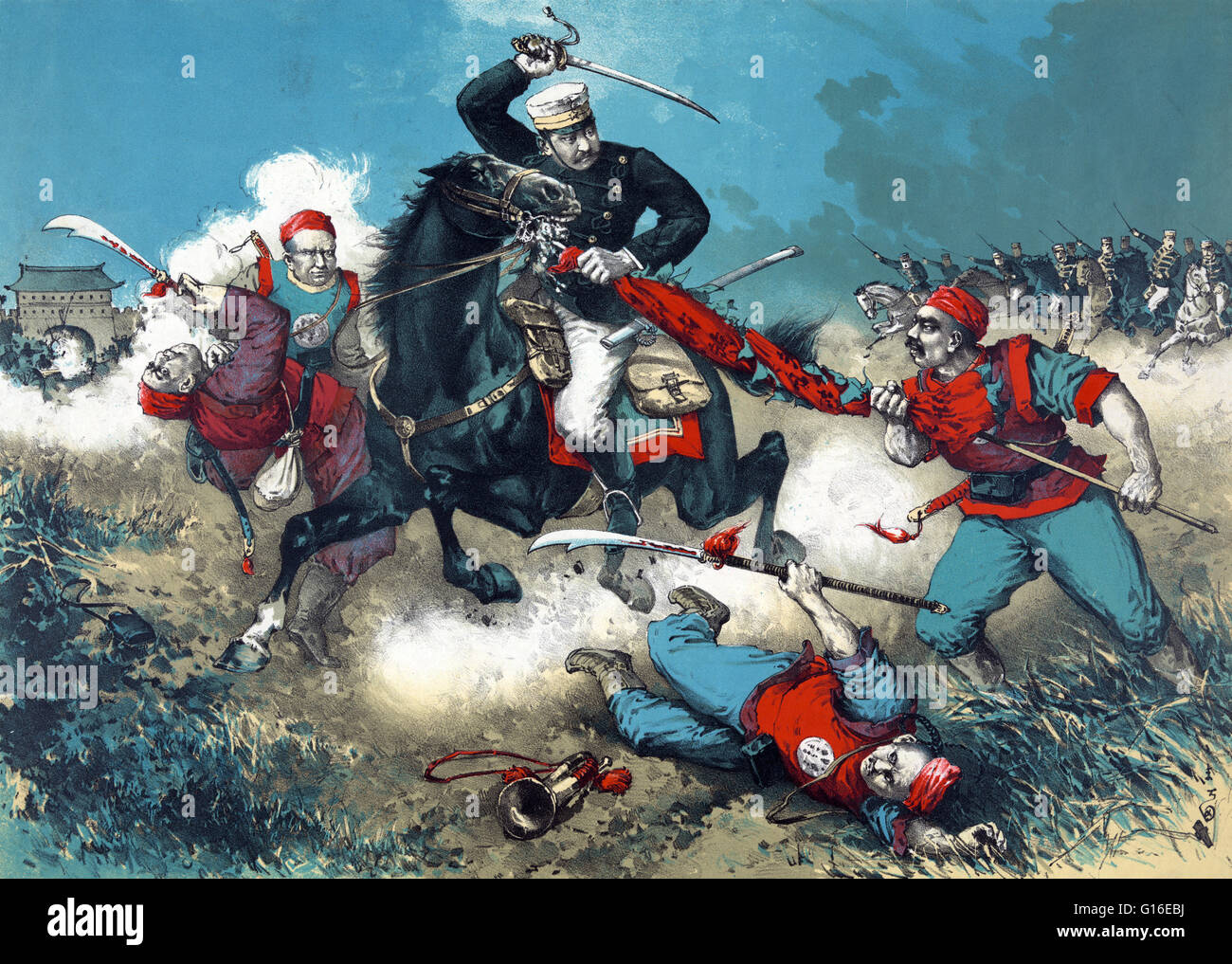 Entitled: 'The Japanese cavalry advancing through fields toward a walled city in China.' Shows a Japanese soldier on horseback engaging four Boxer troops as the cavalry crashed through a field outside a walled city in China. The Battle of Tientsin occurre Stock Photohttps://www.alamy.com/image-license-details/?v=1https://www.alamy.com/stock-photo-entitled-the-japanese-cavalry-advancing-through-fields-toward-a-walled-104019878.html
Entitled: 'The Japanese cavalry advancing through fields toward a walled city in China.' Shows a Japanese soldier on horseback engaging four Boxer troops as the cavalry crashed through a field outside a walled city in China. The Battle of Tientsin occurre Stock Photohttps://www.alamy.com/image-license-details/?v=1https://www.alamy.com/stock-photo-entitled-the-japanese-cavalry-advancing-through-fields-toward-a-walled-104019878.htmlRMG16EBJ–Entitled: 'The Japanese cavalry advancing through fields toward a walled city in China.' Shows a Japanese soldier on horseback engaging four Boxer troops as the cavalry crashed through a field outside a walled city in China. The Battle of Tientsin occurre
 Emperor Wilhelm II (center on horseback) takes the report of Chinese officers in German service in Kassel. Stock Photohttps://www.alamy.com/image-license-details/?v=1https://www.alamy.com/emperor-wilhelm-ii-center-on-horseback-takes-the-report-of-chinese-officers-in-german-service-in-kassel-image345686999.html
Emperor Wilhelm II (center on horseback) takes the report of Chinese officers in German service in Kassel. Stock Photohttps://www.alamy.com/image-license-details/?v=1https://www.alamy.com/emperor-wilhelm-ii-center-on-horseback-takes-the-report-of-chinese-officers-in-german-service-in-kassel-image345686999.htmlRM2B2BB87–Emperor Wilhelm II (center on horseback) takes the report of Chinese officers in German service in Kassel.
 Japanese soldier on horseback engaging four Boxer troops as the cavalry crashed through a field outside a walled city in China. Stock Photohttps://www.alamy.com/image-license-details/?v=1https://www.alamy.com/japanese-soldier-on-horseback-engaging-four-boxer-troops-as-the-cavalry-crashed-through-a-field-outside-a-walled-city-in-china-image179715655.html
Japanese soldier on horseback engaging four Boxer troops as the cavalry crashed through a field outside a walled city in China. Stock Photohttps://www.alamy.com/image-license-details/?v=1https://www.alamy.com/japanese-soldier-on-horseback-engaging-four-boxer-troops-as-the-cavalry-crashed-through-a-field-outside-a-walled-city-in-china-image179715655.htmlRMMCAN47–Japanese soldier on horseback engaging four Boxer troops as the cavalry crashed through a field outside a walled city in China.
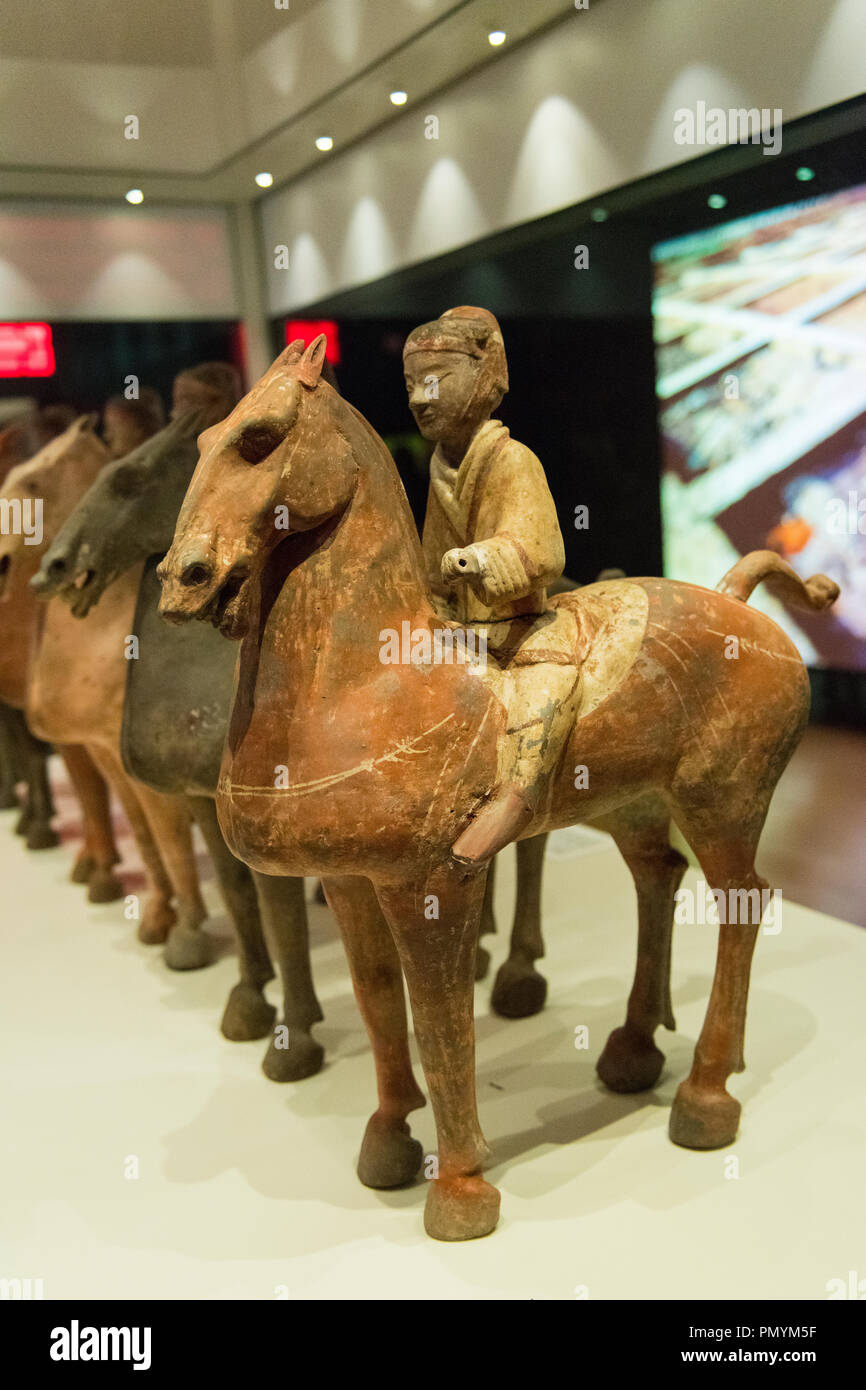 Liverpool William Brown Street World Museum China's First Emperor & The Terracotta Warriors Exhibition small soldiers on horseback Stock Photohttps://www.alamy.com/image-license-details/?v=1https://www.alamy.com/liverpool-william-brown-street-world-museum-chinas-first-emperor-the-terracotta-warriors-exhibition-small-soldiers-on-horseback-image219426075.html
Liverpool William Brown Street World Museum China's First Emperor & The Terracotta Warriors Exhibition small soldiers on horseback Stock Photohttps://www.alamy.com/image-license-details/?v=1https://www.alamy.com/liverpool-william-brown-street-world-museum-chinas-first-emperor-the-terracotta-warriors-exhibition-small-soldiers-on-horseback-image219426075.htmlRMPMYM5F–Liverpool William Brown Street World Museum China's First Emperor & The Terracotta Warriors Exhibition small soldiers on horseback
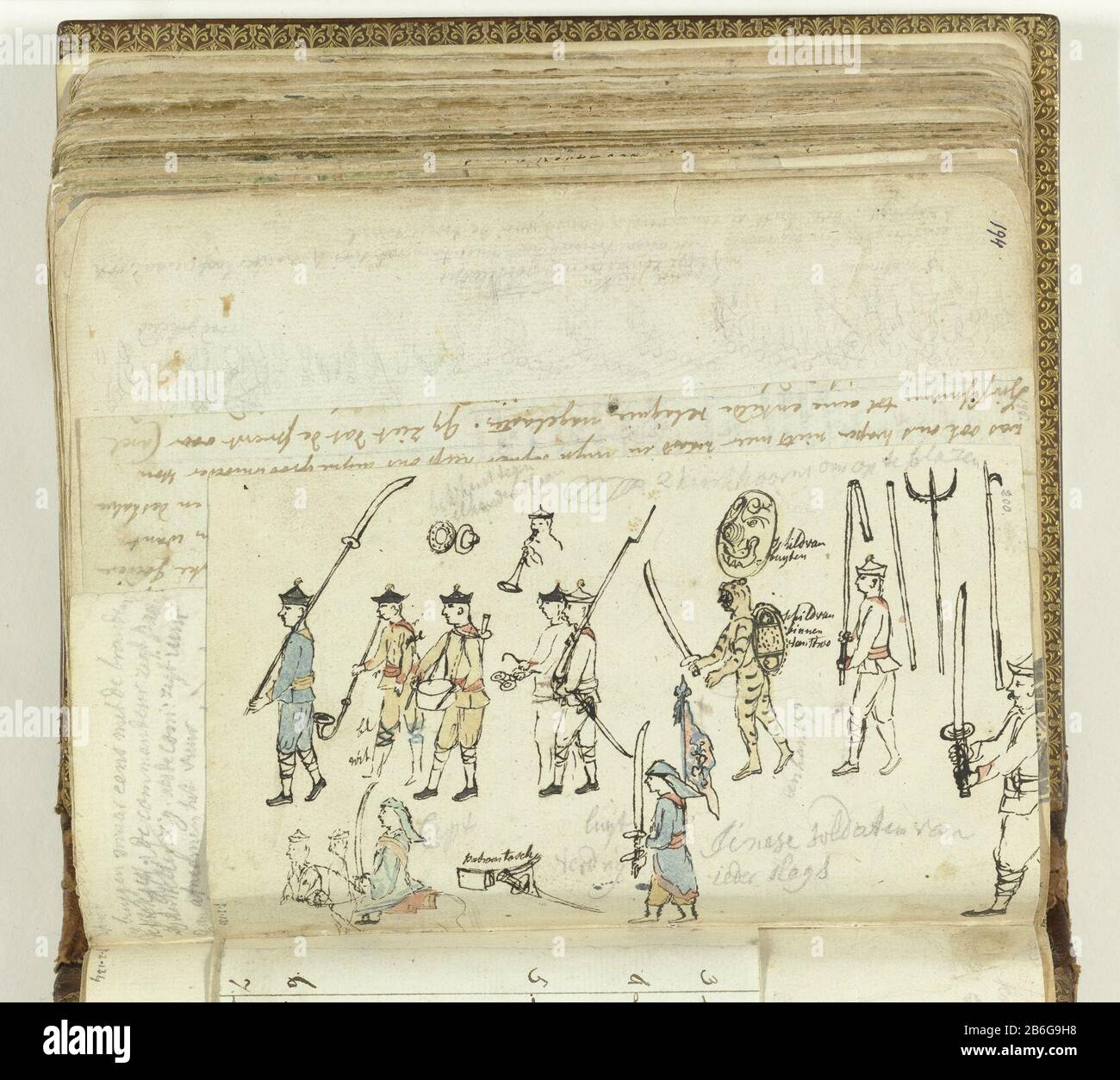 Chinese soldaten Color Drawing and ink drawing of Chinese soldiers as a parade. Bottom left the Chinese captain with saber on horseback. One soldier is dressed in tiger skin. They wear spikes, guns, shields, drums and sabers. With inscription. Part of the sketchbook of Jan Brandes, Vol. 2 (1808), p. 200. Manufacturer : artist: Jan BrandesPlaats manufacture: Jakarta Dating: 23 Feb 1779-26 Aug 1785 Physical features: watercolor on sketch in pencil, paintbrush color material: paper Technique: Brush / pen Dimensions: H 100 mm × W 162 mm Date: 1797 - 1785 Stock Photohttps://www.alamy.com/image-license-details/?v=1https://www.alamy.com/chinese-soldaten-color-drawing-and-ink-drawing-of-chinese-soldiers-as-a-parade-bottom-left-the-chinese-captain-with-saber-on-horseback-one-soldier-is-dressed-in-tiger-skin-they-wear-spikes-guns-shields-drums-and-sabers-with-inscription-part-of-the-sketchbook-of-jan-brandes-vol-2-1808-p-200-manufacturer-artist-jan-brandesplaats-manufacture-jakarta-dating-23-feb-1779-26-aug-1785-physical-features-watercolor-on-sketch-in-pencil-paintbrush-color-material-paper-technique-brush-pen-dimensions-h-100-mm-w-162-mm-date-1797-1785-image348254068.html
Chinese soldaten Color Drawing and ink drawing of Chinese soldiers as a parade. Bottom left the Chinese captain with saber on horseback. One soldier is dressed in tiger skin. They wear spikes, guns, shields, drums and sabers. With inscription. Part of the sketchbook of Jan Brandes, Vol. 2 (1808), p. 200. Manufacturer : artist: Jan BrandesPlaats manufacture: Jakarta Dating: 23 Feb 1779-26 Aug 1785 Physical features: watercolor on sketch in pencil, paintbrush color material: paper Technique: Brush / pen Dimensions: H 100 mm × W 162 mm Date: 1797 - 1785 Stock Photohttps://www.alamy.com/image-license-details/?v=1https://www.alamy.com/chinese-soldaten-color-drawing-and-ink-drawing-of-chinese-soldiers-as-a-parade-bottom-left-the-chinese-captain-with-saber-on-horseback-one-soldier-is-dressed-in-tiger-skin-they-wear-spikes-guns-shields-drums-and-sabers-with-inscription-part-of-the-sketchbook-of-jan-brandes-vol-2-1808-p-200-manufacturer-artist-jan-brandesplaats-manufacture-jakarta-dating-23-feb-1779-26-aug-1785-physical-features-watercolor-on-sketch-in-pencil-paintbrush-color-material-paper-technique-brush-pen-dimensions-h-100-mm-w-162-mm-date-1797-1785-image348254068.htmlRM2B6G9H8–Chinese soldaten Color Drawing and ink drawing of Chinese soldiers as a parade. Bottom left the Chinese captain with saber on horseback. One soldier is dressed in tiger skin. They wear spikes, guns, shields, drums and sabers. With inscription. Part of the sketchbook of Jan Brandes, Vol. 2 (1808), p. 200. Manufacturer : artist: Jan BrandesPlaats manufacture: Jakarta Dating: 23 Feb 1779-26 Aug 1785 Physical features: watercolor on sketch in pencil, paintbrush color material: paper Technique: Brush / pen Dimensions: H 100 mm × W 162 mm Date: 1797 - 1785
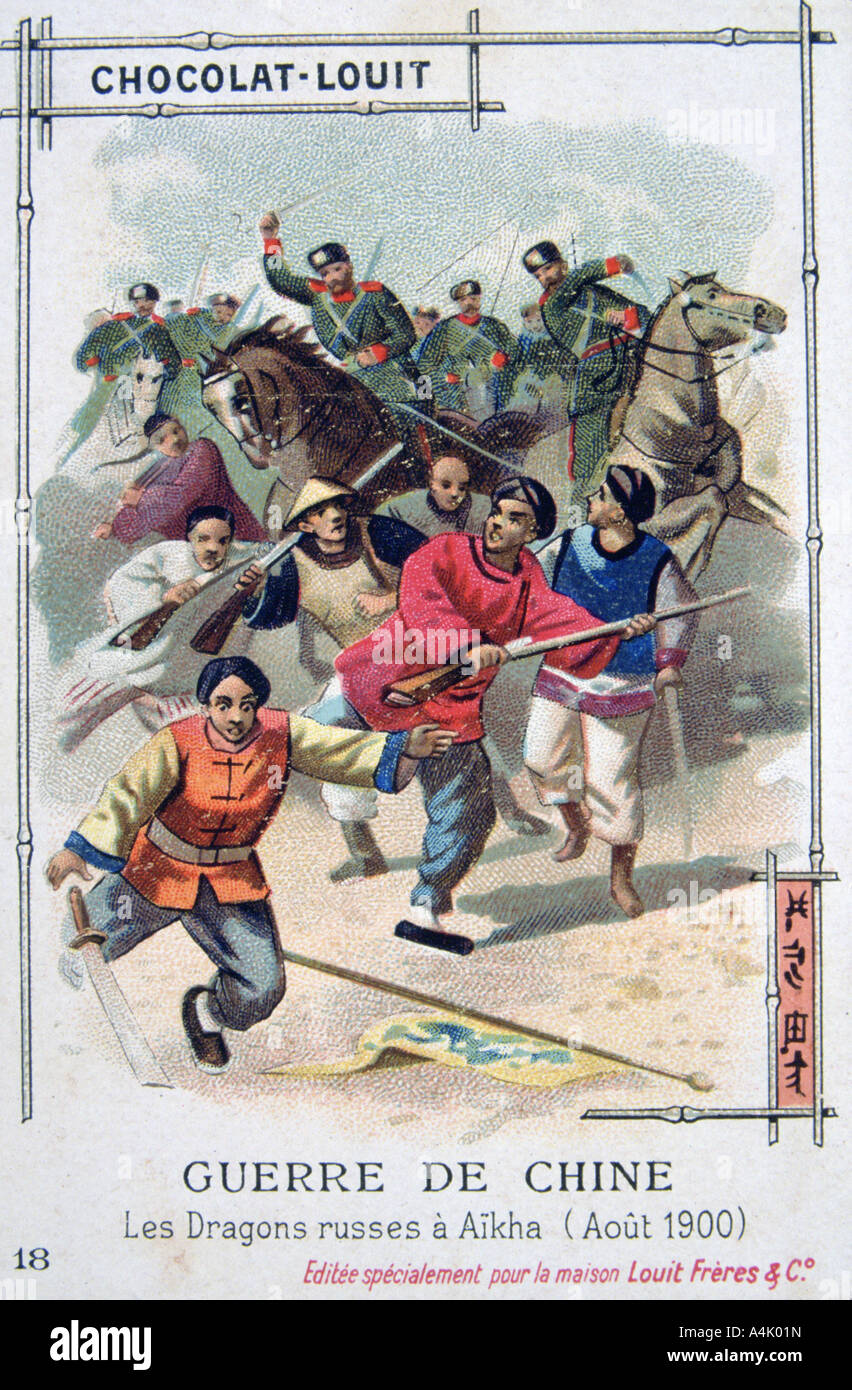 The Russian Dragoons at Aikha, China, Boxer Rebellion, August 1900. Artist: Unknown Stock Photohttps://www.alamy.com/image-license-details/?v=1https://www.alamy.com/stock-photo-the-russian-dragoons-at-aikha-china-boxer-rebellion-august-1900-artist-11066960.html
The Russian Dragoons at Aikha, China, Boxer Rebellion, August 1900. Artist: Unknown Stock Photohttps://www.alamy.com/image-license-details/?v=1https://www.alamy.com/stock-photo-the-russian-dragoons-at-aikha-china-boxer-rebellion-august-1900-artist-11066960.htmlRMA4K01N–The Russian Dragoons at Aikha, China, Boxer Rebellion, August 1900. Artist: Unknown
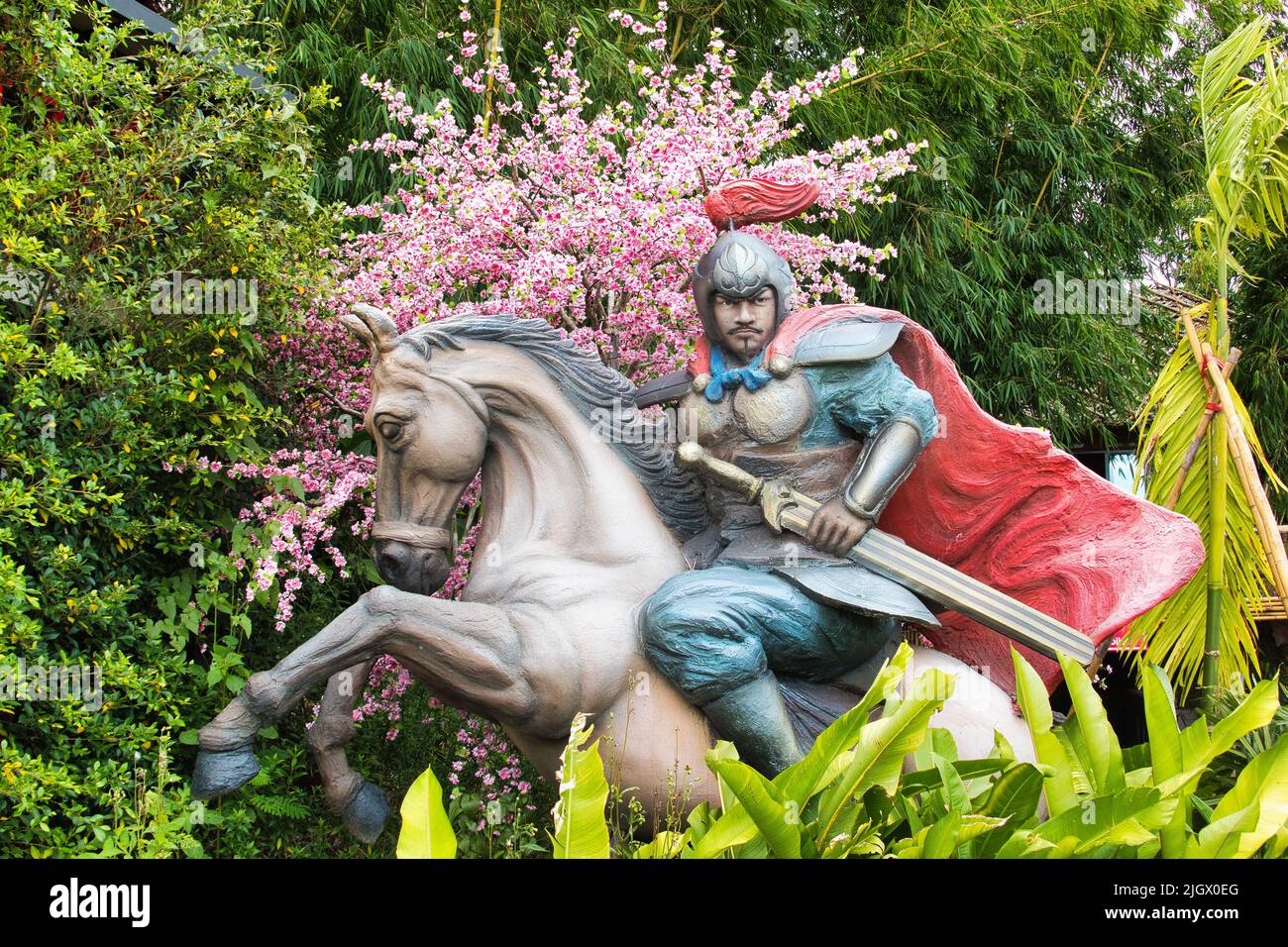 Painted statue of a warrior on horseback, at the complex Liangshan Khaokho in Khao Kho, Phetchabun, Thailand, against a background of cherry blossom. Stock Photohttps://www.alamy.com/image-license-details/?v=1https://www.alamy.com/painted-statue-of-a-warrior-on-horseback-at-the-complex-liangshan-khaokho-in-khao-kho-phetchabun-thailand-against-a-background-of-cherry-blossom-image475085592.html
Painted statue of a warrior on horseback, at the complex Liangshan Khaokho in Khao Kho, Phetchabun, Thailand, against a background of cherry blossom. Stock Photohttps://www.alamy.com/image-license-details/?v=1https://www.alamy.com/painted-statue-of-a-warrior-on-horseback-at-the-complex-liangshan-khaokho-in-khao-kho-phetchabun-thailand-against-a-background-of-cherry-blossom-image475085592.htmlRF2JGX0EG–Painted statue of a warrior on horseback, at the complex Liangshan Khaokho in Khao Kho, Phetchabun, Thailand, against a background of cherry blossom.
 A Chinese soldier bearing a rifle, on horseback. Watercolour by C. Wirgman, ca. 1857. Stock Photohttps://www.alamy.com/image-license-details/?v=1https://www.alamy.com/a-chinese-soldier-bearing-a-rifle-on-horseback-watercolour-by-c-wirgman-ca-1857-image450105625.html
A Chinese soldier bearing a rifle, on horseback. Watercolour by C. Wirgman, ca. 1857. Stock Photohttps://www.alamy.com/image-license-details/?v=1https://www.alamy.com/a-chinese-soldier-bearing-a-rifle-on-horseback-watercolour-by-c-wirgman-ca-1857-image450105625.htmlRM2H4828W–A Chinese soldier bearing a rifle, on horseback. Watercolour by C. Wirgman, ca. 1857.
 The Manchu army takes Liaoyang. Manzhou shilu. Shenyang, 1930. Nurhaci on horseback and attended by soldiers carrying elaborate canopies, supervises the attack on the city of Liaoyang, Liaoyang province. A facsimile of the 1781 edition of the Manzhou shilu, illustrated description of the life of Nurhaci (1559-1626), whose descendants completed the conquest of China and the establishment of the Qing dynasty, 1644-1911. Image taken from Manzhou shilu. Originally published/produced in Shenyang, 1930. . Source: 15529.a.1.(7), p.5. Language: Chinese. Stock Photohttps://www.alamy.com/image-license-details/?v=1https://www.alamy.com/the-manchu-army-takes-liaoyang-manzhou-shilu-shenyang-1930-nurhaci-on-horseback-and-attended-by-soldiers-carrying-elaborate-canopies-supervises-the-attack-on-the-city-of-liaoyang-liaoyang-province-a-facsimile-of-the-1781-edition-of-the-manzhou-shilu-illustrated-description-of-the-life-of-nurhaci-1559-1626-whose-descendants-completed-the-conquest-of-china-and-the-establishment-of-the-qing-dynasty-1644-1911-image-taken-from-manzhou-shilu-originally-publishedproduced-in-shenyang-1930-source-15529a17-p5-language-chinese-image226822494.html
The Manchu army takes Liaoyang. Manzhou shilu. Shenyang, 1930. Nurhaci on horseback and attended by soldiers carrying elaborate canopies, supervises the attack on the city of Liaoyang, Liaoyang province. A facsimile of the 1781 edition of the Manzhou shilu, illustrated description of the life of Nurhaci (1559-1626), whose descendants completed the conquest of China and the establishment of the Qing dynasty, 1644-1911. Image taken from Manzhou shilu. Originally published/produced in Shenyang, 1930. . Source: 15529.a.1.(7), p.5. Language: Chinese. Stock Photohttps://www.alamy.com/image-license-details/?v=1https://www.alamy.com/the-manchu-army-takes-liaoyang-manzhou-shilu-shenyang-1930-nurhaci-on-horseback-and-attended-by-soldiers-carrying-elaborate-canopies-supervises-the-attack-on-the-city-of-liaoyang-liaoyang-province-a-facsimile-of-the-1781-edition-of-the-manzhou-shilu-illustrated-description-of-the-life-of-nurhaci-1559-1626-whose-descendants-completed-the-conquest-of-china-and-the-establishment-of-the-qing-dynasty-1644-1911-image-taken-from-manzhou-shilu-originally-publishedproduced-in-shenyang-1930-source-15529a17-p5-language-chinese-image226822494.htmlRMR50JBA–The Manchu army takes Liaoyang. Manzhou shilu. Shenyang, 1930. Nurhaci on horseback and attended by soldiers carrying elaborate canopies, supervises the attack on the city of Liaoyang, Liaoyang province. A facsimile of the 1781 edition of the Manzhou shilu, illustrated description of the life of Nurhaci (1559-1626), whose descendants completed the conquest of China and the establishment of the Qing dynasty, 1644-1911. Image taken from Manzhou shilu. Originally published/produced in Shenyang, 1930. . Source: 15529.a.1.(7), p.5. Language: Chinese.
 The Chinese prince Zaitao drives in an open carriage in a parade. Stock Photohttps://www.alamy.com/image-license-details/?v=1https://www.alamy.com/the-chinese-prince-zaitao-drives-in-an-open-carriage-in-a-parade-image345687012.html
The Chinese prince Zaitao drives in an open carriage in a parade. Stock Photohttps://www.alamy.com/image-license-details/?v=1https://www.alamy.com/the-chinese-prince-zaitao-drives-in-an-open-carriage-in-a-parade-image345687012.htmlRM2B2BB8M–The Chinese prince Zaitao drives in an open carriage in a parade.
 Sino-Japanese war Chinese irregular troops from the interior on the march . 1 September 1894 Stock Photohttps://www.alamy.com/image-license-details/?v=1https://www.alamy.com/sino-japanese-war-chinese-irregular-troops-from-the-interior-on-the-march-1-september-1894-image623925322.html
Sino-Japanese war Chinese irregular troops from the interior on the march . 1 September 1894 Stock Photohttps://www.alamy.com/image-license-details/?v=1https://www.alamy.com/sino-japanese-war-chinese-irregular-troops-from-the-interior-on-the-march-1-september-1894-image623925322.htmlRM2Y72736–Sino-Japanese war Chinese irregular troops from the interior on the march . 1 September 1894
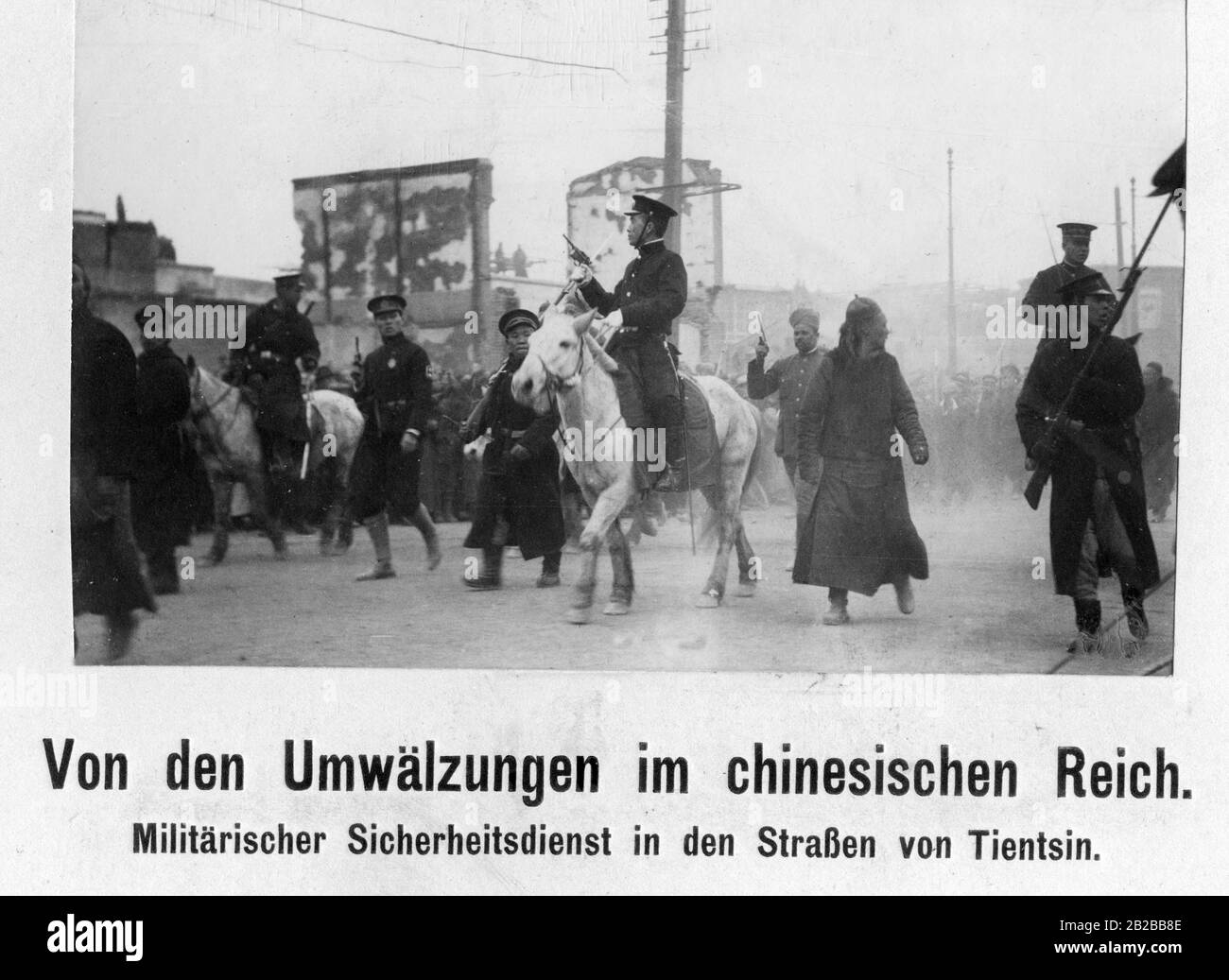 A group of armed men pulls through a street in Tianjin during the Chinese Revolution. Stock Photohttps://www.alamy.com/image-license-details/?v=1https://www.alamy.com/a-group-of-armed-men-pulls-through-a-street-in-tianjin-during-the-chinese-revolution-image345687006.html
A group of armed men pulls through a street in Tianjin during the Chinese Revolution. Stock Photohttps://www.alamy.com/image-license-details/?v=1https://www.alamy.com/a-group-of-armed-men-pulls-through-a-street-in-tianjin-during-the-chinese-revolution-image345687006.htmlRM2B2BB8E–A group of armed men pulls through a street in Tianjin during the Chinese Revolution.
 Woodcut illustration shows the allied armies advancing toward the Boxer forces outside the imperial castle in Beijing, China. Stock Photohttps://www.alamy.com/image-license-details/?v=1https://www.alamy.com/woodcut-illustration-shows-the-allied-armies-advancing-toward-the-boxer-forces-outside-the-imperial-castle-in-beijing-china-image483536363.html
Woodcut illustration shows the allied armies advancing toward the Boxer forces outside the imperial castle in Beijing, China. Stock Photohttps://www.alamy.com/image-license-details/?v=1https://www.alamy.com/woodcut-illustration-shows-the-allied-armies-advancing-toward-the-boxer-forces-outside-the-imperial-castle-in-beijing-china-image483536363.htmlRM2K2JYFR–Woodcut illustration shows the allied armies advancing toward the Boxer forces outside the imperial castle in Beijing, China.
 Vietnam: A Vietnamese portrayal of the French Capture of Hung Hoa (12 April 1884). Illustration, c. 1884. The Capture of Hung Hoa was an important French victory in the Tonkin Campaign, due to the town's strategic importance. The Tonkin Campaign (French: Campagne du Tonkin) was an armed conflict fought between June 1883 and April 1886 by the French against, variously, the Vietnamese, Liu Yongfu's Black Flag Army and the Chinese Guangxi and Yunnan armies to occupy Tonkin (northern Vietnam) and entrench a French protectorate there. Stock Photohttps://www.alamy.com/image-license-details/?v=1https://www.alamy.com/vietnam-a-vietnamese-portrayal-of-the-french-capture-of-hung-hoa-12-april-1884-illustration-c-1884-the-capture-of-hung-hoa-was-an-important-french-victory-in-the-tonkin-campaign-due-to-the-towns-strategic-importance-the-tonkin-campaign-french-campagne-du-tonkin-was-an-armed-conflict-fought-between-june-1883-and-april-1886-by-the-french-against-variously-the-vietnamese-liu-yongfus-black-flag-army-and-the-chinese-guangxi-and-yunnan-armies-to-occupy-tonkin-northern-vietnam-and-entrench-a-french-protectorate-there-image344239518.html
Vietnam: A Vietnamese portrayal of the French Capture of Hung Hoa (12 April 1884). Illustration, c. 1884. The Capture of Hung Hoa was an important French victory in the Tonkin Campaign, due to the town's strategic importance. The Tonkin Campaign (French: Campagne du Tonkin) was an armed conflict fought between June 1883 and April 1886 by the French against, variously, the Vietnamese, Liu Yongfu's Black Flag Army and the Chinese Guangxi and Yunnan armies to occupy Tonkin (northern Vietnam) and entrench a French protectorate there. Stock Photohttps://www.alamy.com/image-license-details/?v=1https://www.alamy.com/vietnam-a-vietnamese-portrayal-of-the-french-capture-of-hung-hoa-12-april-1884-illustration-c-1884-the-capture-of-hung-hoa-was-an-important-french-victory-in-the-tonkin-campaign-due-to-the-towns-strategic-importance-the-tonkin-campaign-french-campagne-du-tonkin-was-an-armed-conflict-fought-between-june-1883-and-april-1886-by-the-french-against-variously-the-vietnamese-liu-yongfus-black-flag-army-and-the-chinese-guangxi-and-yunnan-armies-to-occupy-tonkin-northern-vietnam-and-entrench-a-french-protectorate-there-image344239518.htmlRM2B01D0E–Vietnam: A Vietnamese portrayal of the French Capture of Hung Hoa (12 April 1884). Illustration, c. 1884. The Capture of Hung Hoa was an important French victory in the Tonkin Campaign, due to the town's strategic importance. The Tonkin Campaign (French: Campagne du Tonkin) was an armed conflict fought between June 1883 and April 1886 by the French against, variously, the Vietnamese, Liu Yongfu's Black Flag Army and the Chinese Guangxi and Yunnan armies to occupy Tonkin (northern Vietnam) and entrench a French protectorate there.
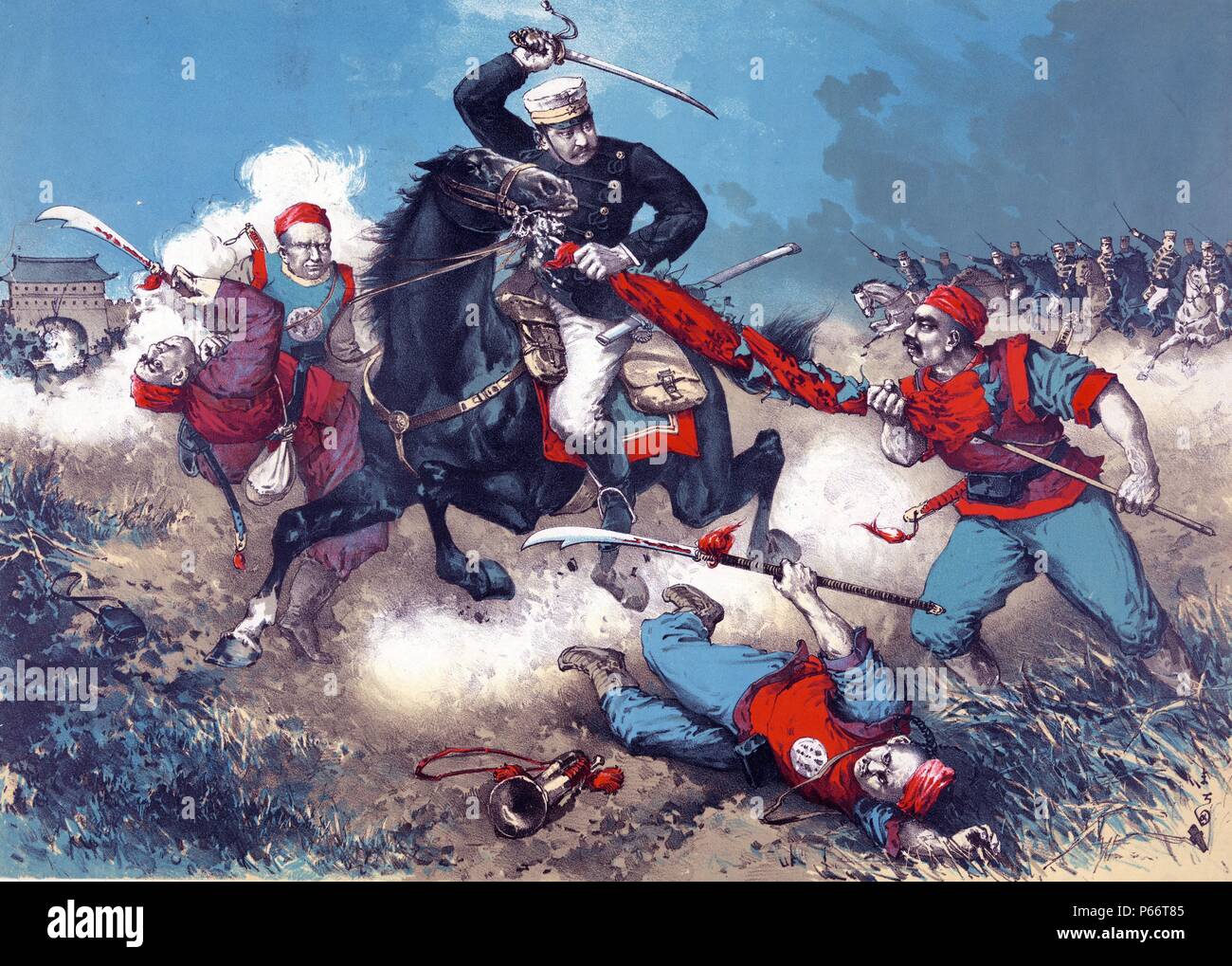 The Japanese cavalry advancing through fields toward a walled city in China by Ishimatsu Nakajima, Japanese artist 1900. Print shows a Japanese soldier on horseback engaging four Boxer troops as the cavalry crashed through a field outside a walled city in China. Stock Photohttps://www.alamy.com/image-license-details/?v=1https://www.alamy.com/the-japanese-cavalry-advancing-through-fields-toward-a-walled-city-in-china-by-ishimatsu-nakajima-japanese-artist-1900-print-shows-a-japanese-soldier-on-horseback-engaging-four-boxer-troops-as-the-cavalry-crashed-through-a-field-outside-a-walled-city-in-china-image210363109.html
The Japanese cavalry advancing through fields toward a walled city in China by Ishimatsu Nakajima, Japanese artist 1900. Print shows a Japanese soldier on horseback engaging four Boxer troops as the cavalry crashed through a field outside a walled city in China. Stock Photohttps://www.alamy.com/image-license-details/?v=1https://www.alamy.com/the-japanese-cavalry-advancing-through-fields-toward-a-walled-city-in-china-by-ishimatsu-nakajima-japanese-artist-1900-print-shows-a-japanese-soldier-on-horseback-engaging-four-boxer-troops-as-the-cavalry-crashed-through-a-field-outside-a-walled-city-in-china-image210363109.htmlRMP66T85–The Japanese cavalry advancing through fields toward a walled city in China by Ishimatsu Nakajima, Japanese artist 1900. Print shows a Japanese soldier on horseback engaging four Boxer troops as the cavalry crashed through a field outside a walled city in China.
 A Chinese general pulls on a branch of a cherry tree, A soldier on horseback, probably Han Yun, with attendant pulls on a branch of cherry tree in bloom. To the right, a large, red sun. Below left is a goat (reference to the year of the goat 1835)., maker: Totoya Hokkei, (mentioned on object), 1835, paper, height 210 mm × width 182 mm Stock Photohttps://www.alamy.com/image-license-details/?v=1https://www.alamy.com/a-chinese-general-pulls-on-a-branch-of-a-cherry-tree-a-soldier-on-horseback-probably-han-yun-with-attendant-pulls-on-a-branch-of-cherry-tree-in-bloom-to-the-right-a-large-red-sun-below-left-is-a-goat-reference-to-the-year-of-the-goat-1835-maker-totoya-hokkei-mentioned-on-object-1835-paper-height-210-mm-width-182-mm-image473268384.html
A Chinese general pulls on a branch of a cherry tree, A soldier on horseback, probably Han Yun, with attendant pulls on a branch of cherry tree in bloom. To the right, a large, red sun. Below left is a goat (reference to the year of the goat 1835)., maker: Totoya Hokkei, (mentioned on object), 1835, paper, height 210 mm × width 182 mm Stock Photohttps://www.alamy.com/image-license-details/?v=1https://www.alamy.com/a-chinese-general-pulls-on-a-branch-of-a-cherry-tree-a-soldier-on-horseback-probably-han-yun-with-attendant-pulls-on-a-branch-of-cherry-tree-in-bloom-to-the-right-a-large-red-sun-below-left-is-a-goat-reference-to-the-year-of-the-goat-1835-maker-totoya-hokkei-mentioned-on-object-1835-paper-height-210-mm-width-182-mm-image473268384.htmlRM2JDY6J8–A Chinese general pulls on a branch of a cherry tree, A soldier on horseback, probably Han Yun, with attendant pulls on a branch of cherry tree in bloom. To the right, a large, red sun. Below left is a goat (reference to the year of the goat 1835)., maker: Totoya Hokkei, (mentioned on object), 1835, paper, height 210 mm × width 182 mm
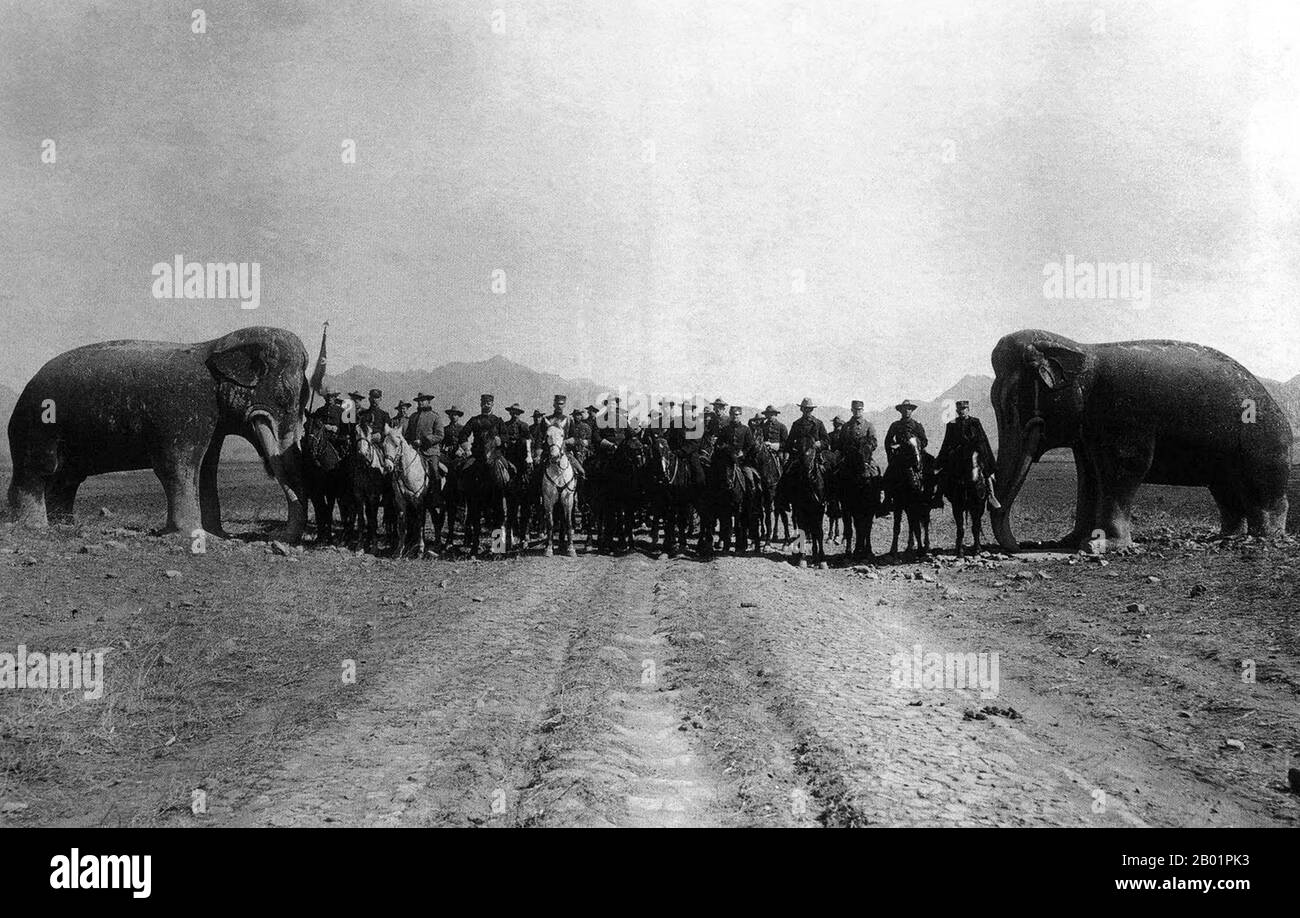 China/USA: Elements of the US 6th Cavalry at the Ming Tombs outside Beijing. Boxer Rebellion, c. 1901. The Boxer Rebellion, also known as Boxer Uprising or Yihetuan Movement, was a proto-nationalist movement by the 'Righteous Harmony Society' in China between 1898 and 1901, opposing foreign imperialism and Christianity. The uprising took place in response to foreign 'spheres of influence' in China, with grievances ranging from opium traders, political invasion, economic manipulation, to missionary evangelism. In China, popular sentiment remained resistant to foreign influences. Stock Photohttps://www.alamy.com/image-license-details/?v=1https://www.alamy.com/chinausa-elements-of-the-us-6th-cavalry-at-the-ming-tombs-outside-beijing-boxer-rebellion-c-1901-the-boxer-rebellion-also-known-as-boxer-uprising-or-yihetuan-movement-was-a-proto-nationalist-movement-by-the-righteous-harmony-society-in-china-between-1898-and-1901-opposing-foreign-imperialism-and-christianity-the-uprising-took-place-in-response-to-foreign-spheres-of-influence-in-china-with-grievances-ranging-from-opium-traders-political-invasion-economic-manipulation-to-missionary-evangelism-in-china-popular-sentiment-remained-resistant-to-foreign-influences-image344247095.html
China/USA: Elements of the US 6th Cavalry at the Ming Tombs outside Beijing. Boxer Rebellion, c. 1901. The Boxer Rebellion, also known as Boxer Uprising or Yihetuan Movement, was a proto-nationalist movement by the 'Righteous Harmony Society' in China between 1898 and 1901, opposing foreign imperialism and Christianity. The uprising took place in response to foreign 'spheres of influence' in China, with grievances ranging from opium traders, political invasion, economic manipulation, to missionary evangelism. In China, popular sentiment remained resistant to foreign influences. Stock Photohttps://www.alamy.com/image-license-details/?v=1https://www.alamy.com/chinausa-elements-of-the-us-6th-cavalry-at-the-ming-tombs-outside-beijing-boxer-rebellion-c-1901-the-boxer-rebellion-also-known-as-boxer-uprising-or-yihetuan-movement-was-a-proto-nationalist-movement-by-the-righteous-harmony-society-in-china-between-1898-and-1901-opposing-foreign-imperialism-and-christianity-the-uprising-took-place-in-response-to-foreign-spheres-of-influence-in-china-with-grievances-ranging-from-opium-traders-political-invasion-economic-manipulation-to-missionary-evangelism-in-china-popular-sentiment-remained-resistant-to-foreign-influences-image344247095.htmlRM2B01PK3–China/USA: Elements of the US 6th Cavalry at the Ming Tombs outside Beijing. Boxer Rebellion, c. 1901. The Boxer Rebellion, also known as Boxer Uprising or Yihetuan Movement, was a proto-nationalist movement by the 'Righteous Harmony Society' in China between 1898 and 1901, opposing foreign imperialism and Christianity. The uprising took place in response to foreign 'spheres of influence' in China, with grievances ranging from opium traders, political invasion, economic manipulation, to missionary evangelism. In China, popular sentiment remained resistant to foreign influences.
 The Emperor Greeting The Triumphant Troops Outside of the Capital. Artist: (direxit) Charles Nicolas Cochin II (French, Paris 1715-1790 Paris); after Giovanni Damasceno Salusti (1727-1781); François Denis Née (French, Paris 1732-1817 Paris). Dimensions: Sheet: 38 5/16 × 25 3/4 in. (97.3 × 65.4 cm) Plate: 36 13/16 × 22 9/16 in. (93.5 × 57.3 cm). Series/Portfolio: The Conquests of the Emperor of China (Les Conquêtes de l'Empereur de la Chine). Date: 1772. This print shows the Chinese emperor on horseback, followed by ranks of infantry approaching a circular stand, surrounded by soldiers, on w Stock Photohttps://www.alamy.com/image-license-details/?v=1https://www.alamy.com/the-emperor-greeting-the-triumphant-troops-outside-of-the-capital-artist-direxit-charles-nicolas-cochin-ii-french-paris-1715-1790-paris-after-giovanni-damasceno-salusti-1727-1781-franois-denis-ne-french-paris-1732-1817-paris-dimensions-sheet-38-516-25-34-in-973-654-cm-plate-36-1316-22-916-in-935-573-cm-seriesportfolio-the-conquests-of-the-emperor-of-china-les-conqutes-de-lempereur-de-la-chine-date-1772-this-print-shows-the-chinese-emperor-on-horseback-followed-by-ranks-of-infantry-approaching-a-circular-stand-surrounded-by-soldiers-on-w-image213152006.html
The Emperor Greeting The Triumphant Troops Outside of the Capital. Artist: (direxit) Charles Nicolas Cochin II (French, Paris 1715-1790 Paris); after Giovanni Damasceno Salusti (1727-1781); François Denis Née (French, Paris 1732-1817 Paris). Dimensions: Sheet: 38 5/16 × 25 3/4 in. (97.3 × 65.4 cm) Plate: 36 13/16 × 22 9/16 in. (93.5 × 57.3 cm). Series/Portfolio: The Conquests of the Emperor of China (Les Conquêtes de l'Empereur de la Chine). Date: 1772. This print shows the Chinese emperor on horseback, followed by ranks of infantry approaching a circular stand, surrounded by soldiers, on w Stock Photohttps://www.alamy.com/image-license-details/?v=1https://www.alamy.com/the-emperor-greeting-the-triumphant-troops-outside-of-the-capital-artist-direxit-charles-nicolas-cochin-ii-french-paris-1715-1790-paris-after-giovanni-damasceno-salusti-1727-1781-franois-denis-ne-french-paris-1732-1817-paris-dimensions-sheet-38-516-25-34-in-973-654-cm-plate-36-1316-22-916-in-935-573-cm-seriesportfolio-the-conquests-of-the-emperor-of-china-les-conqutes-de-lempereur-de-la-chine-date-1772-this-print-shows-the-chinese-emperor-on-horseback-followed-by-ranks-of-infantry-approaching-a-circular-stand-surrounded-by-soldiers-on-w-image213152006.htmlRMPANWFJ–The Emperor Greeting The Triumphant Troops Outside of the Capital. Artist: (direxit) Charles Nicolas Cochin II (French, Paris 1715-1790 Paris); after Giovanni Damasceno Salusti (1727-1781); François Denis Née (French, Paris 1732-1817 Paris). Dimensions: Sheet: 38 5/16 × 25 3/4 in. (97.3 × 65.4 cm) Plate: 36 13/16 × 22 9/16 in. (93.5 × 57.3 cm). Series/Portfolio: The Conquests of the Emperor of China (Les Conquêtes de l'Empereur de la Chine). Date: 1772. This print shows the Chinese emperor on horseback, followed by ranks of infantry approaching a circular stand, surrounded by soldiers, on w
 Mongol cavalry and infantry, Mongolia. Asia. Trip to Mongolia by Nikolai Mijailovich Przewalski in 1870-1873, Le Tour du Monde 1877 Stock Photohttps://www.alamy.com/image-license-details/?v=1https://www.alamy.com/mongol-cavalry-and-infantry-mongolia-asia-trip-to-mongolia-by-nikolai-mijailovich-przewalski-in-1870-1873-le-tour-du-monde-1877-image461659705.html
Mongol cavalry and infantry, Mongolia. Asia. Trip to Mongolia by Nikolai Mijailovich Przewalski in 1870-1873, Le Tour du Monde 1877 Stock Photohttps://www.alamy.com/image-license-details/?v=1https://www.alamy.com/mongol-cavalry-and-infantry-mongolia-asia-trip-to-mongolia-by-nikolai-mijailovich-przewalski-in-1870-1873-le-tour-du-monde-1877-image461659705.htmlRM2HR2BJH–Mongol cavalry and infantry, Mongolia. Asia. Trip to Mongolia by Nikolai Mijailovich Przewalski in 1870-1873, Le Tour du Monde 1877
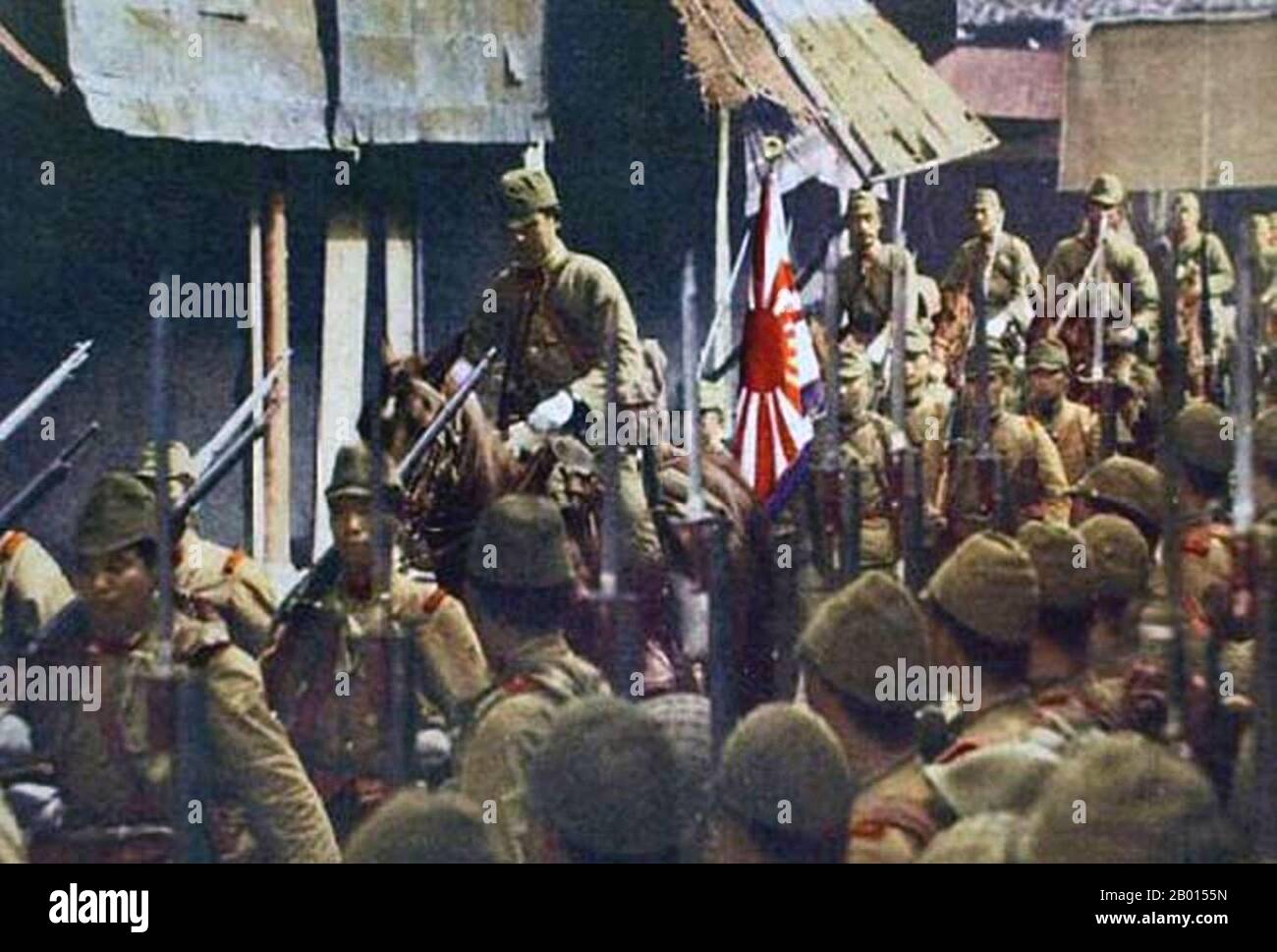 China: Japanese troops marching through an occupied Chinese town. Second Sino-Japanese War (July 7, 1937 – September 9, 1945). The Second Sino-Japanese War was a military conflict fought primarily between the Republic of China and the Empire of Japan. After the Japanese attack on Pearl Harbor, the war merged into the greater conflict of World War II as a major front of what is broadly known as the Pacific War. Although the two countries had fought intermittently since 1931, total war started in earnest in 1937 and ended only with the surrender of Japan in 1945. Stock Photohttps://www.alamy.com/image-license-details/?v=1https://www.alamy.com/china-japanese-troops-marching-through-an-occupied-chinese-town-second-sino-japanese-war-july-7-1937-september-9-1945-the-second-sino-japanese-war-was-a-military-conflict-fought-primarily-between-the-republic-of-china-and-the-empire-of-japan-after-the-japanese-attack-on-pearl-harbor-the-war-merged-into-the-greater-conflict-of-world-war-ii-as-a-major-front-of-what-is-broadly-known-as-the-pacific-war-although-the-two-countries-had-fought-intermittently-since-1931-total-war-started-in-earnest-in-1937-and-ended-only-with-the-surrender-of-japan-in-1945-image344233393.html
China: Japanese troops marching through an occupied Chinese town. Second Sino-Japanese War (July 7, 1937 – September 9, 1945). The Second Sino-Japanese War was a military conflict fought primarily between the Republic of China and the Empire of Japan. After the Japanese attack on Pearl Harbor, the war merged into the greater conflict of World War II as a major front of what is broadly known as the Pacific War. Although the two countries had fought intermittently since 1931, total war started in earnest in 1937 and ended only with the surrender of Japan in 1945. Stock Photohttps://www.alamy.com/image-license-details/?v=1https://www.alamy.com/china-japanese-troops-marching-through-an-occupied-chinese-town-second-sino-japanese-war-july-7-1937-september-9-1945-the-second-sino-japanese-war-was-a-military-conflict-fought-primarily-between-the-republic-of-china-and-the-empire-of-japan-after-the-japanese-attack-on-pearl-harbor-the-war-merged-into-the-greater-conflict-of-world-war-ii-as-a-major-front-of-what-is-broadly-known-as-the-pacific-war-although-the-two-countries-had-fought-intermittently-since-1931-total-war-started-in-earnest-in-1937-and-ended-only-with-the-surrender-of-japan-in-1945-image344233393.htmlRM2B0155N–China: Japanese troops marching through an occupied Chinese town. Second Sino-Japanese War (July 7, 1937 – September 9, 1945). The Second Sino-Japanese War was a military conflict fought primarily between the Republic of China and the Empire of Japan. After the Japanese attack on Pearl Harbor, the war merged into the greater conflict of World War II as a major front of what is broadly known as the Pacific War. Although the two countries had fought intermittently since 1931, total war started in earnest in 1937 and ended only with the surrender of Japan in 1945.
 Guan Yu The God of War illustration Romance of the three kingdom history. Stock Vectorhttps://www.alamy.com/image-license-details/?v=1https://www.alamy.com/guan-yu-the-god-of-war-illustration-romance-of-the-three-kingdom-history-image444227872.html
Guan Yu The God of War illustration Romance of the three kingdom history. Stock Vectorhttps://www.alamy.com/image-license-details/?v=1https://www.alamy.com/guan-yu-the-god-of-war-illustration-romance-of-the-three-kingdom-history-image444227872.htmlRF2GPM954–Guan Yu The God of War illustration Romance of the three kingdom history.
 China/United Kingdom: The King's Dragoon Guards engaged with Tartar cavalry near Peking, 21 September 1860. Engraving from 'The Illustrated London News', 22 December 1860. The Second Opium War, the Second Anglo-Chinese War, the Second China War, the Arrow War, or the Anglo-French expedition to China, was a war pitting the British Empire and the Second French Empire against the Qing Dynasty of China, lasting from 1856–1860. It resulted in a second defeat for the Qing dynasty and led to the forced legalisation of the opium trade. More unequal treaties meant more territorial losses for China. Stock Photohttps://www.alamy.com/image-license-details/?v=1https://www.alamy.com/chinaunited-kingdom-the-kings-dragoon-guards-engaged-with-tartar-cavalry-near-peking-21-september-1860-engraving-from-the-illustrated-london-news-22-december-1860-the-second-opium-war-the-second-anglo-chinese-war-the-second-china-war-the-arrow-war-or-the-anglo-french-expedition-to-china-was-a-war-pitting-the-british-empire-and-the-second-french-empire-against-the-qing-dynasty-of-china-lasting-from-18561860-it-resulted-in-a-second-defeat-for-the-qing-dynasty-and-led-to-the-forced-legalisation-of-the-opium-trade-more-unequal-treaties-meant-more-territorial-losses-for-china-image344247652.html
China/United Kingdom: The King's Dragoon Guards engaged with Tartar cavalry near Peking, 21 September 1860. Engraving from 'The Illustrated London News', 22 December 1860. The Second Opium War, the Second Anglo-Chinese War, the Second China War, the Arrow War, or the Anglo-French expedition to China, was a war pitting the British Empire and the Second French Empire against the Qing Dynasty of China, lasting from 1856–1860. It resulted in a second defeat for the Qing dynasty and led to the forced legalisation of the opium trade. More unequal treaties meant more territorial losses for China. Stock Photohttps://www.alamy.com/image-license-details/?v=1https://www.alamy.com/chinaunited-kingdom-the-kings-dragoon-guards-engaged-with-tartar-cavalry-near-peking-21-september-1860-engraving-from-the-illustrated-london-news-22-december-1860-the-second-opium-war-the-second-anglo-chinese-war-the-second-china-war-the-arrow-war-or-the-anglo-french-expedition-to-china-was-a-war-pitting-the-british-empire-and-the-second-french-empire-against-the-qing-dynasty-of-china-lasting-from-18561860-it-resulted-in-a-second-defeat-for-the-qing-dynasty-and-led-to-the-forced-legalisation-of-the-opium-trade-more-unequal-treaties-meant-more-territorial-losses-for-china-image344247652.htmlRM2B01RB0–China/United Kingdom: The King's Dragoon Guards engaged with Tartar cavalry near Peking, 21 September 1860. Engraving from 'The Illustrated London News', 22 December 1860. The Second Opium War, the Second Anglo-Chinese War, the Second China War, the Arrow War, or the Anglo-French expedition to China, was a war pitting the British Empire and the Second French Empire against the Qing Dynasty of China, lasting from 1856–1860. It resulted in a second defeat for the Qing dynasty and led to the forced legalisation of the opium trade. More unequal treaties meant more territorial losses for China.
 Liverpool William Brown Street World Museum China's First Emperor & The Terracotta Warriors Exhibition soldiers on horseback Stock Photohttps://www.alamy.com/image-license-details/?v=1https://www.alamy.com/liverpool-william-brown-street-world-museum-chinas-first-emperor-the-terracotta-warriors-exhibition-soldiers-on-horseback-image219426066.html
Liverpool William Brown Street World Museum China's First Emperor & The Terracotta Warriors Exhibition soldiers on horseback Stock Photohttps://www.alamy.com/image-license-details/?v=1https://www.alamy.com/liverpool-william-brown-street-world-museum-chinas-first-emperor-the-terracotta-warriors-exhibition-soldiers-on-horseback-image219426066.htmlRMPMYM56–Liverpool William Brown Street World Museum China's First Emperor & The Terracotta Warriors Exhibition soldiers on horseback
 A Chinese general snatched a branch of a cherry tree A soldier on horseback, Where: apparently Han Yun, with attendant pulls a branch of cherry tree in bloom. Right a large red sun. Bottom left is a goat (referring to the year of the goat 1835) . Manufacturer : creator: Totoya Hokkei (listed building) Dated: 1835 Physical features: woodcut; line block in black with color blocks material: paper Technique: woodcut Dimensions: sheet: H 210 mm × W 182 mmToelichtingEen surimono is a luxurious picture image which is combined with one or more poems. When the printing of a surimono was often use is ma Stock Photohttps://www.alamy.com/image-license-details/?v=1https://www.alamy.com/a-chinese-general-snatched-a-branch-of-a-cherry-tree-a-soldier-on-horseback-where-apparently-han-yun-with-attendant-pulls-a-branch-of-cherry-tree-in-bloom-right-a-large-red-sun-bottom-left-is-a-goat-referring-to-the-year-of-the-goat-1835-manufacturer-creator-totoya-hokkei-listed-building-dated-1835-physical-features-woodcut-line-block-in-black-with-color-blocks-material-paper-technique-woodcut-dimensions-sheet-h-210-mm-w-182-mmtoelichtingeen-surimono-is-a-luxurious-picture-image-which-is-combined-with-one-or-more-poems-when-the-printing-of-a-surimono-was-often-use-is-ma-image348326473.html
A Chinese general snatched a branch of a cherry tree A soldier on horseback, Where: apparently Han Yun, with attendant pulls a branch of cherry tree in bloom. Right a large red sun. Bottom left is a goat (referring to the year of the goat 1835) . Manufacturer : creator: Totoya Hokkei (listed building) Dated: 1835 Physical features: woodcut; line block in black with color blocks material: paper Technique: woodcut Dimensions: sheet: H 210 mm × W 182 mmToelichtingEen surimono is a luxurious picture image which is combined with one or more poems. When the printing of a surimono was often use is ma Stock Photohttps://www.alamy.com/image-license-details/?v=1https://www.alamy.com/a-chinese-general-snatched-a-branch-of-a-cherry-tree-a-soldier-on-horseback-where-apparently-han-yun-with-attendant-pulls-a-branch-of-cherry-tree-in-bloom-right-a-large-red-sun-bottom-left-is-a-goat-referring-to-the-year-of-the-goat-1835-manufacturer-creator-totoya-hokkei-listed-building-dated-1835-physical-features-woodcut-line-block-in-black-with-color-blocks-material-paper-technique-woodcut-dimensions-sheet-h-210-mm-w-182-mmtoelichtingeen-surimono-is-a-luxurious-picture-image-which-is-combined-with-one-or-more-poems-when-the-printing-of-a-surimono-was-often-use-is-ma-image348326473.htmlRM2B6KHY5–A Chinese general snatched a branch of a cherry tree A soldier on horseback, Where: apparently Han Yun, with attendant pulls a branch of cherry tree in bloom. Right a large red sun. Bottom left is a goat (referring to the year of the goat 1835) . Manufacturer : creator: Totoya Hokkei (listed building) Dated: 1835 Physical features: woodcut; line block in black with color blocks material: paper Technique: woodcut Dimensions: sheet: H 210 mm × W 182 mmToelichtingEen surimono is a luxurious picture image which is combined with one or more poems. When the printing of a surimono was often use is ma
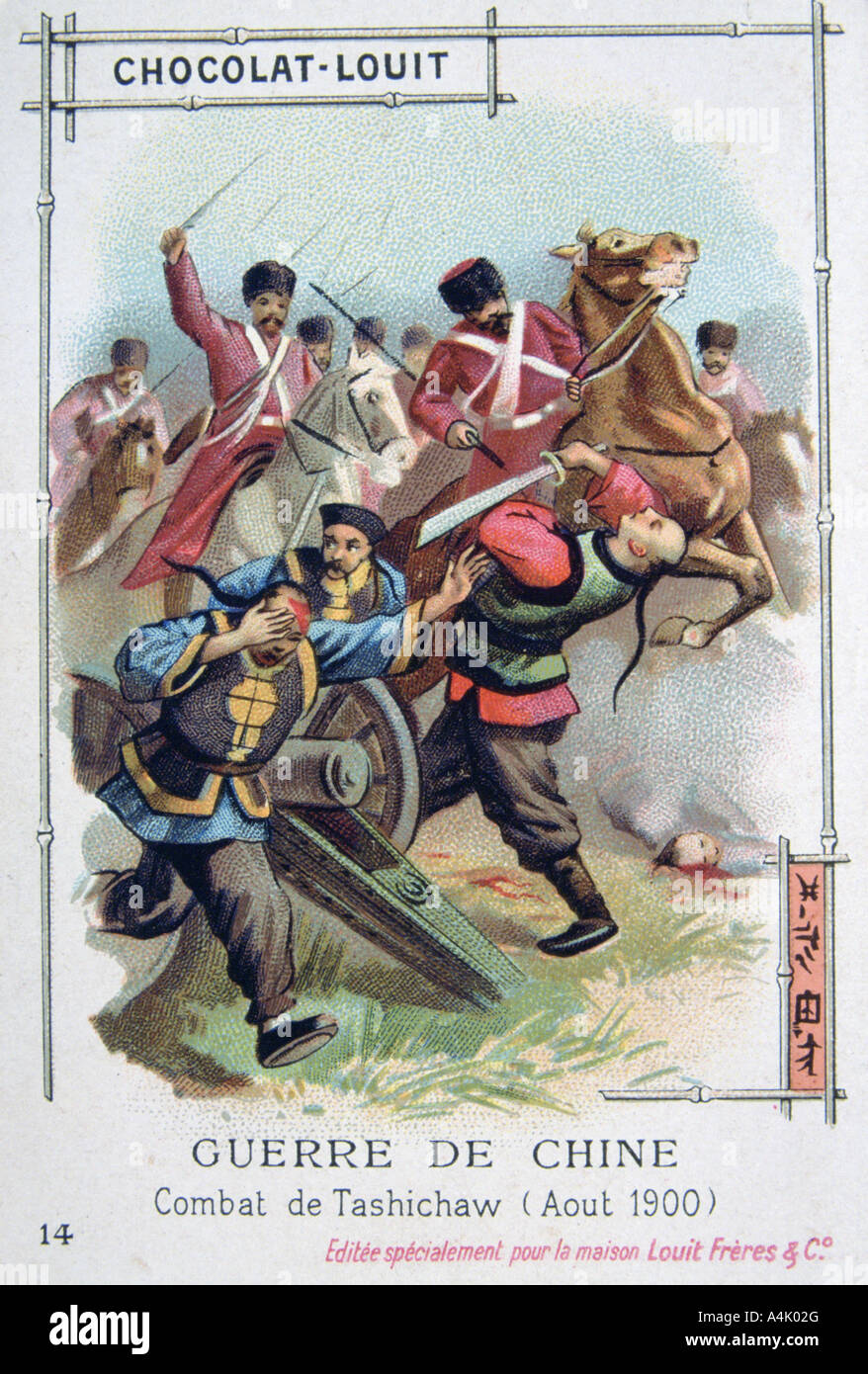 Battle at Tashichaw, China, Boxer Rebellion, August 1900. Artist: Unknown Stock Photohttps://www.alamy.com/image-license-details/?v=1https://www.alamy.com/stock-photo-battle-at-tashichaw-china-boxer-rebellion-august-1900-artist-unknown-11066967.html
Battle at Tashichaw, China, Boxer Rebellion, August 1900. Artist: Unknown Stock Photohttps://www.alamy.com/image-license-details/?v=1https://www.alamy.com/stock-photo-battle-at-tashichaw-china-boxer-rebellion-august-1900-artist-unknown-11066967.htmlRMA4K02G–Battle at Tashichaw, China, Boxer Rebellion, August 1900. Artist: Unknown
 During a drought in 1974, farmers digging a well stumbled across one of the most amazing archaeological finds in modern history - the terracotta warriors. The terracotta army, thousands of soldiers, horses and chariots, had remained secretly on duty for some 2,000 years, guarding the nearby mausoleum of Qin Shu Huang / Qin Shi Huangdi, the first emperor of a unified China (r. 246 - 221 BCE). The infamous Qinshi is best known for his ruthless destruction of books and the slaughter of his enemies. Each of the terracotta figures, some standing, some on horseback, and some kneeling, bows drawn, Stock Photohttps://www.alamy.com/image-license-details/?v=1https://www.alamy.com/during-a-drought-in-1974-farmers-digging-a-well-stumbled-across-one-of-the-most-amazing-archaeological-finds-in-modern-history-the-terracotta-warriors-the-terracotta-army-thousands-of-soldiers-horses-and-chariots-had-remained-secretly-on-duty-for-some-2000-years-guarding-the-nearby-mausoleum-of-qin-shu-huang-qin-shi-huangdi-the-first-emperor-of-a-unified-china-r-246-221-bce-the-infamous-qinshi-is-best-known-for-his-ruthless-destruction-of-books-and-the-slaughter-of-his-enemies-each-of-the-terracotta-figures-some-standing-some-on-horseback-and-some-kneeling-bows-drawn-image344274539.html
During a drought in 1974, farmers digging a well stumbled across one of the most amazing archaeological finds in modern history - the terracotta warriors. The terracotta army, thousands of soldiers, horses and chariots, had remained secretly on duty for some 2,000 years, guarding the nearby mausoleum of Qin Shu Huang / Qin Shi Huangdi, the first emperor of a unified China (r. 246 - 221 BCE). The infamous Qinshi is best known for his ruthless destruction of books and the slaughter of his enemies. Each of the terracotta figures, some standing, some on horseback, and some kneeling, bows drawn, Stock Photohttps://www.alamy.com/image-license-details/?v=1https://www.alamy.com/during-a-drought-in-1974-farmers-digging-a-well-stumbled-across-one-of-the-most-amazing-archaeological-finds-in-modern-history-the-terracotta-warriors-the-terracotta-army-thousands-of-soldiers-horses-and-chariots-had-remained-secretly-on-duty-for-some-2000-years-guarding-the-nearby-mausoleum-of-qin-shu-huang-qin-shi-huangdi-the-first-emperor-of-a-unified-china-r-246-221-bce-the-infamous-qinshi-is-best-known-for-his-ruthless-destruction-of-books-and-the-slaughter-of-his-enemies-each-of-the-terracotta-figures-some-standing-some-on-horseback-and-some-kneeling-bows-drawn-image344274539.htmlRM2B031K7–During a drought in 1974, farmers digging a well stumbled across one of the most amazing archaeological finds in modern history - the terracotta warriors. The terracotta army, thousands of soldiers, horses and chariots, had remained secretly on duty for some 2,000 years, guarding the nearby mausoleum of Qin Shu Huang / Qin Shi Huangdi, the first emperor of a unified China (r. 246 - 221 BCE). The infamous Qinshi is best known for his ruthless destruction of books and the slaughter of his enemies. Each of the terracotta figures, some standing, some on horseback, and some kneeling, bows drawn,
 A Chinese soldier bearing weapons on his back, on horseback. Watercolour by C. Wirgman, ca. 1857. Stock Photohttps://www.alamy.com/image-license-details/?v=1https://www.alamy.com/a-chinese-soldier-bearing-weapons-on-his-back-on-horseback-watercolour-by-c-wirgman-ca-1857-image450023662.html
A Chinese soldier bearing weapons on his back, on horseback. Watercolour by C. Wirgman, ca. 1857. Stock Photohttps://www.alamy.com/image-license-details/?v=1https://www.alamy.com/a-chinese-soldier-bearing-weapons-on-his-back-on-horseback-watercolour-by-c-wirgman-ca-1857-image450023662.htmlRM2H449NJ–A Chinese soldier bearing weapons on his back, on horseback. Watercolour by C. Wirgman, ca. 1857.
 Nurhaci defeats 40 men. Manzhou shilu. Shenyang, 1930. The emperor, on horseback with sword raised in his hand, is described as single-handedly finishing off 40 Chinese soldiers, though his bowman appear to have killed many. Some are seen climbing ladders over a Chinese city wall. A facsimile of the 1781 edition of the Manzhou shilu, illustrated description of the life of Nurhaci (1559-1626), whose descendants completed the conquest of China and the establishment of the Qing dynasty, 1644-1911. Image taken from Manzhou shilu. Originally published/produced in Shenyang, 1930. . Source: 15529.a Stock Photohttps://www.alamy.com/image-license-details/?v=1https://www.alamy.com/nurhaci-defeats-40-men-manzhou-shilu-shenyang-1930-the-emperor-on-horseback-with-sword-raised-in-his-hand-is-described-as-single-handedly-finishing-off-40-chinese-soldiers-though-his-bowman-appear-to-have-killed-many-some-are-seen-climbing-ladders-over-a-chinese-city-wall-a-facsimile-of-the-1781-edition-of-the-manzhou-shilu-illustrated-description-of-the-life-of-nurhaci-1559-1626-whose-descendants-completed-the-conquest-of-china-and-the-establishment-of-the-qing-dynasty-1644-1911-image-taken-from-manzhou-shilu-originally-publishedproduced-in-shenyang-1930-source-15529a-image227209133.html
Nurhaci defeats 40 men. Manzhou shilu. Shenyang, 1930. The emperor, on horseback with sword raised in his hand, is described as single-handedly finishing off 40 Chinese soldiers, though his bowman appear to have killed many. Some are seen climbing ladders over a Chinese city wall. A facsimile of the 1781 edition of the Manzhou shilu, illustrated description of the life of Nurhaci (1559-1626), whose descendants completed the conquest of China and the establishment of the Qing dynasty, 1644-1911. Image taken from Manzhou shilu. Originally published/produced in Shenyang, 1930. . Source: 15529.a Stock Photohttps://www.alamy.com/image-license-details/?v=1https://www.alamy.com/nurhaci-defeats-40-men-manzhou-shilu-shenyang-1930-the-emperor-on-horseback-with-sword-raised-in-his-hand-is-described-as-single-handedly-finishing-off-40-chinese-soldiers-though-his-bowman-appear-to-have-killed-many-some-are-seen-climbing-ladders-over-a-chinese-city-wall-a-facsimile-of-the-1781-edition-of-the-manzhou-shilu-illustrated-description-of-the-life-of-nurhaci-1559-1626-whose-descendants-completed-the-conquest-of-china-and-the-establishment-of-the-qing-dynasty-1644-1911-image-taken-from-manzhou-shilu-originally-publishedproduced-in-shenyang-1930-source-15529a-image227209133.htmlRMR5J7FW–Nurhaci defeats 40 men. Manzhou shilu. Shenyang, 1930. The emperor, on horseback with sword raised in his hand, is described as single-handedly finishing off 40 Chinese soldiers, though his bowman appear to have killed many. Some are seen climbing ladders over a Chinese city wall. A facsimile of the 1781 edition of the Manzhou shilu, illustrated description of the life of Nurhaci (1559-1626), whose descendants completed the conquest of China and the establishment of the Qing dynasty, 1644-1911. Image taken from Manzhou shilu. Originally published/produced in Shenyang, 1930. . Source: 15529.a
!['A Tartar Horse-Soldier', c1891. From "Cassell's Illustrated History of India Vol. II.", by James Grant. [Cassell Petter & Galpin, London, Paris and New York] Stock Photo 'A Tartar Horse-Soldier', c1891. From "Cassell's Illustrated History of India Vol. II.", by James Grant. [Cassell Petter & Galpin, London, Paris and New York] Stock Photo](https://c8.alamy.com/comp/2J8980F/a-tartar-horse-soldier-c1891-from-quotcassells-illustrated-history-of-india-vol-iiquot-by-james-grant-cassell-petter-amp-galpin-london-paris-and-new-york-2J8980F.jpg) 'A Tartar Horse-Soldier', c1891. From "Cassell's Illustrated History of India Vol. II.", by James Grant. [Cassell Petter & Galpin, London, Paris and New York] Stock Photohttps://www.alamy.com/image-license-details/?v=1https://www.alamy.com/a-tartar-horse-soldier-c1891-from-quotcassells-illustrated-history-of-india-vol-iiquot-by-james-grant-cassell-petter-amp-galpin-london-paris-and-new-york-image469801039.html
'A Tartar Horse-Soldier', c1891. From "Cassell's Illustrated History of India Vol. II.", by James Grant. [Cassell Petter & Galpin, London, Paris and New York] Stock Photohttps://www.alamy.com/image-license-details/?v=1https://www.alamy.com/a-tartar-horse-soldier-c1891-from-quotcassells-illustrated-history-of-india-vol-iiquot-by-james-grant-cassell-petter-amp-galpin-london-paris-and-new-york-image469801039.htmlRM2J8980F–'A Tartar Horse-Soldier', c1891. From "Cassell's Illustrated History of India Vol. II.", by James Grant. [Cassell Petter & Galpin, London, Paris and New York]
 Murals picturing soldiers on horseback on the wall of the Qianling Mausoleum, a Tang Dynasty (618–907) tomb site located in Qian County, Shaanxi provi Stock Photohttps://www.alamy.com/image-license-details/?v=1https://www.alamy.com/murals-picturing-soldiers-on-horseback-on-the-wall-of-the-qianling-mausoleum-a-tang-dynasty-618907-tomb-site-located-in-qian-county-shaanxi-provi-image344181144.html
Murals picturing soldiers on horseback on the wall of the Qianling Mausoleum, a Tang Dynasty (618–907) tomb site located in Qian County, Shaanxi provi Stock Photohttps://www.alamy.com/image-license-details/?v=1https://www.alamy.com/murals-picturing-soldiers-on-horseback-on-the-wall-of-the-qianling-mausoleum-a-tang-dynasty-618907-tomb-site-located-in-qian-county-shaanxi-provi-image344181144.htmlRM2AYXPFM–Murals picturing soldiers on horseback on the wall of the Qianling Mausoleum, a Tang Dynasty (618–907) tomb site located in Qian County, Shaanxi provi
 German troops march through a street in the city of Tsingtau during the Chinese Revolution. Stock Photohttps://www.alamy.com/image-license-details/?v=1https://www.alamy.com/german-troops-march-through-a-street-in-the-city-of-tsingtau-during-the-chinese-revolution-image345687038.html
German troops march through a street in the city of Tsingtau during the Chinese Revolution. Stock Photohttps://www.alamy.com/image-license-details/?v=1https://www.alamy.com/german-troops-march-through-a-street-in-the-city-of-tsingtau-during-the-chinese-revolution-image345687038.htmlRM2B2BB9J–German troops march through a street in the city of Tsingtau during the Chinese Revolution.
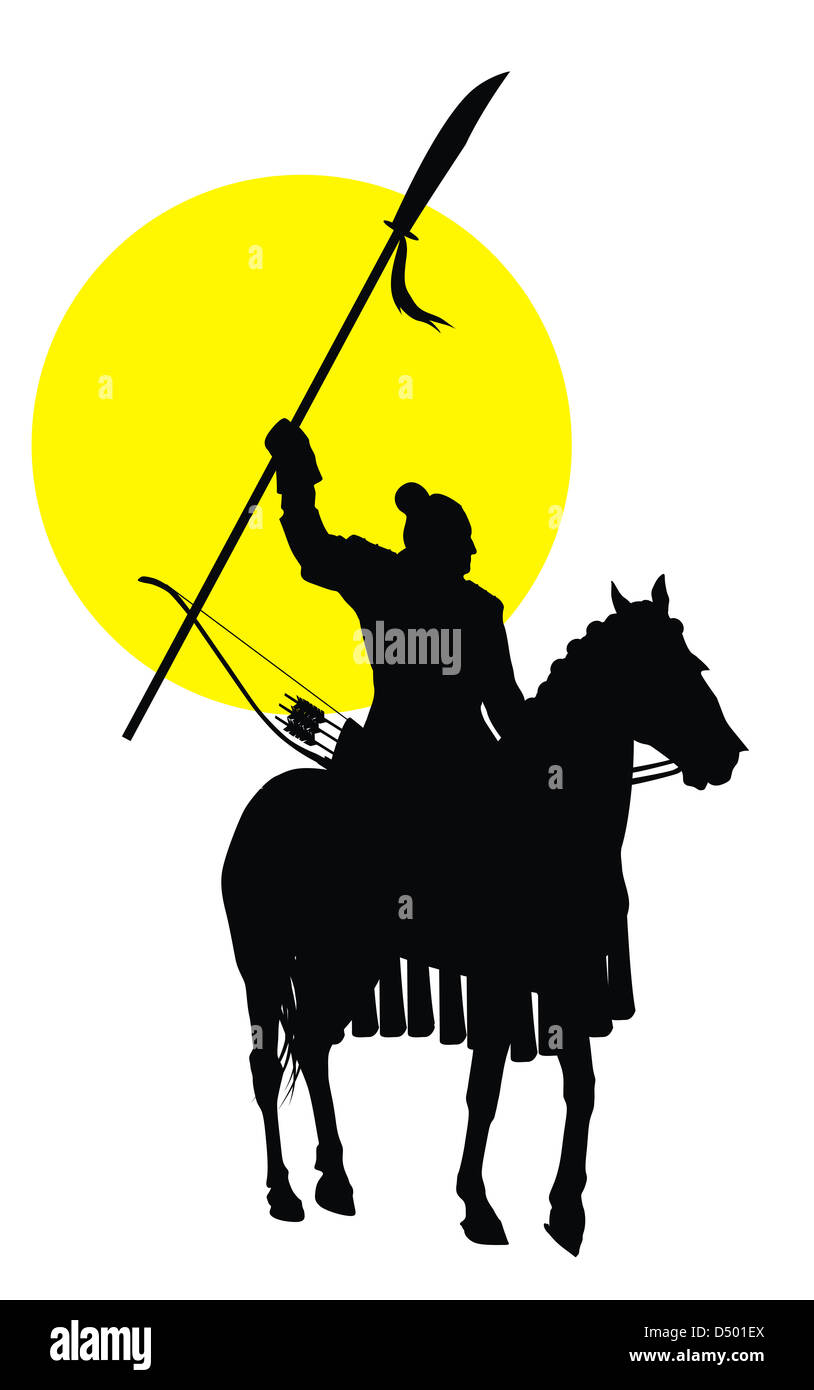 Chinese horseman Stock Photohttps://www.alamy.com/image-license-details/?v=1https://www.alamy.com/stock-photo-chinese-horseman-54705586.html
Chinese horseman Stock Photohttps://www.alamy.com/image-license-details/?v=1https://www.alamy.com/stock-photo-chinese-horseman-54705586.htmlRFD501EX–Chinese horseman
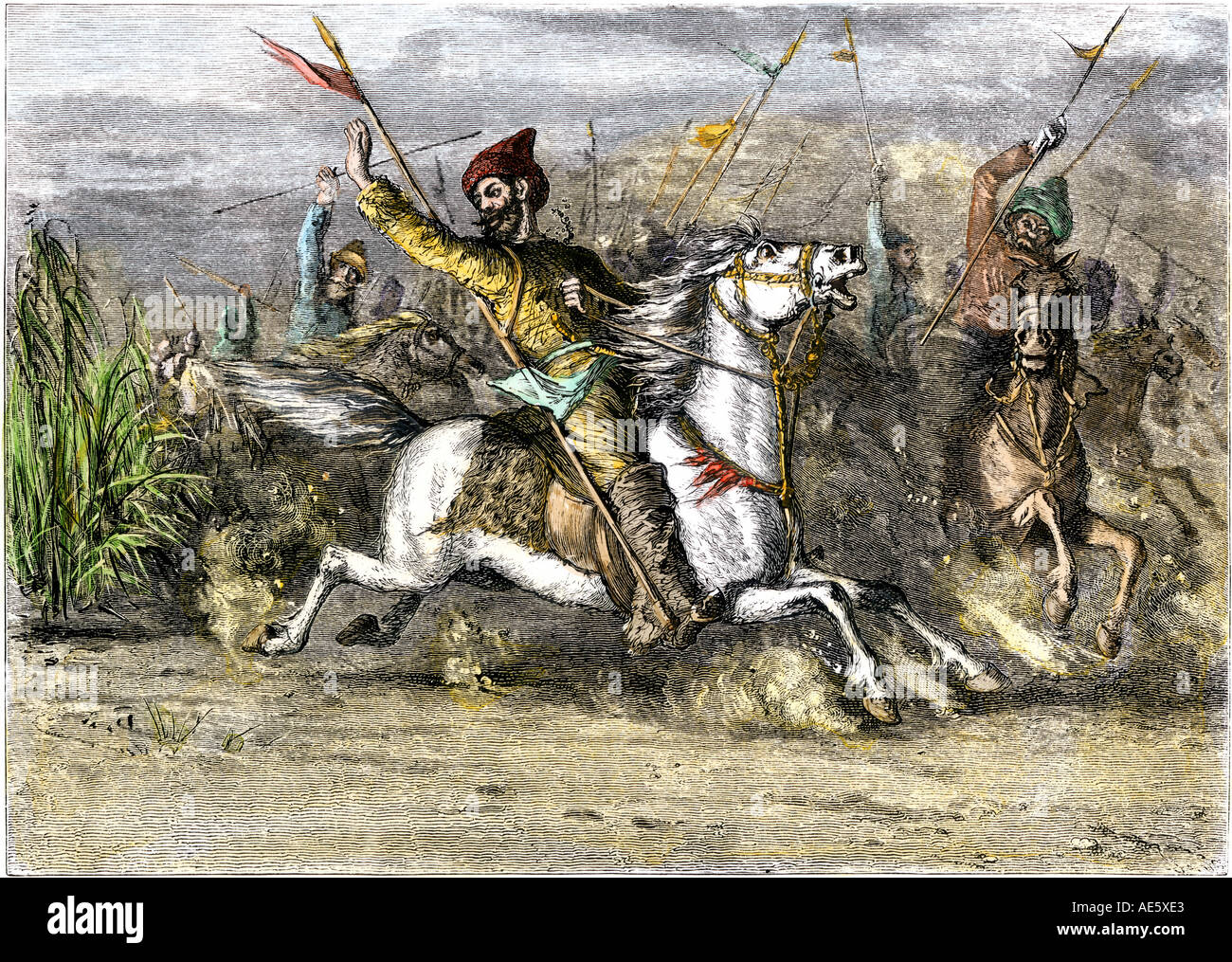 Genghis Khan leading the Mongol conquest of China. Hand-colored woodcut Stock Photohttps://www.alamy.com/image-license-details/?v=1https://www.alamy.com/genghis-khan-leading-the-mongol-conquest-of-china-hand-colored-woodcut-image4433634.html
Genghis Khan leading the Mongol conquest of China. Hand-colored woodcut Stock Photohttps://www.alamy.com/image-license-details/?v=1https://www.alamy.com/genghis-khan-leading-the-mongol-conquest-of-china-hand-colored-woodcut-image4433634.htmlRMAE5XE3–Genghis Khan leading the Mongol conquest of China. Hand-colored woodcut
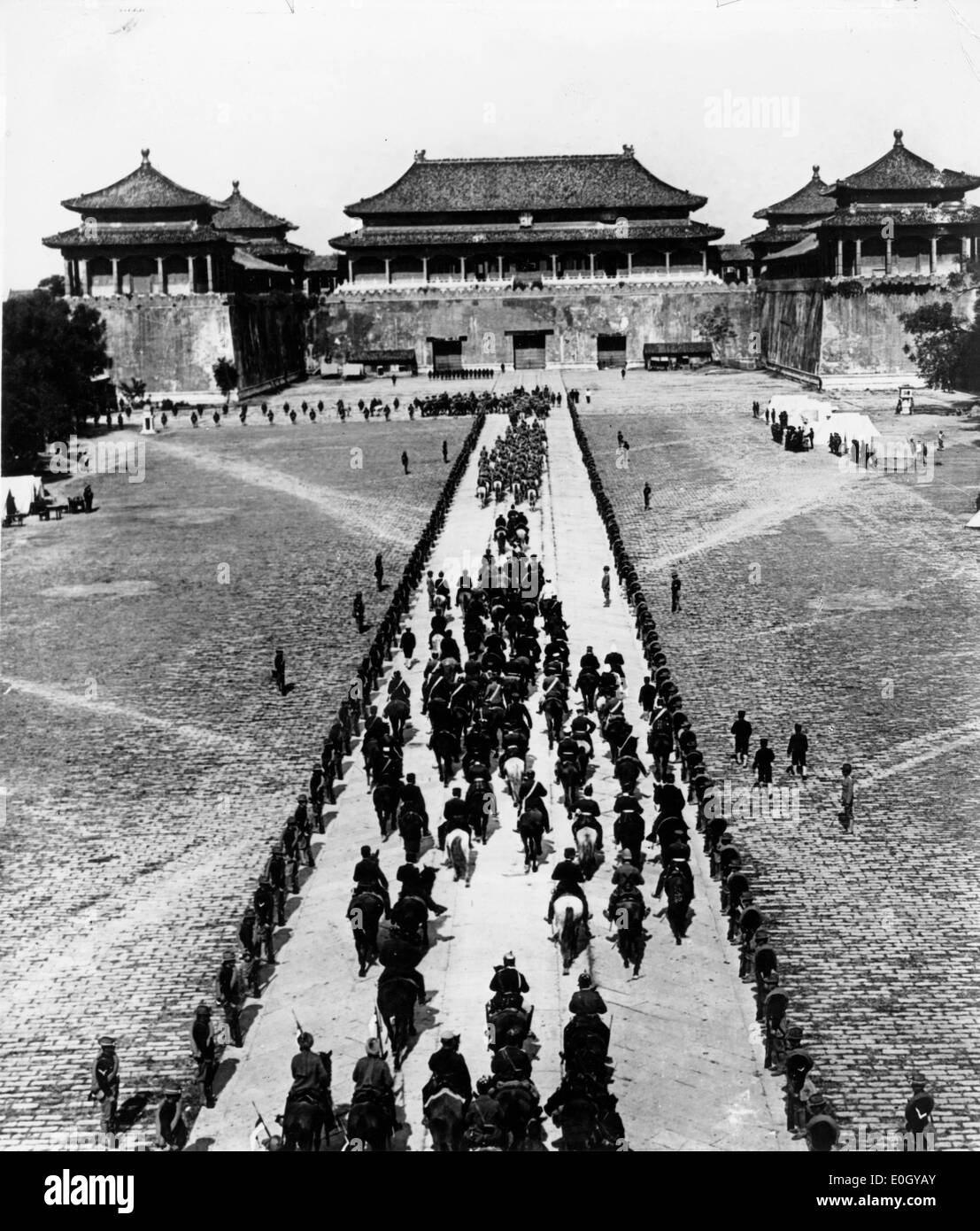 German cavalry in Peking after the collapse of the Boxer Rebellion Stock Photohttps://www.alamy.com/image-license-details/?v=1https://www.alamy.com/german-cavalry-in-peking-after-the-collapse-of-the-boxer-rebellion-image69214179.html
German cavalry in Peking after the collapse of the Boxer Rebellion Stock Photohttps://www.alamy.com/image-license-details/?v=1https://www.alamy.com/german-cavalry-in-peking-after-the-collapse-of-the-boxer-rebellion-image69214179.htmlRME0GYAY–German cavalry in Peking after the collapse of the Boxer Rebellion
 Woodcut illustration shows the allied armies advancing toward the Boxer forces outside the imperial castle in Beijing, China. Stock Photohttps://www.alamy.com/image-license-details/?v=1https://www.alamy.com/stock-photo-woodcut-illustration-shows-the-allied-armies-advancing-toward-the-90847232.html
Woodcut illustration shows the allied armies advancing toward the Boxer forces outside the imperial castle in Beijing, China. Stock Photohttps://www.alamy.com/image-license-details/?v=1https://www.alamy.com/stock-photo-woodcut-illustration-shows-the-allied-armies-advancing-toward-the-90847232.htmlRMF7PCG0–Woodcut illustration shows the allied armies advancing toward the Boxer forces outside the imperial castle in Beijing, China.
 People s Liberation Army Stock Photohttps://www.alamy.com/image-license-details/?v=1https://www.alamy.com/people-s-liberation-army-image1573499.html
People s Liberation Army Stock Photohttps://www.alamy.com/image-license-details/?v=1https://www.alamy.com/people-s-liberation-army-image1573499.htmlRMAS027C–People s Liberation Army
 Russo-Japanese War (1904-1905). A General of the Russian division met an official of one of their regiments, accompanied by a few soldiers due to the casualties on the battle of Shaho river. Engraving in 'La Ilustracion Artistica'. Colored. Stock Photohttps://www.alamy.com/image-license-details/?v=1https://www.alamy.com/russo-japanese-war-1904-1905-a-general-of-the-russian-division-met-an-official-of-one-of-their-regiments-accompanied-by-a-few-soldiers-due-to-the-casualties-on-the-battle-of-shaho-river-engraving-in-la-ilustracion-artistica-colored-image212371338.html
Russo-Japanese War (1904-1905). A General of the Russian division met an official of one of their regiments, accompanied by a few soldiers due to the casualties on the battle of Shaho river. Engraving in 'La Ilustracion Artistica'. Colored. Stock Photohttps://www.alamy.com/image-license-details/?v=1https://www.alamy.com/russo-japanese-war-1904-1905-a-general-of-the-russian-division-met-an-official-of-one-of-their-regiments-accompanied-by-a-few-soldiers-due-to-the-casualties-on-the-battle-of-shaho-river-engraving-in-la-ilustracion-artistica-colored-image212371338.htmlRMP9E9PJ–Russo-Japanese War (1904-1905). A General of the Russian division met an official of one of their regiments, accompanied by a few soldiers due to the casualties on the battle of Shaho river. Engraving in 'La Ilustracion Artistica'. Colored.
 The return of the Cossack soldiers, Mongolia. Asia. Trip to Mongolia by Nikolai Mijailovich Przewalski in 1870-1873, Le Tour du Monde 1877 Stock Photohttps://www.alamy.com/image-license-details/?v=1https://www.alamy.com/the-return-of-the-cossack-soldiers-mongolia-asia-trip-to-mongolia-by-nikolai-mijailovich-przewalski-in-1870-1873-le-tour-du-monde-1877-image461659725.html
The return of the Cossack soldiers, Mongolia. Asia. Trip to Mongolia by Nikolai Mijailovich Przewalski in 1870-1873, Le Tour du Monde 1877 Stock Photohttps://www.alamy.com/image-license-details/?v=1https://www.alamy.com/the-return-of-the-cossack-soldiers-mongolia-asia-trip-to-mongolia-by-nikolai-mijailovich-przewalski-in-1870-1873-le-tour-du-monde-1877-image461659725.htmlRM2HR2BK9–The return of the Cossack soldiers, Mongolia. Asia. Trip to Mongolia by Nikolai Mijailovich Przewalski in 1870-1873, Le Tour du Monde 1877
 Iran water pipe pottery ceramic17 century underglazed pastime indulgence hashish opium blue horse rider cavalry stallion under Stock Photohttps://www.alamy.com/image-license-details/?v=1https://www.alamy.com/stock-photo-iran-water-pipe-pottery-ceramic17-century-underglazed-pastime-indulgence-15639509.html
Iran water pipe pottery ceramic17 century underglazed pastime indulgence hashish opium blue horse rider cavalry stallion under Stock Photohttps://www.alamy.com/image-license-details/?v=1https://www.alamy.com/stock-photo-iran-water-pipe-pottery-ceramic17-century-underglazed-pastime-indulgence-15639509.htmlRMAP10RJ–Iran water pipe pottery ceramic17 century underglazed pastime indulgence hashish opium blue horse rider cavalry stallion under
 May 2, 1901 - Peking, China - German cavalry arrive in Peking after the collapse of the Boxer Rebellion in 1901. The Boxer rebellion could hardly be classified as either a rebelion or a war against the Europeans.The Boxer Rebelion was only limited to a few places, but concentrated itself in Beijing. Within a couple months, an international force captured and occupied Beijing and fo Stock Photohttps://www.alamy.com/image-license-details/?v=1https://www.alamy.com/may-2-1901-peking-china-german-cavalry-arrive-in-peking-after-the-image65110454.html
May 2, 1901 - Peking, China - German cavalry arrive in Peking after the collapse of the Boxer Rebellion in 1901. The Boxer rebellion could hardly be classified as either a rebelion or a war against the Europeans.The Boxer Rebelion was only limited to a few places, but concentrated itself in Beijing. Within a couple months, an international force captured and occupied Beijing and fo Stock Photohttps://www.alamy.com/image-license-details/?v=1https://www.alamy.com/may-2-1901-peking-china-german-cavalry-arrive-in-peking-after-the-image65110454.htmlRMDNX11A–May 2, 1901 - Peking, China - German cavalry arrive in Peking after the collapse of the Boxer Rebellion in 1901. The Boxer rebellion could hardly be classified as either a rebelion or a war against the Europeans.The Boxer Rebelion was only limited to a few places, but concentrated itself in Beijing. Within a couple months, an international force captured and occupied Beijing and fo
 Drawing of an oriental army general from Babylon Electrified Stock Vectorhttps://www.alamy.com/image-license-details/?v=1https://www.alamy.com/drawing-of-an-oriental-army-general-from-babylon-electrified-image503469072.html
Drawing of an oriental army general from Babylon Electrified Stock Vectorhttps://www.alamy.com/image-license-details/?v=1https://www.alamy.com/drawing-of-an-oriental-army-general-from-babylon-electrified-image503469072.htmlRF2M72YX8–Drawing of an oriental army general from Babylon Electrified
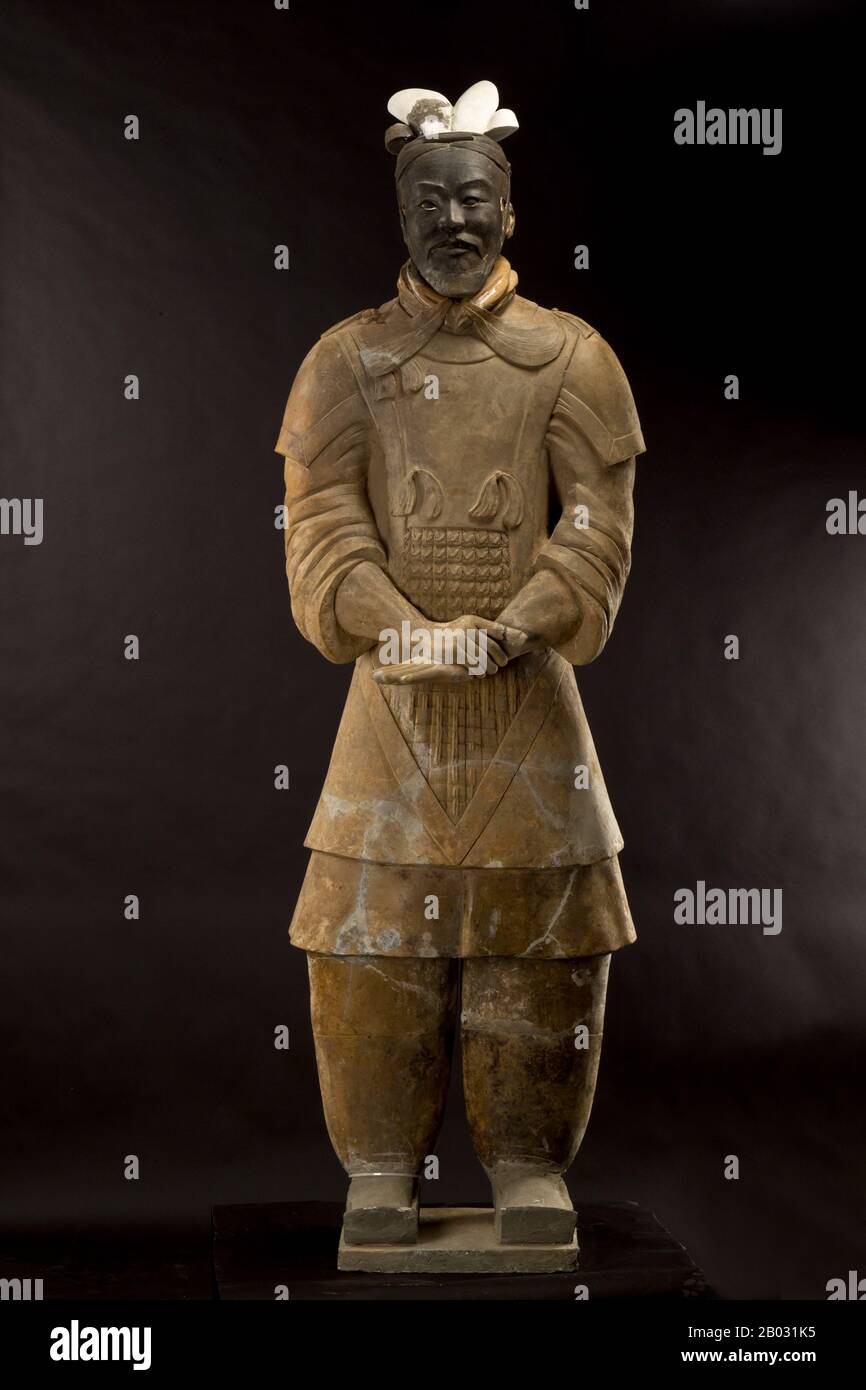 During a drought in 1974, farmers digging a well stumbled across one of the most amazing archaeological finds in modern history - the terracotta warriors. The terracotta army, thousands of soldiers, horses and chariots, had remained secretly on duty for some 2,000 years, guarding the nearby mausoleum of Qin Shu Huang / Qin Shi Huangdi, the first emperor of a unified China (r. 246 - 221 BCE). The infamous Qinshi is best known for his ruthless destruction of books and the slaughter of his enemies. Each of the terracotta figures, some standing, some on horseback, and some kneeling, bows drawn, Stock Photohttps://www.alamy.com/image-license-details/?v=1https://www.alamy.com/during-a-drought-in-1974-farmers-digging-a-well-stumbled-across-one-of-the-most-amazing-archaeological-finds-in-modern-history-the-terracotta-warriors-the-terracotta-army-thousands-of-soldiers-horses-and-chariots-had-remained-secretly-on-duty-for-some-2000-years-guarding-the-nearby-mausoleum-of-qin-shu-huang-qin-shi-huangdi-the-first-emperor-of-a-unified-china-r-246-221-bce-the-infamous-qinshi-is-best-known-for-his-ruthless-destruction-of-books-and-the-slaughter-of-his-enemies-each-of-the-terracotta-figures-some-standing-some-on-horseback-and-some-kneeling-bows-drawn-image344274537.html
During a drought in 1974, farmers digging a well stumbled across one of the most amazing archaeological finds in modern history - the terracotta warriors. The terracotta army, thousands of soldiers, horses and chariots, had remained secretly on duty for some 2,000 years, guarding the nearby mausoleum of Qin Shu Huang / Qin Shi Huangdi, the first emperor of a unified China (r. 246 - 221 BCE). The infamous Qinshi is best known for his ruthless destruction of books and the slaughter of his enemies. Each of the terracotta figures, some standing, some on horseback, and some kneeling, bows drawn, Stock Photohttps://www.alamy.com/image-license-details/?v=1https://www.alamy.com/during-a-drought-in-1974-farmers-digging-a-well-stumbled-across-one-of-the-most-amazing-archaeological-finds-in-modern-history-the-terracotta-warriors-the-terracotta-army-thousands-of-soldiers-horses-and-chariots-had-remained-secretly-on-duty-for-some-2000-years-guarding-the-nearby-mausoleum-of-qin-shu-huang-qin-shi-huangdi-the-first-emperor-of-a-unified-china-r-246-221-bce-the-infamous-qinshi-is-best-known-for-his-ruthless-destruction-of-books-and-the-slaughter-of-his-enemies-each-of-the-terracotta-figures-some-standing-some-on-horseback-and-some-kneeling-bows-drawn-image344274537.htmlRM2B031K5–During a drought in 1974, farmers digging a well stumbled across one of the most amazing archaeological finds in modern history - the terracotta warriors. The terracotta army, thousands of soldiers, horses and chariots, had remained secretly on duty for some 2,000 years, guarding the nearby mausoleum of Qin Shu Huang / Qin Shi Huangdi, the first emperor of a unified China (r. 246 - 221 BCE). The infamous Qinshi is best known for his ruthless destruction of books and the slaughter of his enemies. Each of the terracotta figures, some standing, some on horseback, and some kneeling, bows drawn,
 Chinese soldier, Jan Brandes, 1779 - 1785 drawing Color drawing and ink drawing of Chinese soldiers as in a parade. Bottom left the captain Chinese, with saber on horseback. One soldier is dressed in tiger sheet. They wear peaks, guns, shields, drums and sabers. With inscription. Part of Jan Brandes' sketchbook, dl. 2 (1808), p. 200. Jakarta paper. pencil. watercolor (paint) brush / pen warfare; military affairs (+ infantry) Jakarta Stock Photohttps://www.alamy.com/image-license-details/?v=1https://www.alamy.com/chinese-soldier-jan-brandes-1779-1785-drawing-color-drawing-and-ink-drawing-of-chinese-soldiers-as-in-a-parade-bottom-left-the-captain-chinese-with-saber-on-horseback-one-soldier-is-dressed-in-tiger-sheet-they-wear-peaks-guns-shields-drums-and-sabers-with-inscription-part-of-jan-brandes-sketchbook-dl-2-1808-p-200-jakarta-paper-pencil-watercolor-paint-brush-pen-warfare-military-affairs-infantry-jakarta-image590891926.html
Chinese soldier, Jan Brandes, 1779 - 1785 drawing Color drawing and ink drawing of Chinese soldiers as in a parade. Bottom left the captain Chinese, with saber on horseback. One soldier is dressed in tiger sheet. They wear peaks, guns, shields, drums and sabers. With inscription. Part of Jan Brandes' sketchbook, dl. 2 (1808), p. 200. Jakarta paper. pencil. watercolor (paint) brush / pen warfare; military affairs (+ infantry) Jakarta Stock Photohttps://www.alamy.com/image-license-details/?v=1https://www.alamy.com/chinese-soldier-jan-brandes-1779-1785-drawing-color-drawing-and-ink-drawing-of-chinese-soldiers-as-in-a-parade-bottom-left-the-captain-chinese-with-saber-on-horseback-one-soldier-is-dressed-in-tiger-sheet-they-wear-peaks-guns-shields-drums-and-sabers-with-inscription-part-of-jan-brandes-sketchbook-dl-2-1808-p-200-jakarta-paper-pencil-watercolor-paint-brush-pen-warfare-military-affairs-infantry-jakarta-image590891926.htmlRM2W99CK2–Chinese soldier, Jan Brandes, 1779 - 1785 drawing Color drawing and ink drawing of Chinese soldiers as in a parade. Bottom left the captain Chinese, with saber on horseback. One soldier is dressed in tiger sheet. They wear peaks, guns, shields, drums and sabers. With inscription. Part of Jan Brandes' sketchbook, dl. 2 (1808), p. 200. Jakarta paper. pencil. watercolor (paint) brush / pen warfare; military affairs (+ infantry) Jakarta
 Nurhaci defeats 40 men. Manzhou shilu. Shenyang, 1930. The emperor, on horseback with sword raised in his hand, is described as single-handedly finishing off 40 Chinese soldiers, though his bowman appear to have killed many. Some are seen climbing ladders over a Chinese city wall. A facsimile of the 1781 edition of the Manzhou shilu, illustrated description of the life of Nurhaci (1559-1626), whose descendants completed the conquest of China and the establishment of the Qing dynasty, 1644-1911. Image taken from Manzhou shilu. Originally published/produced in Shenyang, 1930. . Source: 15529.a Stock Photohttps://www.alamy.com/image-license-details/?v=1https://www.alamy.com/nurhaci-defeats-40-men-manzhou-shilu-shenyang-1930-the-emperor-on-horseback-with-sword-raised-in-his-hand-is-described-as-single-handedly-finishing-off-40-chinese-soldiers-though-his-bowman-appear-to-have-killed-many-some-are-seen-climbing-ladders-over-a-chinese-city-wall-a-facsimile-of-the-1781-edition-of-the-manzhou-shilu-illustrated-description-of-the-life-of-nurhaci-1559-1626-whose-descendants-completed-the-conquest-of-china-and-the-establishment-of-the-qing-dynasty-1644-1911-image-taken-from-manzhou-shilu-originally-publishedproduced-in-shenyang-1930-source-15529a-image227147432.html
Nurhaci defeats 40 men. Manzhou shilu. Shenyang, 1930. The emperor, on horseback with sword raised in his hand, is described as single-handedly finishing off 40 Chinese soldiers, though his bowman appear to have killed many. Some are seen climbing ladders over a Chinese city wall. A facsimile of the 1781 edition of the Manzhou shilu, illustrated description of the life of Nurhaci (1559-1626), whose descendants completed the conquest of China and the establishment of the Qing dynasty, 1644-1911. Image taken from Manzhou shilu. Originally published/produced in Shenyang, 1930. . Source: 15529.a Stock Photohttps://www.alamy.com/image-license-details/?v=1https://www.alamy.com/nurhaci-defeats-40-men-manzhou-shilu-shenyang-1930-the-emperor-on-horseback-with-sword-raised-in-his-hand-is-described-as-single-handedly-finishing-off-40-chinese-soldiers-though-his-bowman-appear-to-have-killed-many-some-are-seen-climbing-ladders-over-a-chinese-city-wall-a-facsimile-of-the-1781-edition-of-the-manzhou-shilu-illustrated-description-of-the-life-of-nurhaci-1559-1626-whose-descendants-completed-the-conquest-of-china-and-the-establishment-of-the-qing-dynasty-1644-1911-image-taken-from-manzhou-shilu-originally-publishedproduced-in-shenyang-1930-source-15529a-image227147432.htmlRMR5FCT8–Nurhaci defeats 40 men. Manzhou shilu. Shenyang, 1930. The emperor, on horseback with sword raised in his hand, is described as single-handedly finishing off 40 Chinese soldiers, though his bowman appear to have killed many. Some are seen climbing ladders over a Chinese city wall. A facsimile of the 1781 edition of the Manzhou shilu, illustrated description of the life of Nurhaci (1559-1626), whose descendants completed the conquest of China and the establishment of the Qing dynasty, 1644-1911. Image taken from Manzhou shilu. Originally published/produced in Shenyang, 1930. . Source: 15529.a
 ''The Chinese Army; Review of Troops in new uniforms recently adopted by the Chinese Government', 1891. From "The Graphic. An Illustrated Weekly Newspaper", Volume 44. July to December, 1891. Stock Photohttps://www.alamy.com/image-license-details/?v=1https://www.alamy.com/the-chinese-army-review-of-troops-in-new-uniforms-recently-adopted-by-the-chinese-government-1891-from-quotthe-graphic-an-illustrated-weekly-newspaperquot-volume-44-july-to-december-1891-image506128643.html
''The Chinese Army; Review of Troops in new uniforms recently adopted by the Chinese Government', 1891. From "The Graphic. An Illustrated Weekly Newspaper", Volume 44. July to December, 1891. Stock Photohttps://www.alamy.com/image-license-details/?v=1https://www.alamy.com/the-chinese-army-review-of-troops-in-new-uniforms-recently-adopted-by-the-chinese-government-1891-from-quotthe-graphic-an-illustrated-weekly-newspaperquot-volume-44-july-to-december-1891-image506128643.htmlRM2MBC46Y–''The Chinese Army; Review of Troops in new uniforms recently adopted by the Chinese Government', 1891. From "The Graphic. An Illustrated Weekly Newspaper", Volume 44. July to December, 1891.
 Murals picturing soldiers on horseback on the wall of the Qianling Mausoleum, a Tang Dynasty (618–907) tomb site located in Qian County, Shaanxi provi Stock Photohttps://www.alamy.com/image-license-details/?v=1https://www.alamy.com/murals-picturing-soldiers-on-horseback-on-the-wall-of-the-qianling-mausoleum-a-tang-dynasty-618907-tomb-site-located-in-qian-county-shaanxi-provi-image344181059.html
Murals picturing soldiers on horseback on the wall of the Qianling Mausoleum, a Tang Dynasty (618–907) tomb site located in Qian County, Shaanxi provi Stock Photohttps://www.alamy.com/image-license-details/?v=1https://www.alamy.com/murals-picturing-soldiers-on-horseback-on-the-wall-of-the-qianling-mausoleum-a-tang-dynasty-618907-tomb-site-located-in-qian-county-shaanxi-provi-image344181059.htmlRM2AYXPCK–Murals picturing soldiers on horseback on the wall of the Qianling Mausoleum, a Tang Dynasty (618–907) tomb site located in Qian County, Shaanxi provi
 Chinese soldiers. Color drawing and ink drawing of Chinese soldiers as in a parade. Bottom left the captain Chinese, with saber on horseback. One soldier is dressed in tiger skin. They wear peaks, guns, shields, drums and sabers. With inscription. Part from Jan Brandes, DL sketchbook. 2 (1808), p. 200. Stock Photohttps://www.alamy.com/image-license-details/?v=1https://www.alamy.com/chinese-soldiers-color-drawing-and-ink-drawing-of-chinese-soldiers-as-in-a-parade-bottom-left-the-captain-chinese-with-saber-on-horseback-one-soldier-is-dressed-in-tiger-skin-they-wear-peaks-guns-shields-drums-and-sabers-with-inscription-part-from-jan-brandes-dl-sketchbook-2-1808-p-200-image430953426.html
Chinese soldiers. Color drawing and ink drawing of Chinese soldiers as in a parade. Bottom left the captain Chinese, with saber on horseback. One soldier is dressed in tiger skin. They wear peaks, guns, shields, drums and sabers. With inscription. Part from Jan Brandes, DL sketchbook. 2 (1808), p. 200. Stock Photohttps://www.alamy.com/image-license-details/?v=1https://www.alamy.com/chinese-soldiers-color-drawing-and-ink-drawing-of-chinese-soldiers-as-in-a-parade-bottom-left-the-captain-chinese-with-saber-on-horseback-one-soldier-is-dressed-in-tiger-skin-they-wear-peaks-guns-shields-drums-and-sabers-with-inscription-part-from-jan-brandes-dl-sketchbook-2-1808-p-200-image430953426.htmlRM2G13HDP–Chinese soldiers. Color drawing and ink drawing of Chinese soldiers as in a parade. Bottom left the captain Chinese, with saber on horseback. One soldier is dressed in tiger skin. They wear peaks, guns, shields, drums and sabers. With inscription. Part from Jan Brandes, DL sketchbook. 2 (1808), p. 200.
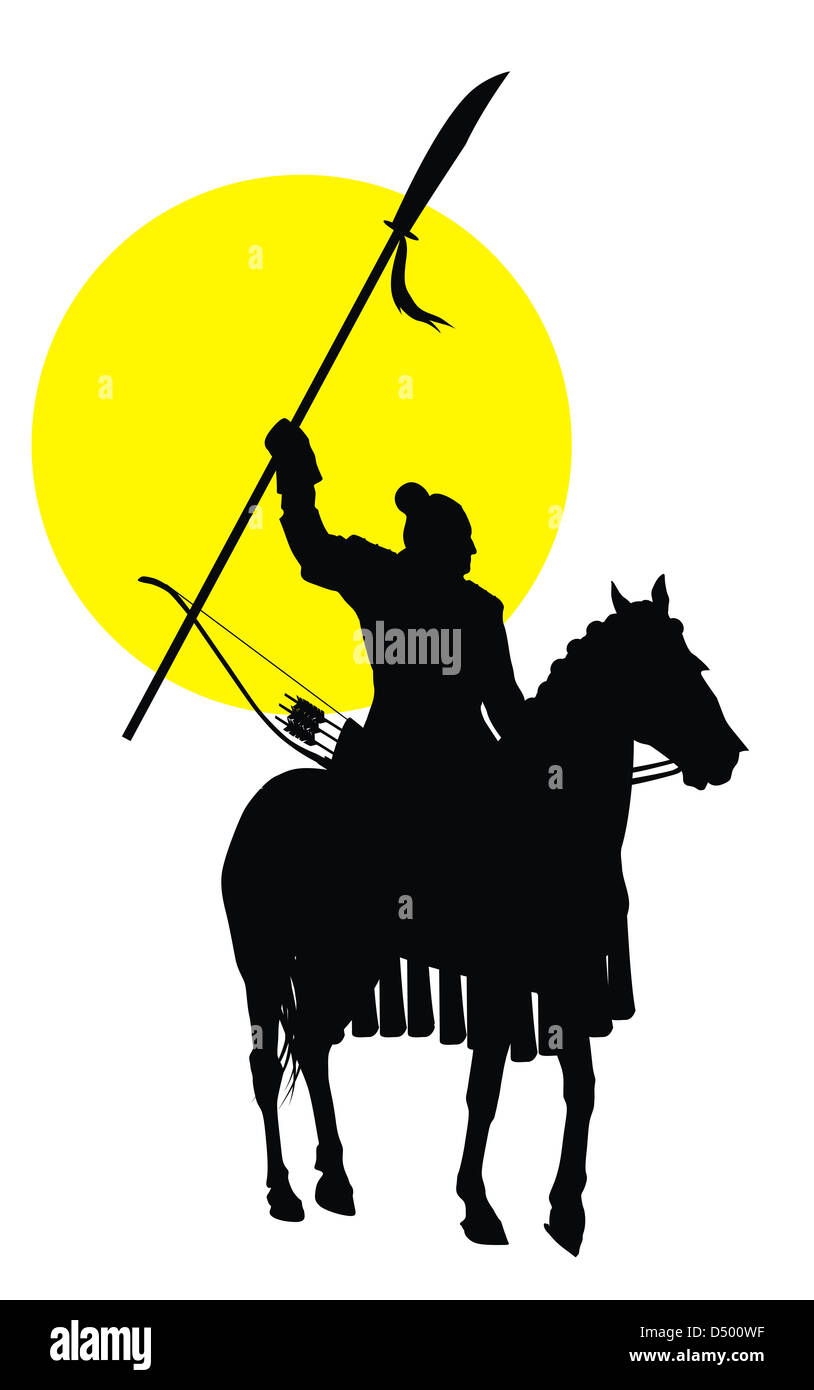 Chinese horseman Stock Photohttps://www.alamy.com/image-license-details/?v=1https://www.alamy.com/stock-photo-chinese-horseman-54705099.html
Chinese horseman Stock Photohttps://www.alamy.com/image-license-details/?v=1https://www.alamy.com/stock-photo-chinese-horseman-54705099.htmlRFD500WF–Chinese horseman
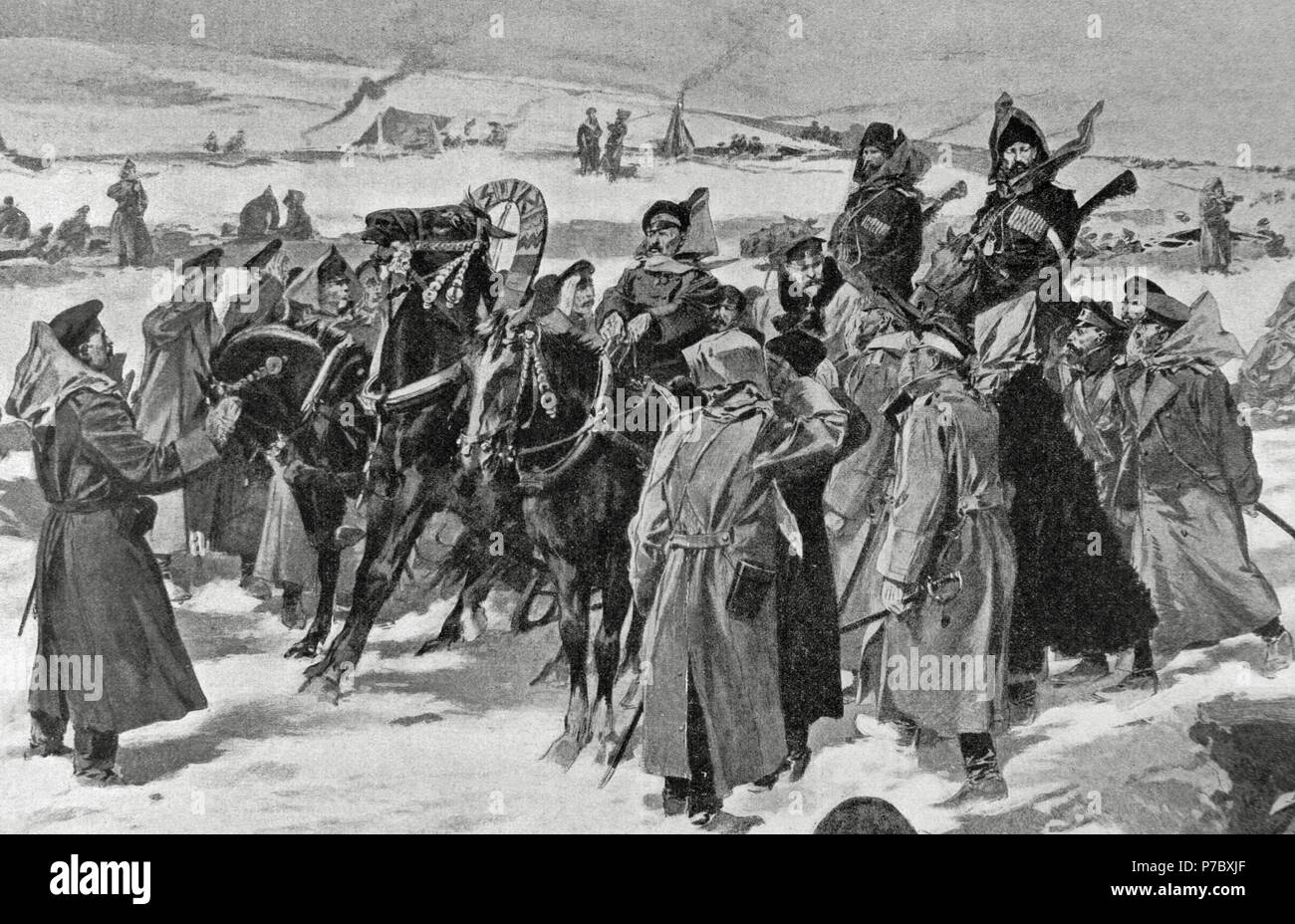 Russo-Japanese War (1904-1905). General Alexei Nikolayevich Kuropatkin (1848-1925), commander-in-Chief of the Russian armies in Manchuria, visits the Russian advanced troops in the Shaho river. Engraving in 'La Ilustracion Artistica'. Stock Photohttps://www.alamy.com/image-license-details/?v=1https://www.alamy.com/russo-japanese-war-1904-1905-general-alexei-nikolayevich-kuropatkin-1848-1925-commander-in-chief-of-the-russian-armies-in-manchuria-visits-the-russian-advanced-troops-in-the-shaho-river-engraving-in-la-ilustracion-artistica-image211089383.html
Russo-Japanese War (1904-1905). General Alexei Nikolayevich Kuropatkin (1848-1925), commander-in-Chief of the Russian armies in Manchuria, visits the Russian advanced troops in the Shaho river. Engraving in 'La Ilustracion Artistica'. Stock Photohttps://www.alamy.com/image-license-details/?v=1https://www.alamy.com/russo-japanese-war-1904-1905-general-alexei-nikolayevich-kuropatkin-1848-1925-commander-in-chief-of-the-russian-armies-in-manchuria-visits-the-russian-advanced-troops-in-the-shaho-river-engraving-in-la-ilustracion-artistica-image211089383.htmlRMP7BXJF–Russo-Japanese War (1904-1905). General Alexei Nikolayevich Kuropatkin (1848-1925), commander-in-Chief of the Russian armies in Manchuria, visits the Russian advanced troops in the Shaho river. Engraving in 'La Ilustracion Artistica'.
 Invasion of Mohammedan insurgents, Mongolia. Asia. Trip to Mongolia by Nikolai Mijailovich Przewalski in 1870-1873, Le Tour du Monde 1877 Stock Photohttps://www.alamy.com/image-license-details/?v=1https://www.alamy.com/invasion-of-mohammedan-insurgents-mongolia-asia-trip-to-mongolia-by-nikolai-mijailovich-przewalski-in-1870-1873-le-tour-du-monde-1877-image461659708.html
Invasion of Mohammedan insurgents, Mongolia. Asia. Trip to Mongolia by Nikolai Mijailovich Przewalski in 1870-1873, Le Tour du Monde 1877 Stock Photohttps://www.alamy.com/image-license-details/?v=1https://www.alamy.com/invasion-of-mohammedan-insurgents-mongolia-asia-trip-to-mongolia-by-nikolai-mijailovich-przewalski-in-1870-1873-le-tour-du-monde-1877-image461659708.htmlRM2HR2BJM–Invasion of Mohammedan insurgents, Mongolia. Asia. Trip to Mongolia by Nikolai Mijailovich Przewalski in 1870-1873, Le Tour du Monde 1877
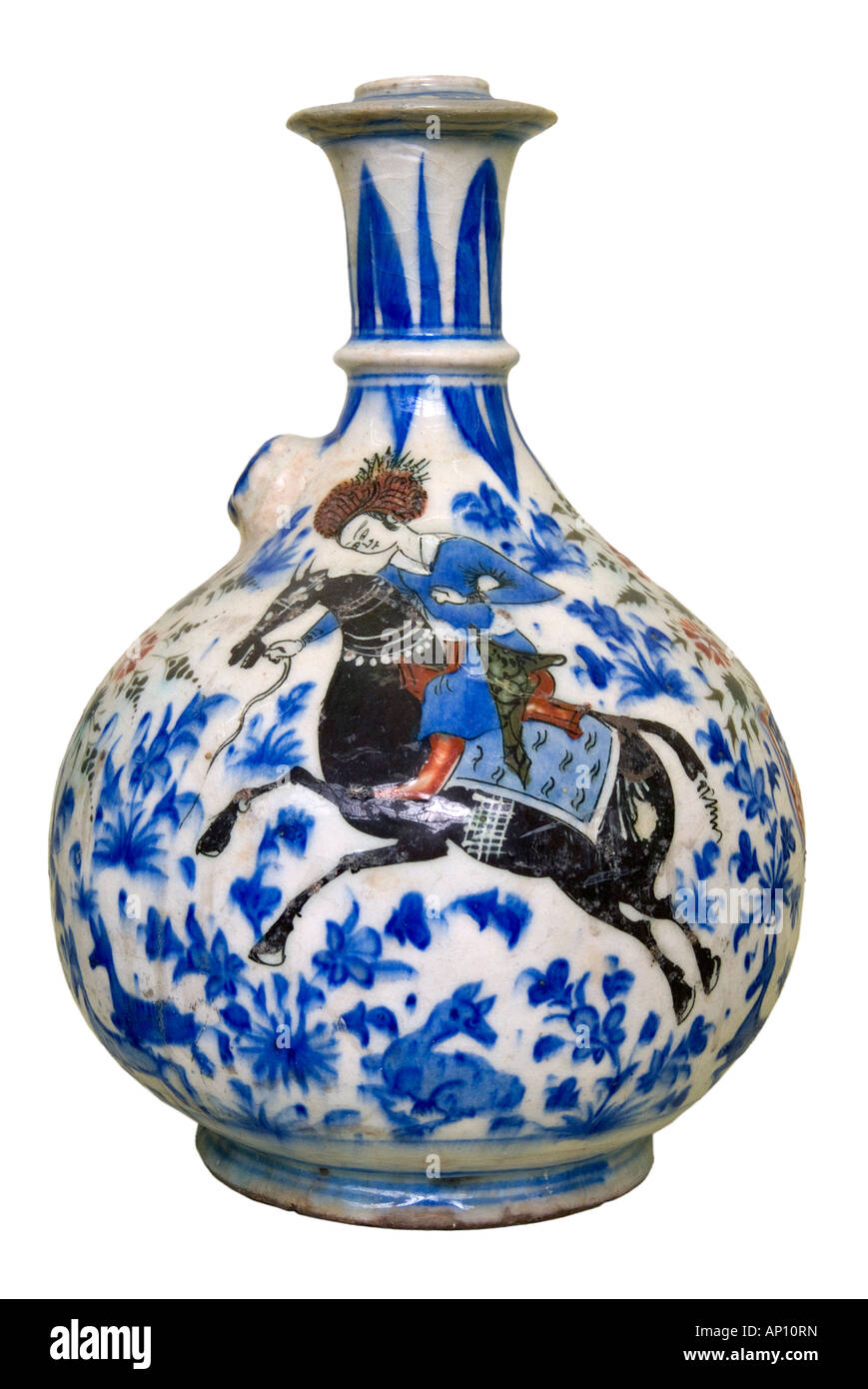 Iran water pipe pottery ceramic17 century underglazed pastime indulgence hashish opium blue horse rider cavalry stallion under Stock Photohttps://www.alamy.com/image-license-details/?v=1https://www.alamy.com/stock-photo-iran-water-pipe-pottery-ceramic17-century-underglazed-pastime-indulgence-15639512.html
Iran water pipe pottery ceramic17 century underglazed pastime indulgence hashish opium blue horse rider cavalry stallion under Stock Photohttps://www.alamy.com/image-license-details/?v=1https://www.alamy.com/stock-photo-iran-water-pipe-pottery-ceramic17-century-underglazed-pastime-indulgence-15639512.htmlRMAP10RN–Iran water pipe pottery ceramic17 century underglazed pastime indulgence hashish opium blue horse rider cavalry stallion under
 During a drought in 1974, farmers digging a well stumbled across one of the most amazing archaeological finds in modern history - the terracotta warriors. The terracotta army, thousands of soldiers, horses and chariots, had remained secretly on duty for some 2,000 years, guarding the nearby mausoleum of Qin Shu Huang / Qin Shi Huangdi, the first emperor of a unified China (r. 246 - 221 BCE). The infamous Qinshi is best known for his ruthless destruction of books and the slaughter of his enemies. Each of the terracotta figures, some standing, some on horseback, and some kneeling, bows drawn, Stock Photohttps://www.alamy.com/image-license-details/?v=1https://www.alamy.com/during-a-drought-in-1974-farmers-digging-a-well-stumbled-across-one-of-the-most-amazing-archaeological-finds-in-modern-history-the-terracotta-warriors-the-terracotta-army-thousands-of-soldiers-horses-and-chariots-had-remained-secretly-on-duty-for-some-2000-years-guarding-the-nearby-mausoleum-of-qin-shu-huang-qin-shi-huangdi-the-first-emperor-of-a-unified-china-r-246-221-bce-the-infamous-qinshi-is-best-known-for-his-ruthless-destruction-of-books-and-the-slaughter-of-his-enemies-each-of-the-terracotta-figures-some-standing-some-on-horseback-and-some-kneeling-bows-drawn-image344274535.html
During a drought in 1974, farmers digging a well stumbled across one of the most amazing archaeological finds in modern history - the terracotta warriors. The terracotta army, thousands of soldiers, horses and chariots, had remained secretly on duty for some 2,000 years, guarding the nearby mausoleum of Qin Shu Huang / Qin Shi Huangdi, the first emperor of a unified China (r. 246 - 221 BCE). The infamous Qinshi is best known for his ruthless destruction of books and the slaughter of his enemies. Each of the terracotta figures, some standing, some on horseback, and some kneeling, bows drawn, Stock Photohttps://www.alamy.com/image-license-details/?v=1https://www.alamy.com/during-a-drought-in-1974-farmers-digging-a-well-stumbled-across-one-of-the-most-amazing-archaeological-finds-in-modern-history-the-terracotta-warriors-the-terracotta-army-thousands-of-soldiers-horses-and-chariots-had-remained-secretly-on-duty-for-some-2000-years-guarding-the-nearby-mausoleum-of-qin-shu-huang-qin-shi-huangdi-the-first-emperor-of-a-unified-china-r-246-221-bce-the-infamous-qinshi-is-best-known-for-his-ruthless-destruction-of-books-and-the-slaughter-of-his-enemies-each-of-the-terracotta-figures-some-standing-some-on-horseback-and-some-kneeling-bows-drawn-image344274535.htmlRM2B031K3–During a drought in 1974, farmers digging a well stumbled across one of the most amazing archaeological finds in modern history - the terracotta warriors. The terracotta army, thousands of soldiers, horses and chariots, had remained secretly on duty for some 2,000 years, guarding the nearby mausoleum of Qin Shu Huang / Qin Shi Huangdi, the first emperor of a unified China (r. 246 - 221 BCE). The infamous Qinshi is best known for his ruthless destruction of books and the slaughter of his enemies. Each of the terracotta figures, some standing, some on horseback, and some kneeling, bows drawn,
 During a drought in 1974, farmers digging a well stumbled across one of the most amazing archaeological finds in modern history - the terracotta warriors. The terracotta army, thousands of soldiers, horses and chariots, had remained secretly on duty for some 2,000 years, guarding the nearby mausoleum of Qin Shu Huang / Qin Shi Huangdi, the first emperor of a unified China (r. 246 - 221 BCE). The infamous Qinshi is best known for his ruthless destruction of books and the slaughter of his enemies. Each of the terracotta figures, some standing, some on horseback, and some kneeling, bows drawn, Stock Photohttps://www.alamy.com/image-license-details/?v=1https://www.alamy.com/during-a-drought-in-1974-farmers-digging-a-well-stumbled-across-one-of-the-most-amazing-archaeological-finds-in-modern-history-the-terracotta-warriors-the-terracotta-army-thousands-of-soldiers-horses-and-chariots-had-remained-secretly-on-duty-for-some-2000-years-guarding-the-nearby-mausoleum-of-qin-shu-huang-qin-shi-huangdi-the-first-emperor-of-a-unified-china-r-246-221-bce-the-infamous-qinshi-is-best-known-for-his-ruthless-destruction-of-books-and-the-slaughter-of-his-enemies-each-of-the-terracotta-figures-some-standing-some-on-horseback-and-some-kneeling-bows-drawn-image344260288.html
During a drought in 1974, farmers digging a well stumbled across one of the most amazing archaeological finds in modern history - the terracotta warriors. The terracotta army, thousands of soldiers, horses and chariots, had remained secretly on duty for some 2,000 years, guarding the nearby mausoleum of Qin Shu Huang / Qin Shi Huangdi, the first emperor of a unified China (r. 246 - 221 BCE). The infamous Qinshi is best known for his ruthless destruction of books and the slaughter of his enemies. Each of the terracotta figures, some standing, some on horseback, and some kneeling, bows drawn, Stock Photohttps://www.alamy.com/image-license-details/?v=1https://www.alamy.com/during-a-drought-in-1974-farmers-digging-a-well-stumbled-across-one-of-the-most-amazing-archaeological-finds-in-modern-history-the-terracotta-warriors-the-terracotta-army-thousands-of-soldiers-horses-and-chariots-had-remained-secretly-on-duty-for-some-2000-years-guarding-the-nearby-mausoleum-of-qin-shu-huang-qin-shi-huangdi-the-first-emperor-of-a-unified-china-r-246-221-bce-the-infamous-qinshi-is-best-known-for-his-ruthless-destruction-of-books-and-the-slaughter-of-his-enemies-each-of-the-terracotta-figures-some-standing-some-on-horseback-and-some-kneeling-bows-drawn-image344260288.htmlRM2B02BE8–During a drought in 1974, farmers digging a well stumbled across one of the most amazing archaeological finds in modern history - the terracotta warriors. The terracotta army, thousands of soldiers, horses and chariots, had remained secretly on duty for some 2,000 years, guarding the nearby mausoleum of Qin Shu Huang / Qin Shi Huangdi, the first emperor of a unified China (r. 246 - 221 BCE). The infamous Qinshi is best known for his ruthless destruction of books and the slaughter of his enemies. Each of the terracotta figures, some standing, some on horseback, and some kneeling, bows drawn,
 The Manchu army takes Liaoyang. Manzhou shilu. Shenyang, 1930. Nurhaci on horseback and attended by soldiers carrying elaborate canopies, supervises the attack on the city of Liaoyang, Liaoyang province. It is defended by cannon mounted on wheels. A facsimile of the 1781 edition of the Manzhou shilu, illustrated description of the life of Nurhaci (1559-1626), whose descendants completed the conquest of China and the establishment of the Qing dynasty, 1644-1911. Image taken from Manzhou shilu. Originally published/produced in Shenyang, 1930. . Source: 15529.a.1.(7), p.6. Language: Chinese. Stock Photohttps://www.alamy.com/image-license-details/?v=1https://www.alamy.com/the-manchu-army-takes-liaoyang-manzhou-shilu-shenyang-1930-nurhaci-on-horseback-and-attended-by-soldiers-carrying-elaborate-canopies-supervises-the-attack-on-the-city-of-liaoyang-liaoyang-province-it-is-defended-by-cannon-mounted-on-wheels-a-facsimile-of-the-1781-edition-of-the-manzhou-shilu-illustrated-description-of-the-life-of-nurhaci-1559-1626-whose-descendants-completed-the-conquest-of-china-and-the-establishment-of-the-qing-dynasty-1644-1911-image-taken-from-manzhou-shilu-originally-publishedproduced-in-shenyang-1930-source-15529a17-p6-language-chinese-image226951146.html
The Manchu army takes Liaoyang. Manzhou shilu. Shenyang, 1930. Nurhaci on horseback and attended by soldiers carrying elaborate canopies, supervises the attack on the city of Liaoyang, Liaoyang province. It is defended by cannon mounted on wheels. A facsimile of the 1781 edition of the Manzhou shilu, illustrated description of the life of Nurhaci (1559-1626), whose descendants completed the conquest of China and the establishment of the Qing dynasty, 1644-1911. Image taken from Manzhou shilu. Originally published/produced in Shenyang, 1930. . Source: 15529.a.1.(7), p.6. Language: Chinese. Stock Photohttps://www.alamy.com/image-license-details/?v=1https://www.alamy.com/the-manchu-army-takes-liaoyang-manzhou-shilu-shenyang-1930-nurhaci-on-horseback-and-attended-by-soldiers-carrying-elaborate-canopies-supervises-the-attack-on-the-city-of-liaoyang-liaoyang-province-it-is-defended-by-cannon-mounted-on-wheels-a-facsimile-of-the-1781-edition-of-the-manzhou-shilu-illustrated-description-of-the-life-of-nurhaci-1559-1626-whose-descendants-completed-the-conquest-of-china-and-the-establishment-of-the-qing-dynasty-1644-1911-image-taken-from-manzhou-shilu-originally-publishedproduced-in-shenyang-1930-source-15529a17-p6-language-chinese-image226951146.htmlRMR56EE2–The Manchu army takes Liaoyang. Manzhou shilu. Shenyang, 1930. Nurhaci on horseback and attended by soldiers carrying elaborate canopies, supervises the attack on the city of Liaoyang, Liaoyang province. It is defended by cannon mounted on wheels. A facsimile of the 1781 edition of the Manzhou shilu, illustrated description of the life of Nurhaci (1559-1626), whose descendants completed the conquest of China and the establishment of the Qing dynasty, 1644-1911. Image taken from Manzhou shilu. Originally published/produced in Shenyang, 1930. . Source: 15529.a.1.(7), p.6. Language: Chinese.
 'The Emperor Teaou-Kwang reviewing his Guards, Palace of Peking', China, 19th century. Artist: JB Allen Stock Photohttps://www.alamy.com/image-license-details/?v=1https://www.alamy.com/the-emperor-teaou-kwang-reviewing-his-guards-palace-of-peking-china-19th-century-artist-jb-allen-image262765176.html
'The Emperor Teaou-Kwang reviewing his Guards, Palace of Peking', China, 19th century. Artist: JB Allen Stock Photohttps://www.alamy.com/image-license-details/?v=1https://www.alamy.com/the-emperor-teaou-kwang-reviewing-his-guards-palace-of-peking-china-19th-century-artist-jb-allen-image262765176.htmlRMW7DYJG–'The Emperor Teaou-Kwang reviewing his Guards, Palace of Peking', China, 19th century. Artist: JB Allen
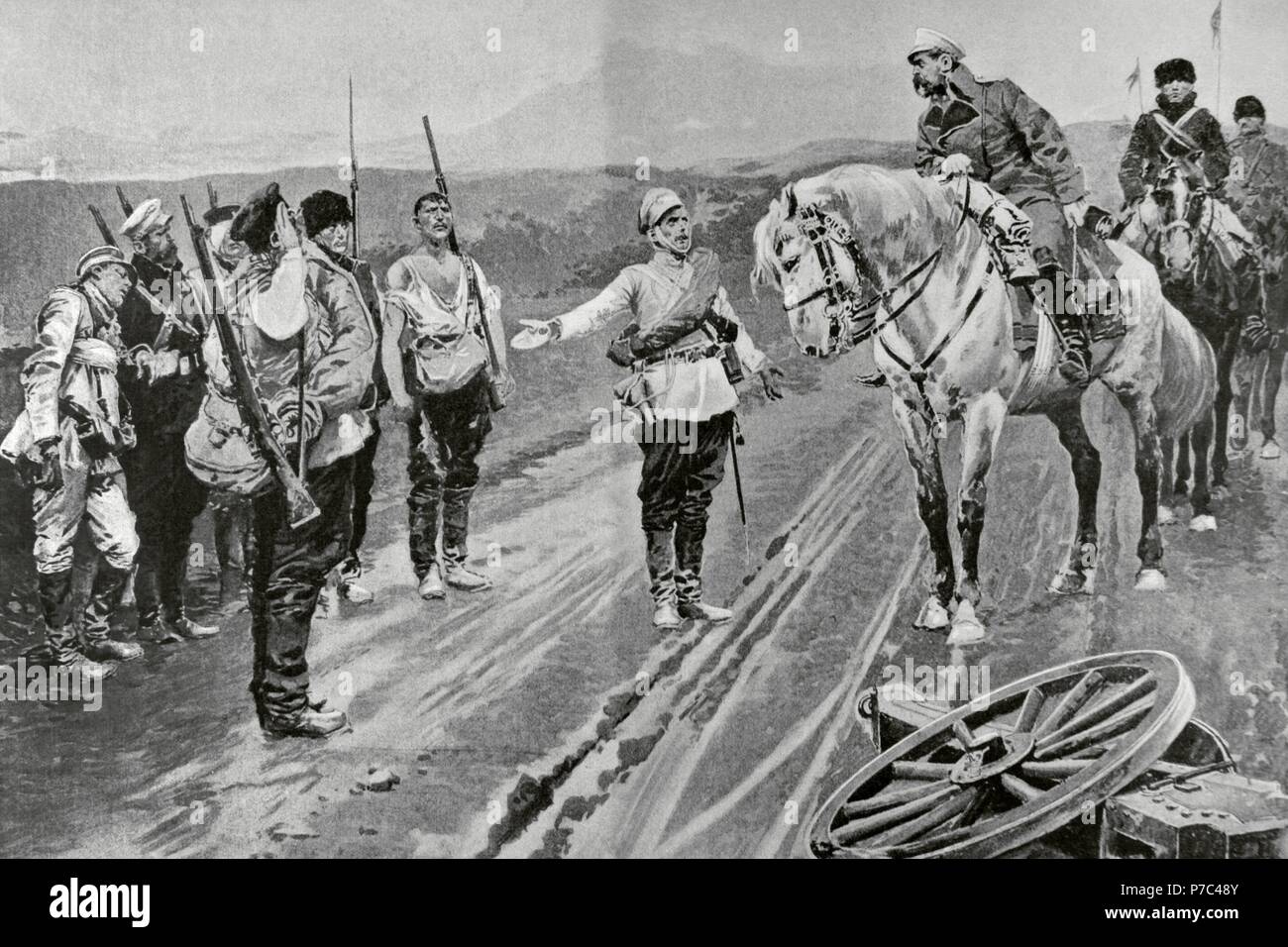 Russo-Japanese War (1904-1905). A General of the Russian division met an official of one of their regiments, accompanied by a few soldiers due to the casualties on the battle of Shaho river. Engraving in 'La Ilustracion Artistica'. Stock Photohttps://www.alamy.com/image-license-details/?v=1https://www.alamy.com/russo-japanese-war-1904-1905-a-general-of-the-russian-division-met-an-official-of-one-of-their-regiments-accompanied-by-a-few-soldiers-due-to-the-casualties-on-the-battle-of-shaho-river-engraving-in-la-ilustracion-artistica-image211093819.html
Russo-Japanese War (1904-1905). A General of the Russian division met an official of one of their regiments, accompanied by a few soldiers due to the casualties on the battle of Shaho river. Engraving in 'La Ilustracion Artistica'. Stock Photohttps://www.alamy.com/image-license-details/?v=1https://www.alamy.com/russo-japanese-war-1904-1905-a-general-of-the-russian-division-met-an-official-of-one-of-their-regiments-accompanied-by-a-few-soldiers-due-to-the-casualties-on-the-battle-of-shaho-river-engraving-in-la-ilustracion-artistica-image211093819.htmlRMP7C48Y–Russo-Japanese War (1904-1905). A General of the Russian division met an official of one of their regiments, accompanied by a few soldiers due to the casualties on the battle of Shaho river. Engraving in 'La Ilustracion Artistica'.
 During a drought in 1974, farmers digging a well stumbled across one of the most amazing archaeological finds in modern history - the terracotta warriors. The terracotta army, thousands of soldiers, horses and chariots, had remained secretly on duty for some 2,000 years, guarding the nearby mausoleum of Qin Shu Huang / Qin Shi Huangdi, the first emperor of a unified China (r. 246 - 221 BCE). The infamous Qinshi is best known for his ruthless destruction of books and the slaughter of his enemies. Each of the terracotta figures, some standing, some on horseback, and some kneeling, bows drawn, Stock Photohttps://www.alamy.com/image-license-details/?v=1https://www.alamy.com/during-a-drought-in-1974-farmers-digging-a-well-stumbled-across-one-of-the-most-amazing-archaeological-finds-in-modern-history-the-terracotta-warriors-the-terracotta-army-thousands-of-soldiers-horses-and-chariots-had-remained-secretly-on-duty-for-some-2000-years-guarding-the-nearby-mausoleum-of-qin-shu-huang-qin-shi-huangdi-the-first-emperor-of-a-unified-china-r-246-221-bce-the-infamous-qinshi-is-best-known-for-his-ruthless-destruction-of-books-and-the-slaughter-of-his-enemies-each-of-the-terracotta-figures-some-standing-some-on-horseback-and-some-kneeling-bows-drawn-image344260381.html
During a drought in 1974, farmers digging a well stumbled across one of the most amazing archaeological finds in modern history - the terracotta warriors. The terracotta army, thousands of soldiers, horses and chariots, had remained secretly on duty for some 2,000 years, guarding the nearby mausoleum of Qin Shu Huang / Qin Shi Huangdi, the first emperor of a unified China (r. 246 - 221 BCE). The infamous Qinshi is best known for his ruthless destruction of books and the slaughter of his enemies. Each of the terracotta figures, some standing, some on horseback, and some kneeling, bows drawn, Stock Photohttps://www.alamy.com/image-license-details/?v=1https://www.alamy.com/during-a-drought-in-1974-farmers-digging-a-well-stumbled-across-one-of-the-most-amazing-archaeological-finds-in-modern-history-the-terracotta-warriors-the-terracotta-army-thousands-of-soldiers-horses-and-chariots-had-remained-secretly-on-duty-for-some-2000-years-guarding-the-nearby-mausoleum-of-qin-shu-huang-qin-shi-huangdi-the-first-emperor-of-a-unified-china-r-246-221-bce-the-infamous-qinshi-is-best-known-for-his-ruthless-destruction-of-books-and-the-slaughter-of-his-enemies-each-of-the-terracotta-figures-some-standing-some-on-horseback-and-some-kneeling-bows-drawn-image344260381.htmlRM2B02BHH–During a drought in 1974, farmers digging a well stumbled across one of the most amazing archaeological finds in modern history - the terracotta warriors. The terracotta army, thousands of soldiers, horses and chariots, had remained secretly on duty for some 2,000 years, guarding the nearby mausoleum of Qin Shu Huang / Qin Shi Huangdi, the first emperor of a unified China (r. 246 - 221 BCE). The infamous Qinshi is best known for his ruthless destruction of books and the slaughter of his enemies. Each of the terracotta figures, some standing, some on horseback, and some kneeling, bows drawn,
 During a drought in 1974, farmers digging a well stumbled across one of the most amazing archaeological finds in modern history - the terracotta warriors. The terracotta army, thousands of soldiers, horses and chariots, had remained secretly on duty for some 2,000 years, guarding the nearby mausoleum of Qin Shu Huang / Qin Shi Huangdi, the first emperor of a unified China (r. 246 - 221 BCE). The infamous Qinshi is best known for his ruthless destruction of books and the slaughter of his enemies. Each of the terracotta figures, some standing, some on horseback, and some kneeling, bows drawn, Stock Photohttps://www.alamy.com/image-license-details/?v=1https://www.alamy.com/during-a-drought-in-1974-farmers-digging-a-well-stumbled-across-one-of-the-most-amazing-archaeological-finds-in-modern-history-the-terracotta-warriors-the-terracotta-army-thousands-of-soldiers-horses-and-chariots-had-remained-secretly-on-duty-for-some-2000-years-guarding-the-nearby-mausoleum-of-qin-shu-huang-qin-shi-huangdi-the-first-emperor-of-a-unified-china-r-246-221-bce-the-infamous-qinshi-is-best-known-for-his-ruthless-destruction-of-books-and-the-slaughter-of-his-enemies-each-of-the-terracotta-figures-some-standing-some-on-horseback-and-some-kneeling-bows-drawn-image344260382.html
During a drought in 1974, farmers digging a well stumbled across one of the most amazing archaeological finds in modern history - the terracotta warriors. The terracotta army, thousands of soldiers, horses and chariots, had remained secretly on duty for some 2,000 years, guarding the nearby mausoleum of Qin Shu Huang / Qin Shi Huangdi, the first emperor of a unified China (r. 246 - 221 BCE). The infamous Qinshi is best known for his ruthless destruction of books and the slaughter of his enemies. Each of the terracotta figures, some standing, some on horseback, and some kneeling, bows drawn, Stock Photohttps://www.alamy.com/image-license-details/?v=1https://www.alamy.com/during-a-drought-in-1974-farmers-digging-a-well-stumbled-across-one-of-the-most-amazing-archaeological-finds-in-modern-history-the-terracotta-warriors-the-terracotta-army-thousands-of-soldiers-horses-and-chariots-had-remained-secretly-on-duty-for-some-2000-years-guarding-the-nearby-mausoleum-of-qin-shu-huang-qin-shi-huangdi-the-first-emperor-of-a-unified-china-r-246-221-bce-the-infamous-qinshi-is-best-known-for-his-ruthless-destruction-of-books-and-the-slaughter-of-his-enemies-each-of-the-terracotta-figures-some-standing-some-on-horseback-and-some-kneeling-bows-drawn-image344260382.htmlRM2B02BHJ–During a drought in 1974, farmers digging a well stumbled across one of the most amazing archaeological finds in modern history - the terracotta warriors. The terracotta army, thousands of soldiers, horses and chariots, had remained secretly on duty for some 2,000 years, guarding the nearby mausoleum of Qin Shu Huang / Qin Shi Huangdi, the first emperor of a unified China (r. 246 - 221 BCE). The infamous Qinshi is best known for his ruthless destruction of books and the slaughter of his enemies. Each of the terracotta figures, some standing, some on horseback, and some kneeling, bows drawn,
 During a drought in 1974, farmers digging a well stumbled across one of the most amazing archaeological finds in modern history - the terracotta warriors. The terracotta army, thousands of soldiers, horses and chariots, had remained secretly on duty for some 2,000 years, guarding the nearby mausoleum of Qin Shu Huang / Qin Shi Huangdi, the first emperor of a unified China (r. 246 - 221 BCE). The infamous Qinshi is best known for his ruthless destruction of books and the slaughter of his enemies. Each of the terracotta figures, some standing, some on horseback, and some kneeling, bows drawn, Stock Photohttps://www.alamy.com/image-license-details/?v=1https://www.alamy.com/during-a-drought-in-1974-farmers-digging-a-well-stumbled-across-one-of-the-most-amazing-archaeological-finds-in-modern-history-the-terracotta-warriors-the-terracotta-army-thousands-of-soldiers-horses-and-chariots-had-remained-secretly-on-duty-for-some-2000-years-guarding-the-nearby-mausoleum-of-qin-shu-huang-qin-shi-huangdi-the-first-emperor-of-a-unified-china-r-246-221-bce-the-infamous-qinshi-is-best-known-for-his-ruthless-destruction-of-books-and-the-slaughter-of-his-enemies-each-of-the-terracotta-figures-some-standing-some-on-horseback-and-some-kneeling-bows-drawn-image344260384.html
During a drought in 1974, farmers digging a well stumbled across one of the most amazing archaeological finds in modern history - the terracotta warriors. The terracotta army, thousands of soldiers, horses and chariots, had remained secretly on duty for some 2,000 years, guarding the nearby mausoleum of Qin Shu Huang / Qin Shi Huangdi, the first emperor of a unified China (r. 246 - 221 BCE). The infamous Qinshi is best known for his ruthless destruction of books and the slaughter of his enemies. Each of the terracotta figures, some standing, some on horseback, and some kneeling, bows drawn, Stock Photohttps://www.alamy.com/image-license-details/?v=1https://www.alamy.com/during-a-drought-in-1974-farmers-digging-a-well-stumbled-across-one-of-the-most-amazing-archaeological-finds-in-modern-history-the-terracotta-warriors-the-terracotta-army-thousands-of-soldiers-horses-and-chariots-had-remained-secretly-on-duty-for-some-2000-years-guarding-the-nearby-mausoleum-of-qin-shu-huang-qin-shi-huangdi-the-first-emperor-of-a-unified-china-r-246-221-bce-the-infamous-qinshi-is-best-known-for-his-ruthless-destruction-of-books-and-the-slaughter-of-his-enemies-each-of-the-terracotta-figures-some-standing-some-on-horseback-and-some-kneeling-bows-drawn-image344260384.htmlRM2B02BHM–During a drought in 1974, farmers digging a well stumbled across one of the most amazing archaeological finds in modern history - the terracotta warriors. The terracotta army, thousands of soldiers, horses and chariots, had remained secretly on duty for some 2,000 years, guarding the nearby mausoleum of Qin Shu Huang / Qin Shi Huangdi, the first emperor of a unified China (r. 246 - 221 BCE). The infamous Qinshi is best known for his ruthless destruction of books and the slaughter of his enemies. Each of the terracotta figures, some standing, some on horseback, and some kneeling, bows drawn,
 During a drought in 1974, farmers digging a well stumbled across one of the most amazing archaeological finds in modern history - the terracotta warriors. The terracotta army, thousands of soldiers, horses and chariots, had remained secretly on duty for some 2,000 years, guarding the nearby mausoleum of Qin Shu Huang / Qin Shi Huangdi, the first emperor of a unified China (r. 246 - 221 BCE). The infamous Qinshi is best known for his ruthless destruction of books and the slaughter of his enemies. Each of the terracotta figures, some standing, some on horseback, and some kneeling, bows drawn, Stock Photohttps://www.alamy.com/image-license-details/?v=1https://www.alamy.com/during-a-drought-in-1974-farmers-digging-a-well-stumbled-across-one-of-the-most-amazing-archaeological-finds-in-modern-history-the-terracotta-warriors-the-terracotta-army-thousands-of-soldiers-horses-and-chariots-had-remained-secretly-on-duty-for-some-2000-years-guarding-the-nearby-mausoleum-of-qin-shu-huang-qin-shi-huangdi-the-first-emperor-of-a-unified-china-r-246-221-bce-the-infamous-qinshi-is-best-known-for-his-ruthless-destruction-of-books-and-the-slaughter-of-his-enemies-each-of-the-terracotta-figures-some-standing-some-on-horseback-and-some-kneeling-bows-drawn-image344260401.html
During a drought in 1974, farmers digging a well stumbled across one of the most amazing archaeological finds in modern history - the terracotta warriors. The terracotta army, thousands of soldiers, horses and chariots, had remained secretly on duty for some 2,000 years, guarding the nearby mausoleum of Qin Shu Huang / Qin Shi Huangdi, the first emperor of a unified China (r. 246 - 221 BCE). The infamous Qinshi is best known for his ruthless destruction of books and the slaughter of his enemies. Each of the terracotta figures, some standing, some on horseback, and some kneeling, bows drawn, Stock Photohttps://www.alamy.com/image-license-details/?v=1https://www.alamy.com/during-a-drought-in-1974-farmers-digging-a-well-stumbled-across-one-of-the-most-amazing-archaeological-finds-in-modern-history-the-terracotta-warriors-the-terracotta-army-thousands-of-soldiers-horses-and-chariots-had-remained-secretly-on-duty-for-some-2000-years-guarding-the-nearby-mausoleum-of-qin-shu-huang-qin-shi-huangdi-the-first-emperor-of-a-unified-china-r-246-221-bce-the-infamous-qinshi-is-best-known-for-his-ruthless-destruction-of-books-and-the-slaughter-of-his-enemies-each-of-the-terracotta-figures-some-standing-some-on-horseback-and-some-kneeling-bows-drawn-image344260401.htmlRM2B02BJ9–During a drought in 1974, farmers digging a well stumbled across one of the most amazing archaeological finds in modern history - the terracotta warriors. The terracotta army, thousands of soldiers, horses and chariots, had remained secretly on duty for some 2,000 years, guarding the nearby mausoleum of Qin Shu Huang / Qin Shi Huangdi, the first emperor of a unified China (r. 246 - 221 BCE). The infamous Qinshi is best known for his ruthless destruction of books and the slaughter of his enemies. Each of the terracotta figures, some standing, some on horseback, and some kneeling, bows drawn,
 During a drought in 1974, farmers digging a well stumbled across one of the most amazing archaeological finds in modern history - the terracotta warriors. The terracotta army, thousands of soldiers, horses and chariots, had remained secretly on duty for some 2,000 years, guarding the nearby mausoleum of Qin Shu Huang / Qin Shi Huangdi, the first emperor of a unified China (r. 246 - 221 BCE). The infamous Qinshi is best known for his ruthless destruction of books and the slaughter of his enemies. Each of the terracotta figures, some standing, some on horseback, and some kneeling, bows drawn, Stock Photohttps://www.alamy.com/image-license-details/?v=1https://www.alamy.com/during-a-drought-in-1974-farmers-digging-a-well-stumbled-across-one-of-the-most-amazing-archaeological-finds-in-modern-history-the-terracotta-warriors-the-terracotta-army-thousands-of-soldiers-horses-and-chariots-had-remained-secretly-on-duty-for-some-2000-years-guarding-the-nearby-mausoleum-of-qin-shu-huang-qin-shi-huangdi-the-first-emperor-of-a-unified-china-r-246-221-bce-the-infamous-qinshi-is-best-known-for-his-ruthless-destruction-of-books-and-the-slaughter-of-his-enemies-each-of-the-terracotta-figures-some-standing-some-on-horseback-and-some-kneeling-bows-drawn-image344260385.html
During a drought in 1974, farmers digging a well stumbled across one of the most amazing archaeological finds in modern history - the terracotta warriors. The terracotta army, thousands of soldiers, horses and chariots, had remained secretly on duty for some 2,000 years, guarding the nearby mausoleum of Qin Shu Huang / Qin Shi Huangdi, the first emperor of a unified China (r. 246 - 221 BCE). The infamous Qinshi is best known for his ruthless destruction of books and the slaughter of his enemies. Each of the terracotta figures, some standing, some on horseback, and some kneeling, bows drawn, Stock Photohttps://www.alamy.com/image-license-details/?v=1https://www.alamy.com/during-a-drought-in-1974-farmers-digging-a-well-stumbled-across-one-of-the-most-amazing-archaeological-finds-in-modern-history-the-terracotta-warriors-the-terracotta-army-thousands-of-soldiers-horses-and-chariots-had-remained-secretly-on-duty-for-some-2000-years-guarding-the-nearby-mausoleum-of-qin-shu-huang-qin-shi-huangdi-the-first-emperor-of-a-unified-china-r-246-221-bce-the-infamous-qinshi-is-best-known-for-his-ruthless-destruction-of-books-and-the-slaughter-of-his-enemies-each-of-the-terracotta-figures-some-standing-some-on-horseback-and-some-kneeling-bows-drawn-image344260385.htmlRM2B02BHN–During a drought in 1974, farmers digging a well stumbled across one of the most amazing archaeological finds in modern history - the terracotta warriors. The terracotta army, thousands of soldiers, horses and chariots, had remained secretly on duty for some 2,000 years, guarding the nearby mausoleum of Qin Shu Huang / Qin Shi Huangdi, the first emperor of a unified China (r. 246 - 221 BCE). The infamous Qinshi is best known for his ruthless destruction of books and the slaughter of his enemies. Each of the terracotta figures, some standing, some on horseback, and some kneeling, bows drawn,
 During a drought in 1974, farmers digging a well stumbled across one of the most amazing archaeological finds in modern history - the terracotta warriors. The terracotta army, thousands of soldiers, horses and chariots, had remained secretly on duty for some 2,000 years, guarding the nearby mausoleum of Qin Shu Huang / Qin Shi Huangdi, the first emperor of a unified China (r. 246 - 221 BCE). The infamous Qinshi is best known for his ruthless destruction of books and the slaughter of his enemies. Each of the terracotta figures, some standing, some on horseback, and some kneeling, bows drawn, Stock Photohttps://www.alamy.com/image-license-details/?v=1https://www.alamy.com/during-a-drought-in-1974-farmers-digging-a-well-stumbled-across-one-of-the-most-amazing-archaeological-finds-in-modern-history-the-terracotta-warriors-the-terracotta-army-thousands-of-soldiers-horses-and-chariots-had-remained-secretly-on-duty-for-some-2000-years-guarding-the-nearby-mausoleum-of-qin-shu-huang-qin-shi-huangdi-the-first-emperor-of-a-unified-china-r-246-221-bce-the-infamous-qinshi-is-best-known-for-his-ruthless-destruction-of-books-and-the-slaughter-of-his-enemies-each-of-the-terracotta-figures-some-standing-some-on-horseback-and-some-kneeling-bows-drawn-image344260400.html
During a drought in 1974, farmers digging a well stumbled across one of the most amazing archaeological finds in modern history - the terracotta warriors. The terracotta army, thousands of soldiers, horses and chariots, had remained secretly on duty for some 2,000 years, guarding the nearby mausoleum of Qin Shu Huang / Qin Shi Huangdi, the first emperor of a unified China (r. 246 - 221 BCE). The infamous Qinshi is best known for his ruthless destruction of books and the slaughter of his enemies. Each of the terracotta figures, some standing, some on horseback, and some kneeling, bows drawn, Stock Photohttps://www.alamy.com/image-license-details/?v=1https://www.alamy.com/during-a-drought-in-1974-farmers-digging-a-well-stumbled-across-one-of-the-most-amazing-archaeological-finds-in-modern-history-the-terracotta-warriors-the-terracotta-army-thousands-of-soldiers-horses-and-chariots-had-remained-secretly-on-duty-for-some-2000-years-guarding-the-nearby-mausoleum-of-qin-shu-huang-qin-shi-huangdi-the-first-emperor-of-a-unified-china-r-246-221-bce-the-infamous-qinshi-is-best-known-for-his-ruthless-destruction-of-books-and-the-slaughter-of-his-enemies-each-of-the-terracotta-figures-some-standing-some-on-horseback-and-some-kneeling-bows-drawn-image344260400.htmlRM2B02BJ8–During a drought in 1974, farmers digging a well stumbled across one of the most amazing archaeological finds in modern history - the terracotta warriors. The terracotta army, thousands of soldiers, horses and chariots, had remained secretly on duty for some 2,000 years, guarding the nearby mausoleum of Qin Shu Huang / Qin Shi Huangdi, the first emperor of a unified China (r. 246 - 221 BCE). The infamous Qinshi is best known for his ruthless destruction of books and the slaughter of his enemies. Each of the terracotta figures, some standing, some on horseback, and some kneeling, bows drawn,
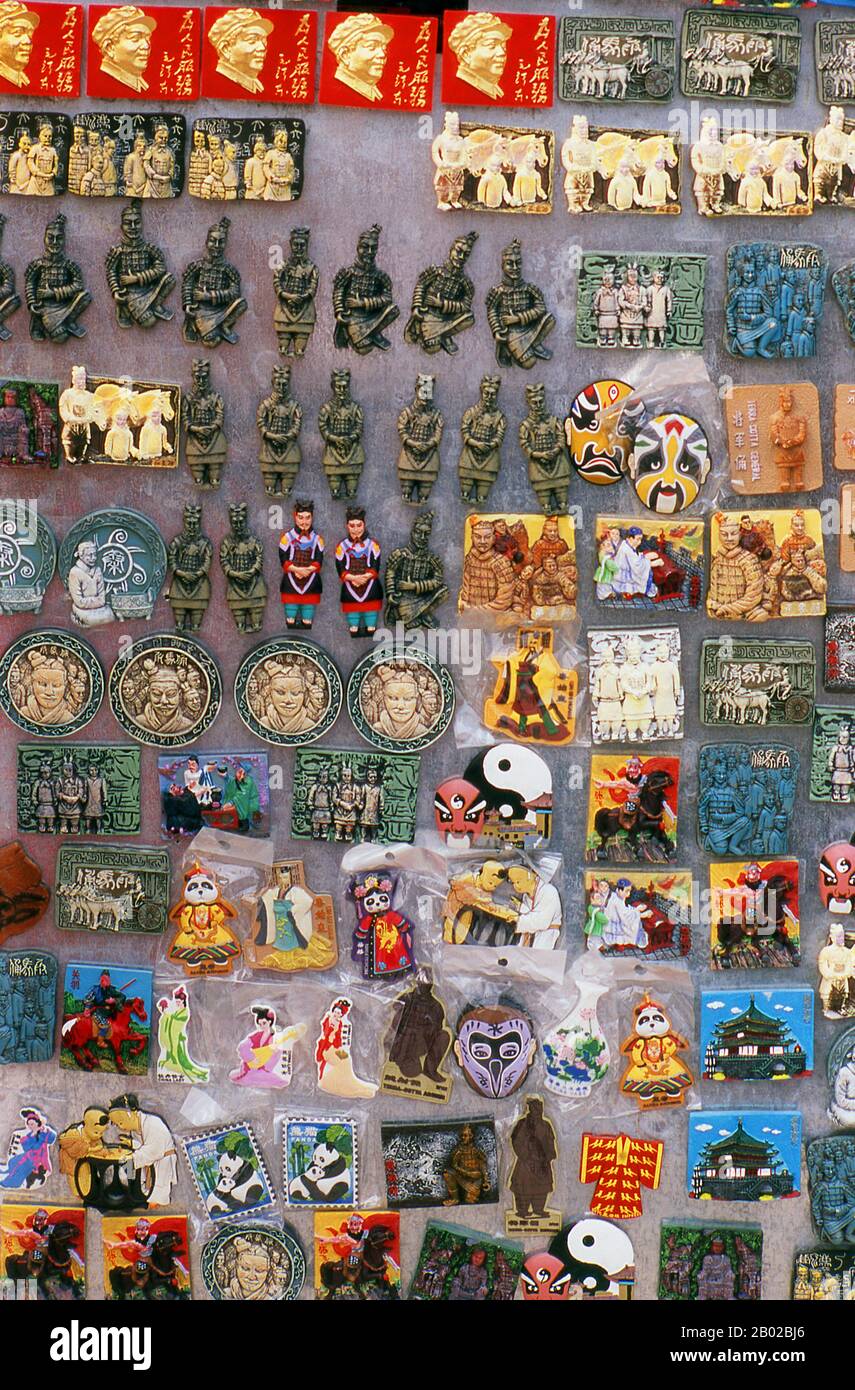 During a drought in 1974, farmers digging a well stumbled across one of the most amazing archaeological finds in modern history - the terracotta warriors. The terracotta army, thousands of soldiers, horses and chariots, had remained secretly on duty for some 2,000 years, guarding the nearby mausoleum of Qin Shu Huang / Qin Shi Huangdi, the first emperor of a unified China (r. 246 - 221 BCE). The infamous Qinshi is best known for his ruthless destruction of books and the slaughter of his enemies. Each of the terracotta figures, some standing, some on horseback, and some kneeling, bows drawn, Stock Photohttps://www.alamy.com/image-license-details/?v=1https://www.alamy.com/during-a-drought-in-1974-farmers-digging-a-well-stumbled-across-one-of-the-most-amazing-archaeological-finds-in-modern-history-the-terracotta-warriors-the-terracotta-army-thousands-of-soldiers-horses-and-chariots-had-remained-secretly-on-duty-for-some-2000-years-guarding-the-nearby-mausoleum-of-qin-shu-huang-qin-shi-huangdi-the-first-emperor-of-a-unified-china-r-246-221-bce-the-infamous-qinshi-is-best-known-for-his-ruthless-destruction-of-books-and-the-slaughter-of-his-enemies-each-of-the-terracotta-figures-some-standing-some-on-horseback-and-some-kneeling-bows-drawn-image344260398.html
During a drought in 1974, farmers digging a well stumbled across one of the most amazing archaeological finds in modern history - the terracotta warriors. The terracotta army, thousands of soldiers, horses and chariots, had remained secretly on duty for some 2,000 years, guarding the nearby mausoleum of Qin Shu Huang / Qin Shi Huangdi, the first emperor of a unified China (r. 246 - 221 BCE). The infamous Qinshi is best known for his ruthless destruction of books and the slaughter of his enemies. Each of the terracotta figures, some standing, some on horseback, and some kneeling, bows drawn, Stock Photohttps://www.alamy.com/image-license-details/?v=1https://www.alamy.com/during-a-drought-in-1974-farmers-digging-a-well-stumbled-across-one-of-the-most-amazing-archaeological-finds-in-modern-history-the-terracotta-warriors-the-terracotta-army-thousands-of-soldiers-horses-and-chariots-had-remained-secretly-on-duty-for-some-2000-years-guarding-the-nearby-mausoleum-of-qin-shu-huang-qin-shi-huangdi-the-first-emperor-of-a-unified-china-r-246-221-bce-the-infamous-qinshi-is-best-known-for-his-ruthless-destruction-of-books-and-the-slaughter-of-his-enemies-each-of-the-terracotta-figures-some-standing-some-on-horseback-and-some-kneeling-bows-drawn-image344260398.htmlRM2B02BJ6–During a drought in 1974, farmers digging a well stumbled across one of the most amazing archaeological finds in modern history - the terracotta warriors. The terracotta army, thousands of soldiers, horses and chariots, had remained secretly on duty for some 2,000 years, guarding the nearby mausoleum of Qin Shu Huang / Qin Shi Huangdi, the first emperor of a unified China (r. 246 - 221 BCE). The infamous Qinshi is best known for his ruthless destruction of books and the slaughter of his enemies. Each of the terracotta figures, some standing, some on horseback, and some kneeling, bows drawn,
 China: Drawing of a mounted archer, Ming Dynasty (1368-1644), 16th century. Stock Photohttps://www.alamy.com/image-license-details/?v=1https://www.alamy.com/china-drawing-of-a-mounted-archer-ming-dynasty-1368-1644-16th-century-image344231725.html
China: Drawing of a mounted archer, Ming Dynasty (1368-1644), 16th century. Stock Photohttps://www.alamy.com/image-license-details/?v=1https://www.alamy.com/china-drawing-of-a-mounted-archer-ming-dynasty-1368-1644-16th-century-image344231725.htmlRM2B01325–China: Drawing of a mounted archer, Ming Dynasty (1368-1644), 16th century.
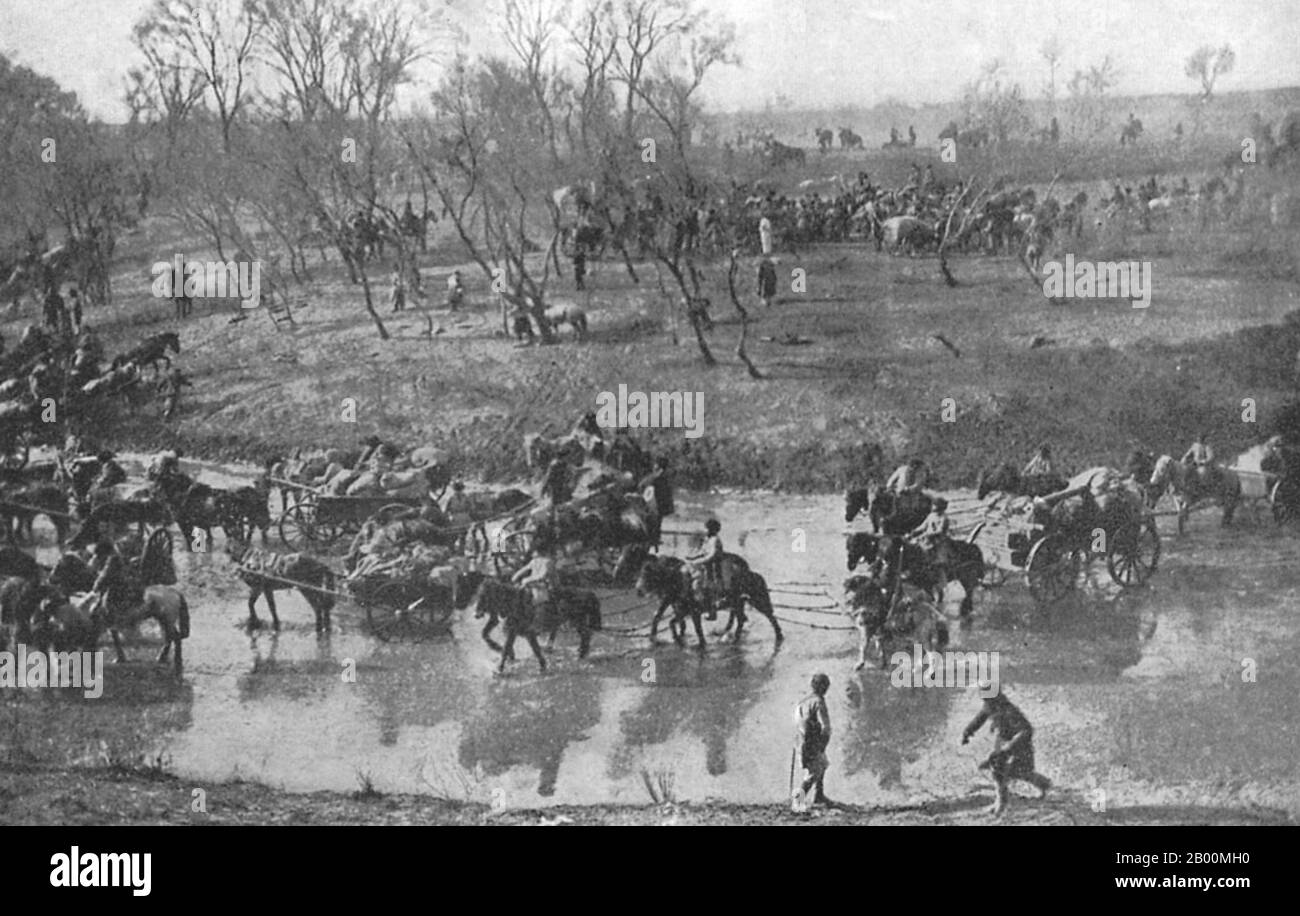 China: Retreat of the Russian Army after the Battle of Mukden (1905), (Russo-Japanese War, 8 February 1904 – 5 September 1905). The Russo-Japanese War (8 February 1904 – 5 September 1905) was the first great war of the 20th century which grew out of the rival imperial ambitions of the Russian Empire and Japanese Empire over Manchuria and Korea. The resulting campaigns, in which the Japanese military attained victory over the Russian forces arrayed against them, were unexpected. Stock Photohttps://www.alamy.com/image-license-details/?v=1https://www.alamy.com/china-retreat-of-the-russian-army-after-the-battle-of-mukden-1905-russo-japanese-war-8-february-1904-5-september-1905-the-russo-japanese-war-8-february-1904-5-september-1905-was-the-first-great-war-of-the-20th-century-which-grew-out-of-the-rival-imperial-ambitions-of-the-russian-empire-and-japanese-empire-over-manchuria-and-korea-the-resulting-campaigns-in-which-the-japanese-military-attained-victory-over-the-russian-forces-arrayed-against-them-were-unexpected-image344223516.html
China: Retreat of the Russian Army after the Battle of Mukden (1905), (Russo-Japanese War, 8 February 1904 – 5 September 1905). The Russo-Japanese War (8 February 1904 – 5 September 1905) was the first great war of the 20th century which grew out of the rival imperial ambitions of the Russian Empire and Japanese Empire over Manchuria and Korea. The resulting campaigns, in which the Japanese military attained victory over the Russian forces arrayed against them, were unexpected. Stock Photohttps://www.alamy.com/image-license-details/?v=1https://www.alamy.com/china-retreat-of-the-russian-army-after-the-battle-of-mukden-1905-russo-japanese-war-8-february-1904-5-september-1905-the-russo-japanese-war-8-february-1904-5-september-1905-was-the-first-great-war-of-the-20th-century-which-grew-out-of-the-rival-imperial-ambitions-of-the-russian-empire-and-japanese-empire-over-manchuria-and-korea-the-resulting-campaigns-in-which-the-japanese-military-attained-victory-over-the-russian-forces-arrayed-against-them-were-unexpected-image344223516.htmlRM2B00MH0–China: Retreat of the Russian Army after the Battle of Mukden (1905), (Russo-Japanese War, 8 February 1904 – 5 September 1905). The Russo-Japanese War (8 February 1904 – 5 September 1905) was the first great war of the 20th century which grew out of the rival imperial ambitions of the Russian Empire and Japanese Empire over Manchuria and Korea. The resulting campaigns, in which the Japanese military attained victory over the Russian forces arrayed against them, were unexpected.
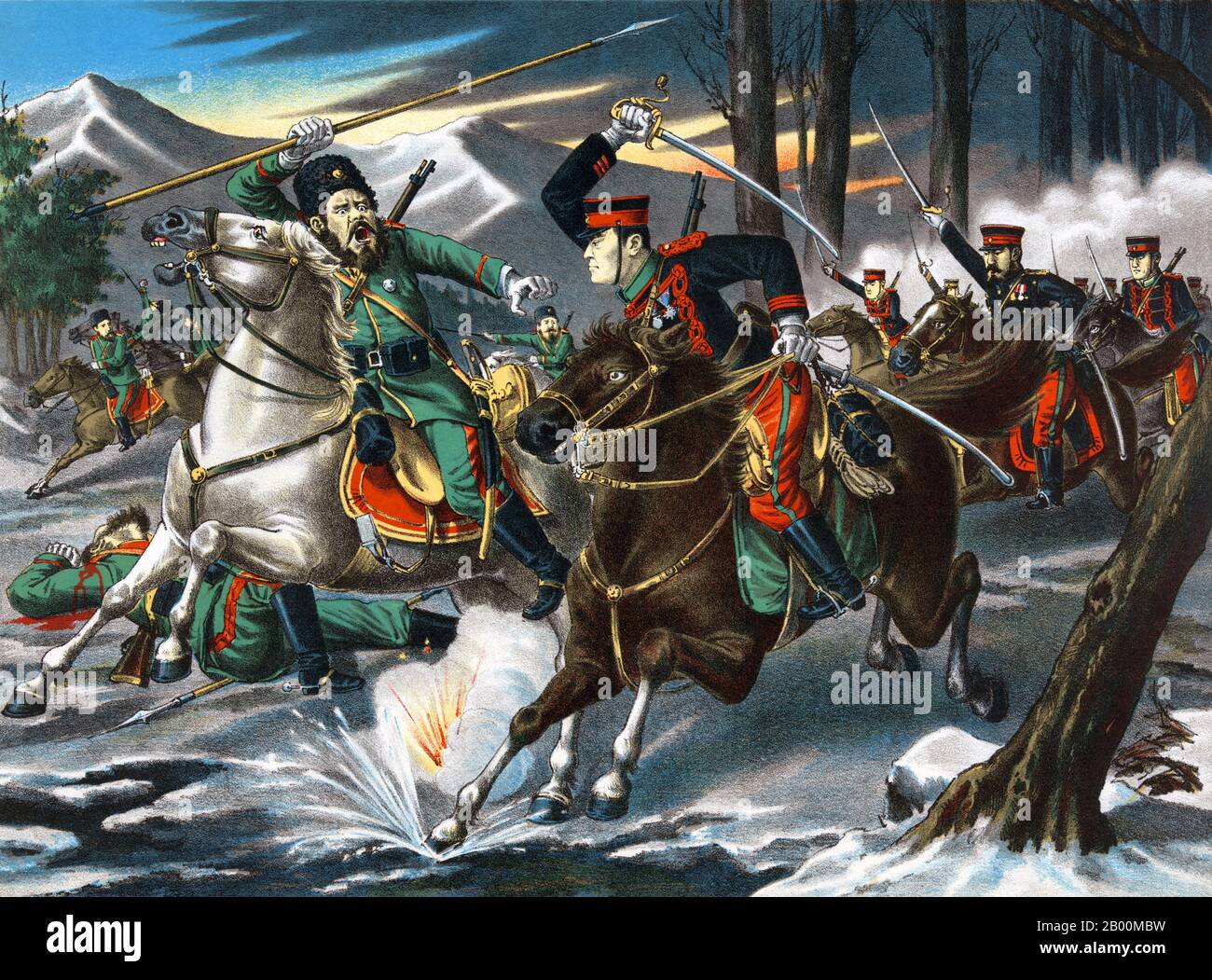 Korea: Japanese and Russian cavalry troops clash near Chonju, North Pyongyang Province, 1904, (Russo-Japanese War, 8 February 1904 – 5 September 1905). The Russo-Japanese War (8 February 1904 – 5 September 1905) was the first great war of the 20th century which grew out of the rival imperial ambitions of the Russian Empire and Japanese Empire over Manchuria and Korea. The resulting campaigns, in which the Japanese military attained victory over the Russian forces arrayed against them, were unexpected by world observers. Stock Photohttps://www.alamy.com/image-license-details/?v=1https://www.alamy.com/korea-japanese-and-russian-cavalry-troops-clash-near-chonju-north-pyongyang-province-1904-russo-japanese-war-8-february-1904-5-september-1905-the-russo-japanese-war-8-february-1904-5-september-1905-was-the-first-great-war-of-the-20th-century-which-grew-out-of-the-rival-imperial-ambitions-of-the-russian-empire-and-japanese-empire-over-manchuria-and-korea-the-resulting-campaigns-in-which-the-japanese-military-attained-victory-over-the-russian-forces-arrayed-against-them-were-unexpected-by-world-observers-image344223373.html
Korea: Japanese and Russian cavalry troops clash near Chonju, North Pyongyang Province, 1904, (Russo-Japanese War, 8 February 1904 – 5 September 1905). The Russo-Japanese War (8 February 1904 – 5 September 1905) was the first great war of the 20th century which grew out of the rival imperial ambitions of the Russian Empire and Japanese Empire over Manchuria and Korea. The resulting campaigns, in which the Japanese military attained victory over the Russian forces arrayed against them, were unexpected by world observers. Stock Photohttps://www.alamy.com/image-license-details/?v=1https://www.alamy.com/korea-japanese-and-russian-cavalry-troops-clash-near-chonju-north-pyongyang-province-1904-russo-japanese-war-8-february-1904-5-september-1905-the-russo-japanese-war-8-february-1904-5-september-1905-was-the-first-great-war-of-the-20th-century-which-grew-out-of-the-rival-imperial-ambitions-of-the-russian-empire-and-japanese-empire-over-manchuria-and-korea-the-resulting-campaigns-in-which-the-japanese-military-attained-victory-over-the-russian-forces-arrayed-against-them-were-unexpected-by-world-observers-image344223373.htmlRM2B00MBW–Korea: Japanese and Russian cavalry troops clash near Chonju, North Pyongyang Province, 1904, (Russo-Japanese War, 8 February 1904 – 5 September 1905). The Russo-Japanese War (8 February 1904 – 5 September 1905) was the first great war of the 20th century which grew out of the rival imperial ambitions of the Russian Empire and Japanese Empire over Manchuria and Korea. The resulting campaigns, in which the Japanese military attained victory over the Russian forces arrayed against them, were unexpected by world observers.